


We left the relative familiarity of Beijing Capital International Airport and piled onto our plane to Pyongyang. Welcome to Air Koryo, North Korea’s national, and only, carrier. In May, this same flight had made an emergency landing after one of the flaps fell off the wing. Last summer, it made another emergency landing due to unexplained smoke in the cabin. Air Koryo was only recently allowed to fly in the EU again after being banned for years due to countless safety violations. We buckled in and waited to find out what the world’s only one-star carrier had in store for us.
The only way to visit North Korea is on a state-sanctioned tour. I’d never taken a group tour before, but was immediately in awe of our diverse and absurdly well-traveled group. Four Americans, three Australians, two people each from New Zealand, France and the UAE, and cagey loners from the UK, Poland, Switzerland, the Netherlands and Mexico. Several members of the group had been to over 100 countries each. I was by far the least traveled person there, even compared to the 20 year olds. Shockingly, people don’t tend to pick North Korea as one of their first international travel destinations.
Beijing being Beijing, we taxied on the runway for 45 minutes before taking off. More than one person fell deeply asleep and woke up thinking we had arrived in Pyongyang, only to realize we hadn’t actually taken off yet. Right about when we started to think this was all just an elaborate practical joke and North Korea doesn’t actually exist, we finally lifted off into the bleary Beijing sky.
We’re going to North Korea!
Screens drooped out of the ceiling and treated us to a flight safety video clearly filmed on a consumer-grade camcorder from the mid-1980s. Ha ha, this is funny-wait guys are we all going to die? Seriously, you can tell me.
I distracted myself from all these quirky portents of doom by chatting with my new British friend Nancia in the next seat over and spilling airport peanuts all over the floor. We were presented with customs forms to fill out, declaring any books or magazines we were bringing into the country. You didn’t want to bring anything about North Korea into the country. They’re really self-conscious. I turned on my Kindle and methodically deleted all the books about North Korea I’d been reading to prepare for the trip, then turned on my iPad and deleted all the North Korea documentaries I’d been watching. The Interview? Jesus, how do I still have The Interview on here?
We hit a pocket of light turbulence and the North Korean sitting across from me horked lustily into his air sickness bag. I’m getting the impression that North Koreans don’t get to fly a lot.
The oddly lit safety video was followed up by a performance by the Moranbong Band, North Korea’s answer to the Spice Girls. The band’s members were chosen by Kim Jong Un himself, and enjoyment was mandatory. I knew that with their skirts and short hair, the band was considered progressive by North Korean standards, but I could only tell because I’d read that before the trip. What I caught in distracted snatches was like a fever dream about watching the Kennedy Center Honors on valium. Is the wing vibrating?
The stewardesses came by with our choices for dinner: mystery meat burgers or air. Urban legend had it that the burger patties were compressed pucks of chicken. They smelled like the dumpster behind a Burger King. Pass oh god pass. I instantly formed judgments about my fellow passengers who did eat them. This was the last Western food I’d see for ten days.
Ninety short -what was that sound?- minutes later, we touched down in Pyongyang and streamed gratefully off the plane. Holy shit, we’re in North Korea.
I heard this question a lot in the weeks leading up to my trip. It’s really sort of a personality test, either it’s self-evident to you that this would be a fascinating place to visit, or you think the idea is completely crazy and will never think any differently. The latter is a good indicator that you’re American.
Americans have a unique perspective on North Korea, and by unique I mean deliriously fearful and under-informed. Most of this is because of Otto Warmbier.
Warmbier was an American college student who visited North Korea in 2016. The last night of his trip, after an escalating series of drunken dares, Otto snuck onto a very clearly off-limits floor of the Yanggakdo hotel and stole a propaganda banner off the wall. Departing the next morning, Otto realized the banner was too big to fit in his luggage, so he abandoned it in his hotel room and checked out. The perfect crime!
Otto was quietly arrested at the airport, made a very clearly coerced confession at a televised press conference a month later, and after a one-hour trial that included video footage of him taking the banner, was sentenced to 15 years in prison.
None of this is good, and that’s a very long sentence for decorational larceny. Otto’s entire story is terribly sad. It’s also the responsibility of anyone traveling to understand the culture and the laws of the place they’re visiting. Most Americans would have little empathy for a Dutch or Portuguese person sentenced to 15 years in jail for using drugs in America, yet we tend to expect a get out of jail free card when it comes to any foreign laws we don’t agree with. Fifteen years is indeed an insanely long time, but what most don’t realize is that North Korea has a long history of handing down long sentences to foreigners for effect, then quietly releasing them a year or so later.
Before April of this year, I’d had no idea that people could even travel to North Korea, especially Americans. The more I read about the country, I became fascinated by the idea and began planning a trip to see the celebrations for Kim Il Sung’s birthday in April of 2018. I want to see the entire world before I die, and to experience as many foreign cultures as possible. They don’t come much more foreign than this.
Then in June, Otto Warmbier was unexpectedly released back to the US. He was in a coma. The North Koreans said he’d had botulism. US officials said he’d been tortured and beaten. Doctors who examined him said there was no evidence of either. The media in the US went absolutely bonkers.
A week later he died.
I don’t think anyone will ever know for sure what really happened to Otto. The American Matthew Miller spent nearly a year in prison in North Korea and reported being treated very well, actually staying in a hotel for most of this time there. Foreigners certainly don’t experience the hell on Earth that North Korean prisoners suffer through. My opinion, based on the circumstances and the amount of time his brain went without oxygen, is that Otto probably tried to hang himself. I don’t think he realized he was likely to be released well before his 15 years were up. Which is all terribly sad.
The American media was covering this story like Otto had been kidnapped and the various legal issues were just some bullshit pretense to give North Korea a pawn with which to extract political concessions from the US. The State Department was flat out stating this as the truth, and telling Americans in no uncertain terms not to go to North Korea.
None of this made any sense to me. If they were just arbitrarily kidnapping Americans, what about the hundreds of other American tourists who travel to North Korea every year? What about the other Americans on his tour? Why just take Otto? There are plenty of Americans in prison in other Asian countries, why aren’t we freaking out about them?
At this point it started to become clear to me that the US was going to ban travel to North Korea by the end of the year. I moved up my timeline and started planning for a trip in September. That was going to be pretty quick after my July trip to Japan, but I didn’t want to risk waiting any longer since this was likely my last chance to see the country.
Soon after, the various tour companies that travel to North Korea announced that they’d stopped accepting Americans. Some, temporarily while they reviewed the situation, some permanently. Americans took this to mean the State Department’s warning was right. North Korea is kidnapping Americans and holding them for ransom! Everyone I talked to from other countries uniformly suggested the reasoning was more like Americans are terrible at following rules and don’t think foreign laws apply to them.
Either way, all I could do was wait.
While I was in Japan, the tour company I wanted to go with finished their review and began accepting Americans again. Hooray! I got home from Japan and as if on cue, the US government promptly announced that they’d be banning Americans from visiting North Korea starting September 1st. Goddammit. I scrambled and landed a booking on the last long tour in August, just under the tour booking deadline. My North Korean visa came through just hours before my flight.
A few people in my life totally got it and were excited for my trip. Others were completely convinced that I was kidding and wasn’t really going. Some still don’t believe I went. Eventually I just stopped telling people I was going to North Korea. I told some people I was going Korea and just let them assume I meant South Korea. For others, I decided the best time to tell them I was going to North Korea was after I was already back safely. This seemed kinder than letting them lose their minds for two weeks.
I quizzed the rest of my tourmates on how their friends and families had reacted to the news of their trip. Aside from the French guys, who hadn’t told their parents they were going, everyone else was surprisingly mellow about it. It was considered an odd destination for sure, but nothing near the levels of fear and loathing prevalent in the US. And these weren’t uninformed people. This is why I travel, you can’t know your own country is weird and crazy until you get outside of it.
Part of the joy in meeting my tour group was hanging out with 16 people who didn’t think I was crazy for wanting to see North Korea. Most of them would answer the question above the same way I would:
Why wouldn’t you want to see North Korea? Aren’t you curious about the world? What’s wrong with you?

The Pyongyang airport is cleaner and more modern than you’d expect. It’s also utterly empty.
Everyone official in North Korea wears amazing hats. They’re huge and tall and seem to be getting taller by the year. They say you can tell the degree of a dictator’s detachment from reality by the size of their hair (see Nicolae Ceausescu). I think this theory may also apply to hat size.
The immigration officer peered up from under his giant hat and implied that I was lying about who I was. “Name?” “Sean Traverse.” “...” “Uhm?” “...Matthew?” He’d caught me in a lie, I hadn’t said my middle name! This seemed funny for a second until I realized that Koreans go by three names, seemingly all of the time. Leaving out my middle name surely seemed as strange to him as including it would seem to me. “Yeah dude, Matthew.” I need to stop calling North Koreans dude right now.
I also need to stop calling it North Korea. We’re in the Democratic People’s Republic of Korea. It’s neither democratic nor a republic, but that’s not important right now. To them, there’s only one Korea, its bottom half is just sadly being occupied by American imperialists at the moment.
Going through customs, the officials x-rayed my bag and then took out my phone, Kindle and iPad. They took one look at them, didn’t turn them on, and handed them back to me. So much for a thorough vetting of my e-books and media. I went through the metal detector and the attendant stopped me. Oh shit.
“What’s this?” he gestured, pointing at my chap stick.
“Chap stick? Lip balm?”
Nothing. I mimed smearing it on my lips.
He looked at me like I’d just admitted to wearing lipstick and took the cap off the tube. Hmmm. He frowned and handed it back to me, waving me on to go live my life of degenerate transvestitism somewhere else.
We piled into the bus and pulled onto the empty road, passing a large mosaic mural of Kim Il Sung and Kim Jong Il. Oh man, I wish I could take a photo of that. We passed one of the only billboards in North Korea, advertising a DPRK made car, the Pyeonghwa Hwiparam (“Peace Whistle”). After years of only making knockoffs of foreign cars, in 2000 the DPRK partnered with Pyonghwa Motors, a South Korean auto company owned by Moonies, and began to produce about 300 original cars per year. Private vehicle ownership in the DPRK is very rare, and the few people with money prefer foreign cars anyway, so the point of the billboards seemed to just be a morale boost for the population. Man do I wish I could take a photo of that.
We’d been briefed before the trip on what we could and couldn’t take photos of while in the DPRK. The rules were more permissive than most assume, the only hard and fast rule was no photos of anything military. That includes soldiers, or construction, since the massive North Korean army isn’t really an army, it’s just a bunch of people in uniforms that the government uses as a free manual labor for their construction projects. Since every third person in North Korea is in an army uniform, it can be tough to take photos without accidentally getting a soldier in there somewhere, but they were generally pretty mellow about this. Other photo restrictions come up on a place-by-place basis, sometimes seemingly made up on the fly by our guides.
Only minutes into the country, we were all on our best behavior and eager to not end up in jail or to get our guides sent to a labor camp. I decided to test the waters. “Wait, can we take photos from the bus?” I asked our guide. “Yeah, sure.” What?? You’ve never seen a dozen people get velcro burns from whipping out their cameras so fast to take blurry photos of absolutely everything our bus bounced by on the rough, pothole-infested road.
Curiosity was at an all-time high. “What’s that roller coaster?” “That’s the-” “Never mind, what’s that huge building shaped like Saturn??” “That’s the Three Revolution Exhibition.” “Okay I don’t know what that means what’s that building shaped like a Devo hat?”
Pyongyang has a lot of very oddly shaped buildings.
One of the oddest is the Ryugyong Hotel, whose name means willow tree but which looks like a giant pyramid from Mars. Construction began in 1987, but paused during the country’s near-collapse after the fall of the Soviet Union in 1992. After a brief 16-year hiatus, during which the building sat empty with no windows, exposed to the elements as its construction cranes rusted, construction picked up again in 2008. It now has windows, but remains unfinished on the inside. Our guides told us it would be finished soon, but EU inspectors reportedly declared the building irreparable in the 90s, citing the low quality of concrete used and the crooked elevator shafts.
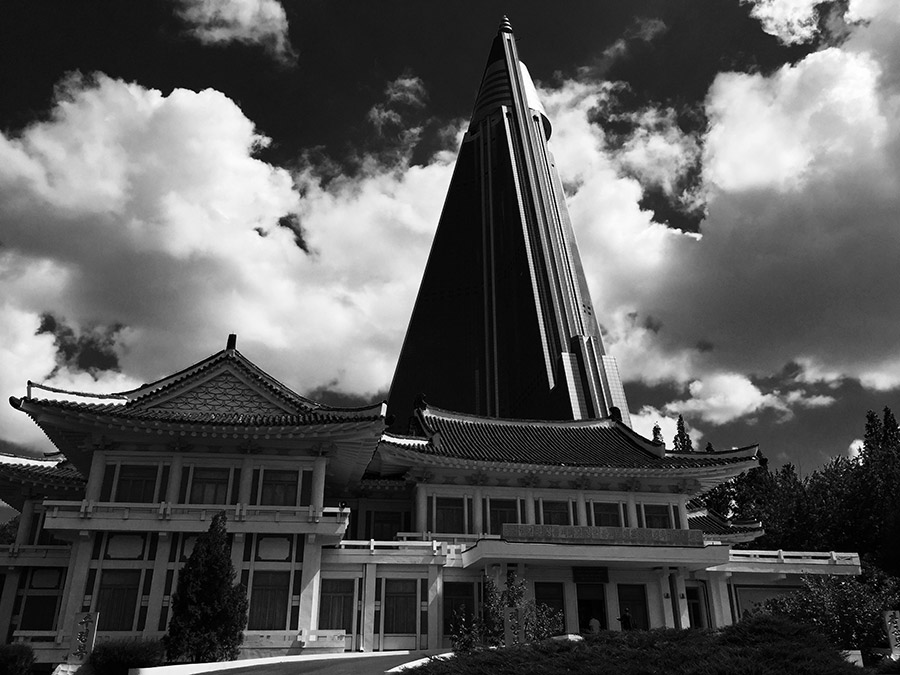
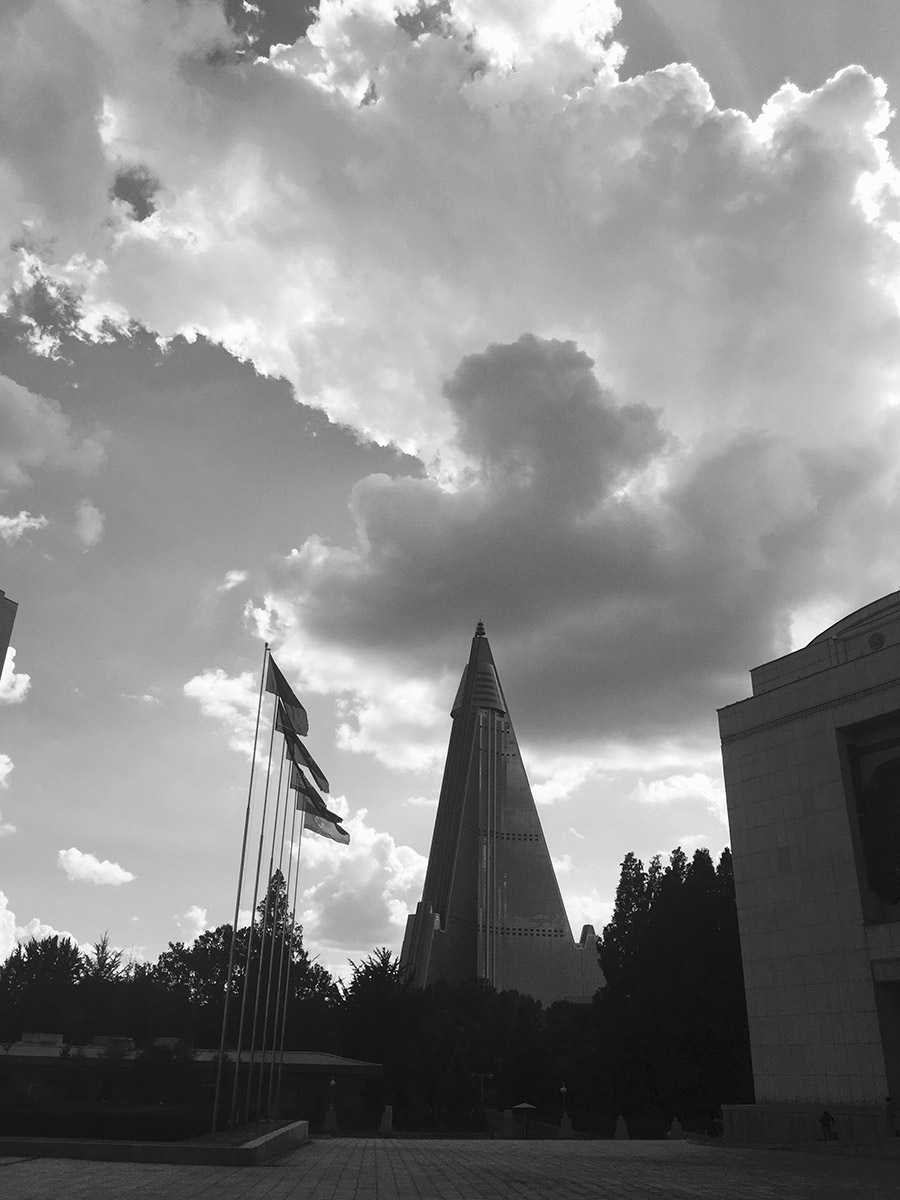
I honestly don’t know which side is closer to the truth, since if the trip taught me one thing, it’s that if you have to choose between what the West believes about the DPRK and what the DPRK says about themselves, the correct answer is usually that they’re both way off.
Traffic within Pyongyang was heavier than I expected. Much lighter than I’d expect for a city of 2.5 million people anywhere else, but hardly the empty streets I’d heard stories about. The vast majority of the people rode buses and the metro, walked, or biked, but there were enough cars that the traffic lights didn’t seem like a waste of electricity. Thankfully the DPRK hadn’t taken the existence of traffic lights as a sign that they no longer needed the traffic ladies who stand in the intersections and signal in tightly choreographed movements for cars to go or stop.
Some of the traffic ladies were men.
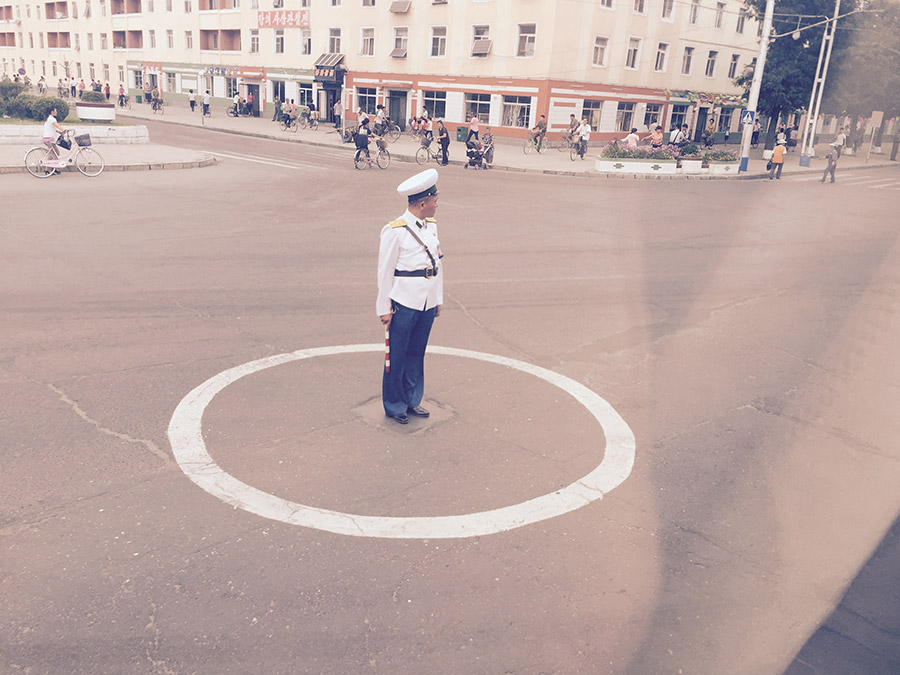
Occasionally one of the traffic ladies would salute a car that was going by, which seemed to indicate an important car and made me curious how they knew which cars were important. This led me down the rabbit hole of understanding DPRK license plate colors. Most of the license plates are blue, indicating the vehicle is owned by a state-owned company. Military vehicles have black plates. Privately owned vehicles have yellow plates, and foreigners get green plates. At least I think this is the run-down, I asked each of our guides about this and got different answers from each one. To make matters worse, they had completely changed all the colors last November. Once I finally got all this memorized, I started watching to see what color plates the traffic ladies were saluting. It didn’t matter what the color was. Either they had the important cars memorized or they were just fucking with me.
As it began to fall dark, it became hard to tell which stores were open and which were not. Contrary to popular belief, the DPRK is not pitch black at night. They have lights. But each store we drove past seemed to have one single light on inside, raising the question of if they were open or hosting some kind of vigil.
Eventually we reached the Yanggakdo, the DPRK’s first luxury hotel and largest hotel overall, sequestered on an island in the middle of the Taedong river.
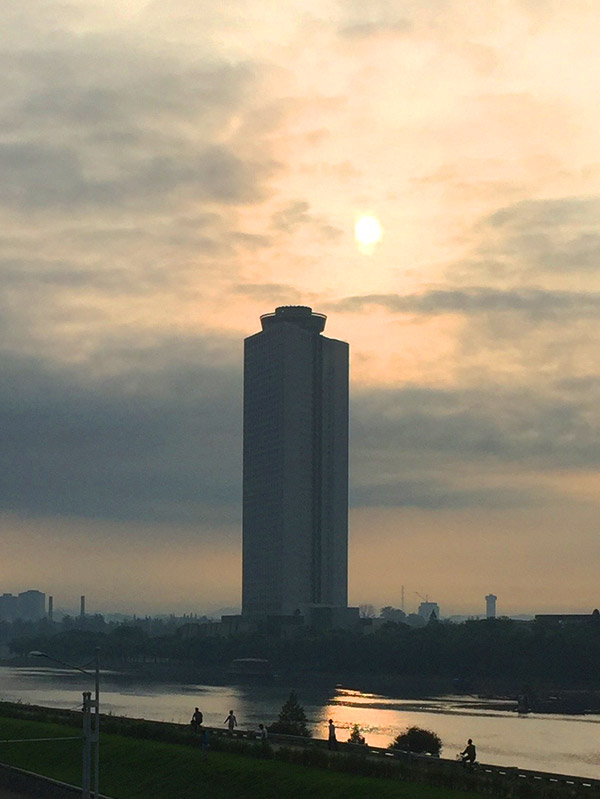
It was never clear if all tourists are required to stay in this one hotel, or if all tourists just happen to stay in this one hotel. The island compound certainly seemed like a convenient way to keep tourists from wandering off. It felt a bit like being under house arrest, as you’re allowed to wander freely within the hotel (as long as you stay off the forbidden fifth floor, and stay out of the stairwells) but it was unclear how far outside the front door you could walk before apes on horseback would lasso you.
The lobby of the Yanggakdo is pretty nice, if a bit dated. There are sharks in an aquarium because of course there are.
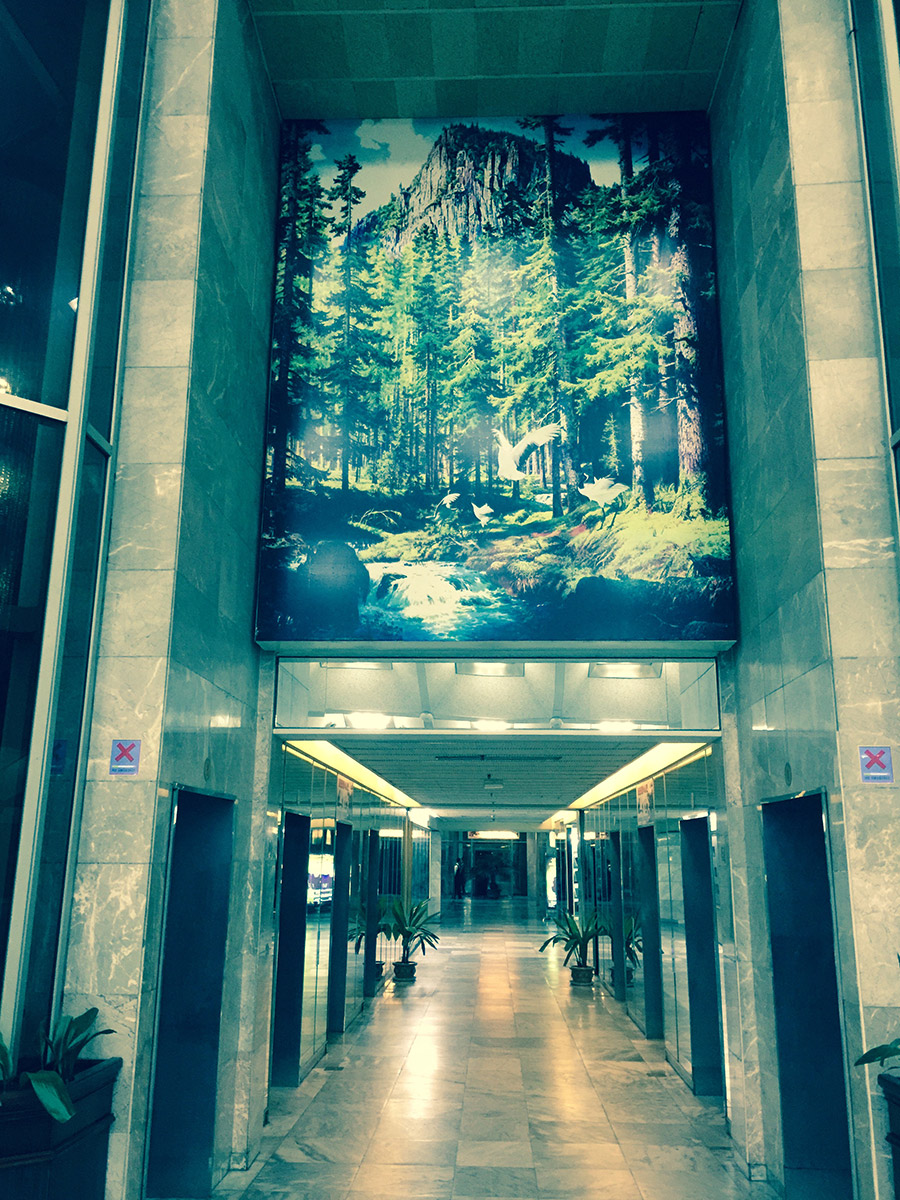
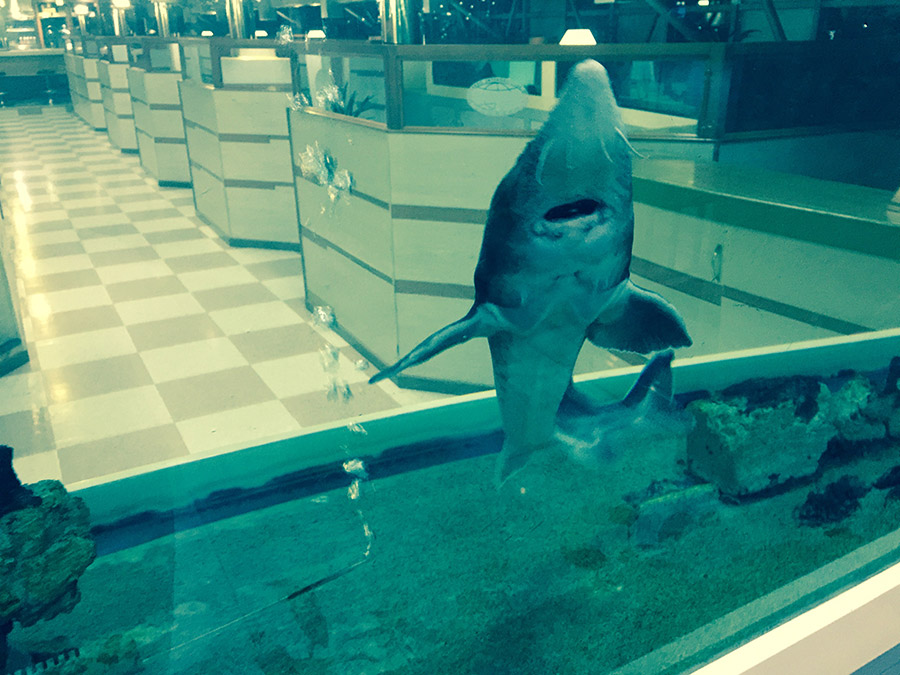
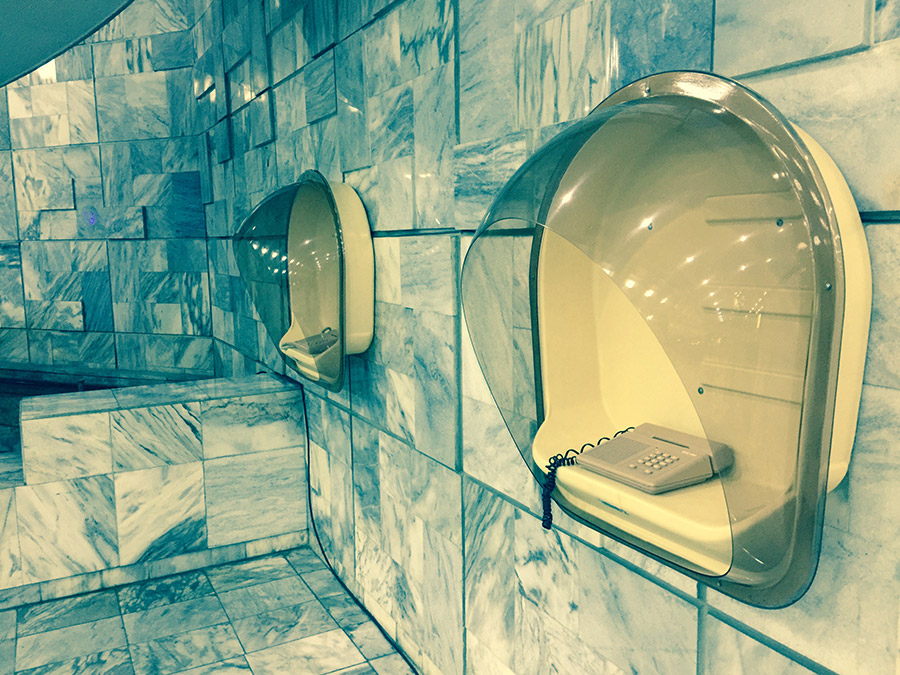
They handed out our room key cards (one per room, even if you’re two adults who just met and who may, you know, have differing plans for the evening) and I headed off with my new roommate Julien, a big teddy bear of a Dutchman. It was unclear how many of the eight elevators in the lobby were actually in service, but one eventually arrived to take us up. We didn’t know yet that the elevators on the far end were the ones you wanted, for their majestic cracked-glass views of Pyongyang from above. Stepping into the elevator, we noted the lack of a button for the forbidden 5th floor. “Was that where Otto Warmbier stole the poster?” “I don’t want to find out.” A cooking show played on the tiny TV screen inside the elevator. Man, they really want to remind us how much food they have. Stepping out of the elevator on the 39th floor, the hallway smelled musty and the carpet was clearly original from 1986.
The electronic lock on our door wheezed when I inserted the key card. After a few more attempts we received the green light and the door swung open. Wow. This room smells like a wet dog’s asshole. Closing the warped door behind us took a fair degree of gumption.
The room layout and decor was fairly standard for a Super 8 in Omaha. I’ve read online that rooms at the Yanggakdo go for $350-$500 a night. I’m so, so sorry to anyone who has ever actually paid that. I have to imagine our tour company was paying closer to Motel 6 rates.
I’d heard that the rooms in the Yanggakdo are bugged, and I’d also heard that that’s silly, only the phones in the rooms are bugged. If they are bugging the rooms, they have a really high tolerance for me talking shit about Kim Il Sung way louder than I meant to.
I sat down on my bed and paused. The bed was damp. That’s a first. Was it just some weird wet-feeling satin material? I pulled back the blanket and felt the sheets. Damp. “Hey Julien, is your bed damp?” “What? Oh God. Yes. It is.”
I thought back to the single light on in each shop on the drive over. “I wonder if they don’t have enough electricity, so maybe they take the bedding out before it’s 100% dry?” It was already time to go down for dinner so we figured we’d give the beds a couple of hours to dry out.
We sat down in the dining hall and I asked everyone at the table if their beds were moist. They all looked at me like I was absolutely insane. Guess not. A television on the wall played footage of missiles launching, artillery firing and soldiers lustily charging up a hill on a constant loop. This was kind of unnerving to eat to. Some variation of this was playing everywhere in the DPRK though so you sort of got used to it.
Meals in North Korea go like this: They bring you a dish. You don’t know what it is. The waiters speak no English. You may try some of it, you may not. They bring another dish. This repeats for about two hours. You’re never sure how many dishes are coming or if they will ever stop. Whenever they did stop bringing dishes, I was never sure if that was planned or if we had just offended them somehow.
Since you’re getting about a dozen different dishes every meal, it seems like you’re getting a lot of variety. But the Twilight Zone twist is that it’s the same twelve dishes every single meal, three times a day. This gets old by the end of day one.
How was the food? We had a running joke on the trip that our Yelp review was something like “It’s not terrible!” or “Could have conceivably been worse.” It wasn’t good but there was lots of it.
After dinner we hit the bowling alley downstairs.
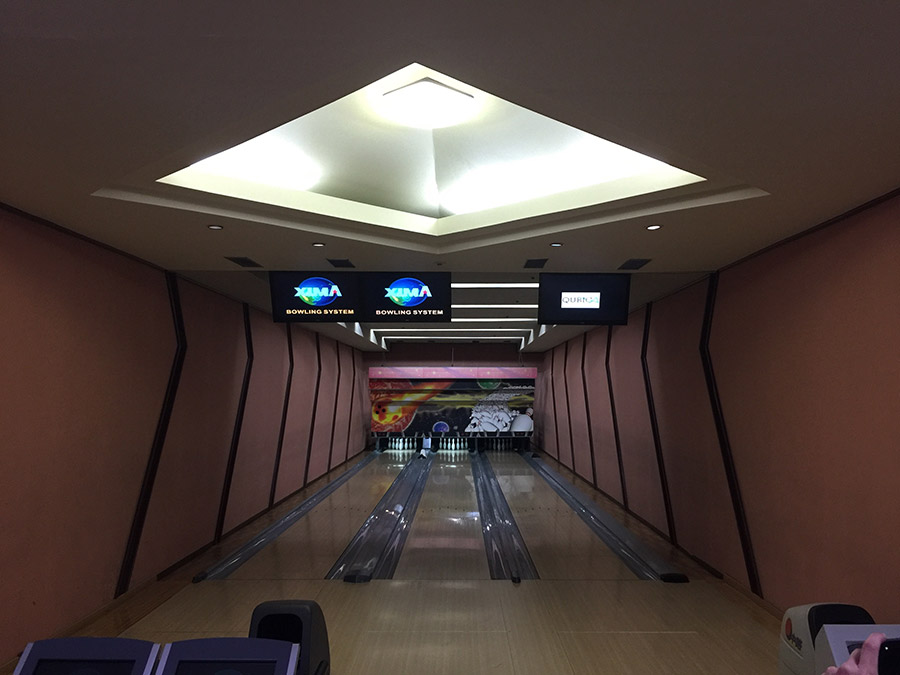

The ceiling in the basement was exactly 6’3” high, so I was fine as long as I didn’t walk into a smoke detector or a sprinkler head. I’m kidding, they don’t have fire sprinklers in the DPRK.
It was very surreal to suddenly be bowling in a basement in North Korea. Part way through our first game, we realized none of the balls we were bowling were coming back, and eventually we ran out of balls. One of the finely-dressed Korean ladies who was waiting on us walked up the side of the lane in her high heeled shoes, opened a little door, and disappeared into the bowels of the bowling machinery. We didn’t see her again and began joking that she was back there setting up the pins by hand.
Eventually the balls came out all at once and we resumed the game. Every time a ball hit the pins and whatever was behind the pins it sounded like you’d thrown an anvil onto a pile of typewriters. I have no idea what was going on back there. One of the Korean ladies was standing right next to the far end of the lane, overseeing things, and I was basically just waiting all night for Julien to take her out with one of his errant high-speed tosses.
After several hours, everyone tired of this bloodsport and the giant Korean beers and we headed off to bed. We returned to our room eager to turn in after a long day and- Goddammit I forgot the beds were wet. Still wet, nothing had dried. I started to suspect that the air conditioning was blowing wet air into the room, making everything damp. We headed down to the front desk and began the very long process of explaining to the hotel staff that our beds were wet.
After about an hour of explaining and re-explaining how a bed could be wet, the staff calling our guides, the staff taking a smoke break, on and on, eventually they gave us the key card for a different room. The- the next room over from our current room, I realized with a deflated sigh. If the air conditioning is blowing wet air it’s probably not just doing it in that one room.
We got up to our new room and surveyed the damage. On the positive side, this room didn’t smell like Swamp Thing’s dick. On the negative side, the beds were wet in this room too. Not quite as wet, so we were trending in the right direction. It was also after midnight and the chances of getting yet another room seemed very remote. Fuck it, I guess we’re sleeping in wet beds.
I would not recommend this at all. I pulled on a long-sleeve shirt and crawled into bed. As I closed my eyes I thought about mold and tried to remember what Brittany Murphy died of. My last thought before falling asleep was about how, after all the fears everyone back home had about Americans getting thrown in prison or all-out nuclear war, how ironic it would be if I died of mycotoxin poisoning from a shitty North Korean hotel. Good one, DPRK!
Q. What’s with all the nukes and the threats and stuff?
A. The most important thing to understand about the DPRK is this: Everything in the DPRK exists to keep Kim Jong Un in power. That’s the sole motivation behind everything they say and do.
When Kim Jong Un goes to bed at night, he doesn’t cackle maniacally and dream of burning the USA to the ground. He has nightmares about Saddam Hussein at the end of a rope and Muammar Gaddafi being torn apart by a mob. Those are the two fates he wants to avoid. Saddam Hussein is what happens to dictators when you don’t give the US a very good reason not to invade your country, like “I have a bunch of nukes pointed right at your shit.” Gaddafi is what happens when you can’t convince your own people that they need you, like “The US is coming to eat your babies and only I can stop them.”
We were in the DPRK while the whole Guam/Fire and Fury thing was playing out, and it played exactly the way I imagine Kim Jong Un would want. Here’s another soundbite of Trump threatening to destroy the DPRK! You're welcome! People have asked me if it was tense being in North Korea at that time. Not at all, they believe we’re always on the verge of attacking them so it was business as usual for them.
Here’s how I found out about that whole thing: On day four I turned on Al Jazeera in our hotel room. They were showing footage of the Charlottesville riots and an angry mob pulling down a statue of a confederate soldier. “Jesus Christ, what’s going on in your country??” Julien asked. “I dunno, I lost the handle on what we’re all about last year.” Then they switched the focus to Trump’s tweets and I realized how nice it had been to not hear about Trump at all for four whole days.
Kim Jong Un’s not an idealist, he doesn’t hate us for our freedom. He doesn’t have a hard-on to end our way of life. He likes having nice stuff and not being dead in the ground.
Kim’s actions aren’t logical if the goal is the health and well-being of the Korean people. But they’re perfectly logical from the standpoint of self-preservation. There’s nothing we can offer him that will convince him to leave himself open to removal at our hands. Sanctions only work as designed if the people blame their leaders for their suffering under the sanctions. The North Korean people don’t blame Kim, they blame the US and believe we’re trying to murder all of them with sanctions.
Do I think there’s any way out of this? Maybe. I think technology and culture will eventually defeat the Kims. They’re failing at keeping information away from their people at an increasing rate. Seeing Western tourists in their streets and meeting Americans who aren’t the devil helps remind them that the world isn’t what they’re told it is (thanks again for the travel ban Donald!) Eventually the people there will realize what they’re missing and oust Kim, if the entire system doesn’t just collapse first. And if the DPRK and US don’t accidentally start a catastrophic war that neither side wants.
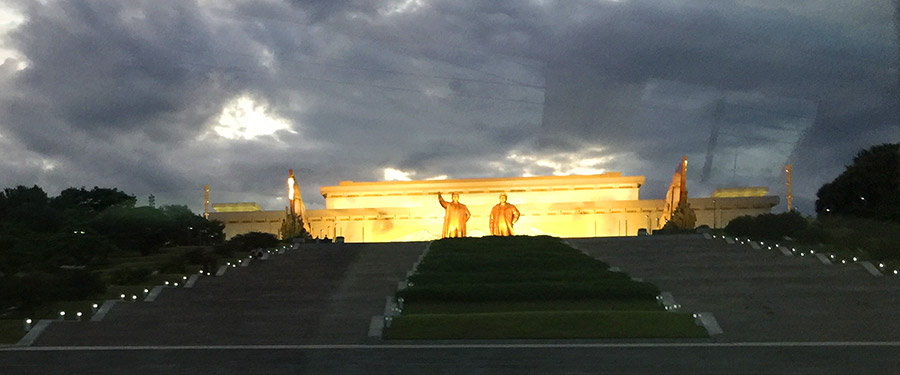
Q. What else isn’t like we think it is?
A. Most of the things we casually believe about North Korea and the Kims are, as far as I can tell, completely made up. As in, a journalist made a joke one time and in the information void that exists around North Korea, it fit what we wanted to believe and so we all just ran with it. Kim Jong Il claimed he invented the hamburger! He says he played a perfect round of golf the first time he picked up a club! North Koreans believe Kim Il Sung never used the toilet and didn’t have an anus!
When I asked North Koreans about these things, they looked at me like I was the stupidest person alive. They’d never heard of any of this. I’ve had people back in the US ask me why I don’t believe they were just lying about this. These are North Korean people who told me absurd things all day long every day. They told us Kim Il Sung designed their hydroelectric dams. Not sounding crazy to Americans is not a real high priority for them, if they even know what we’d think is crazy.
I did find the reluctance of my American friends to let go of some of these ideas to be really fascinating. It was like when people suggested that my photos from the trip made the DPRK look nicer than it really is. Really? Based on what? We have such an unshakable confidence in a worldview that’s been pieced together out of random garbage. Our self-image as savvy and informed people dies hard.
Not that the DPRK makes it easy. The Democratic People’s Republic of Korea is essentially a feudal state that’s secretly capitalist, claims to be socialist, and is perceived from the outside as communist. No part of the country’s own name is true.
That being said, the biggest way I see Americans misreading the DPRK is in our attitude toward the Kims. As we tend to do with any dictators we disagree with, we picture them as stark raving mad, and a little silly. This is an entertaining way of looking at things, and I guess comforting in the sense that we never have to question our own positions if we just decide that anyone who sees things differently has to be crazy.
I don’t think any of the three Kims are or were crazy. All three of them had the primary talent of being ruthless as fuck. Kim Jong Il was also kind of a genius.
Kim Il Sung was the “founder” of the DPRK. I put “founder” in quotes because the hardest thing to figure out about the DPRK is how legitimate Kim Il Sung was or was not. To the North Koreans, he was a heroic rebel who led the fight against their Japanese oppressors, defeated them, founded the DPRK, and essentially built their country into greatness single-handedly.
Who was he really? Aye yai yai. The harshest reading is that he wasn’t even actually Kim Il Sung at all. Some believe that he was an opportunist who took the name of a real rebel named Kim Il Sung who had died fighting against the Japanese. There’s evidence both for and against this reading. The most commonly accepted position is that he did actually fight the Japanese, winning some fairly inconsequential battles. The Japanese were defeated by the Americans and USSR, and when the Soviets needed someone to install as a figurehead for the newly-created country, they chose Kim. Was he anything more than a puppet of the USSR? Kim was too weird. He may have been a Muppet of the USSR.
However he managed to luck into this position, Kim quickly solidified it by ruthlessly isolating and killing off every possible rival he had in the DPRK, and then ruled the country for the next 48 years.
Kim Jong Il had a problem. The leadership of communist countries isn’t supposed to progress from father to son, and no one expected him to take over the DPRK after his father died. He correctly observed that his father’s greatest weakness was flattery, and proceeded to launch a campaign of flattery unprecedented on Earth. All of the massive cult of personality we see in the DPRK today, all the statues and murals and stories of how Kim Il Sung invented everything that’s good and defeated everything that’s bad, that was all Kim Jong Il’s doing. He flattered his dad so hard the whole country bought into it and became a Kim Il Sung cult. And Kim Il Sung couldn’t think of a better person to succeed him than the fantastic son who had helped everyone realize he was the shit.
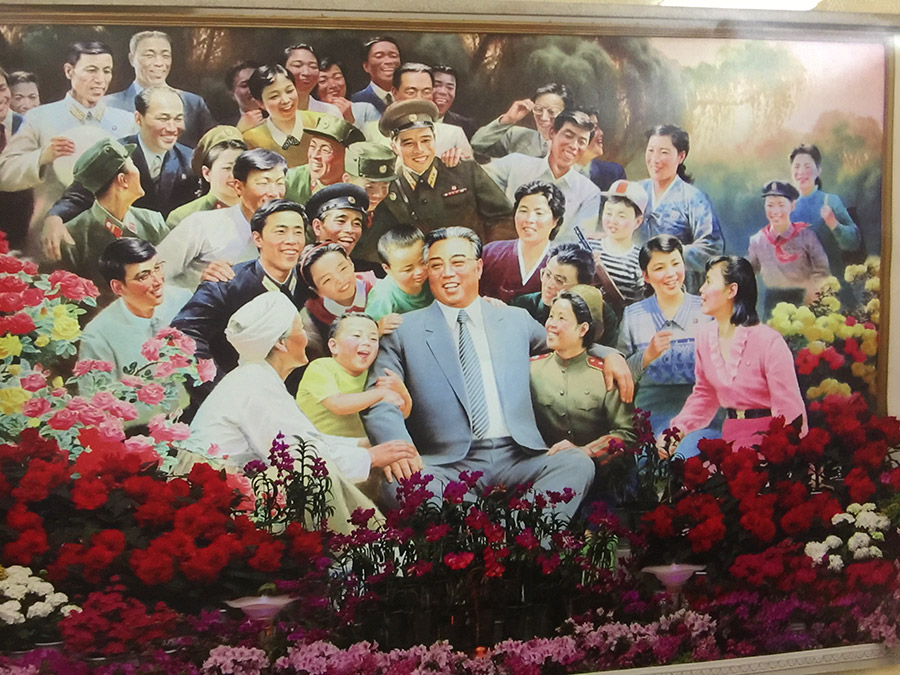
Kim Jong Il ruled the country for 17 years before dying unexpectedly in 2011, leaving his youngest son Kim Jong Un to basically luck into the role of Supreme Leader. He wasn’t the oldest son, but the oldest son had been dropped from the line of succession after embarrassing the family by trying to sneak into Japan on a fake passport to go to Tokyo Disneyland. Kim Jong Un had his older brother killed this February at an airport in Malaysia, when two North Korean agents smeared VX nerve agent on his face in broad daylight. Un wasn’t the middle son, either, but the middle son was dropped from succession by their father for being secretly gay. That left Kim Jong Un.
One of the peculiar things about DPRK propaganda is that you see images of Kim Il Sung and Kim Jong Il absolutely everywhere, but almost nothing for Kim Jong Un. He’s barely even spoken of. Due to the hinky line of succession and Kim Jong Il’s unexpected death, the North Koreans were left with a leader they’d barely even heard of before. The propaganda machine hadn’t had time to catch up.
Kim Jong Il left behind a complicated governmental structure that his son isn’t completely in control of. In 2013, Un had his uncle Jang Song Thaek executed as a power-consolidating move. Some Western media reported that Song Thaek was torn apart by dogs, but this detail seems to have been made up.
Q. Wait so North Korea is nice and stuff?
A. I think that life in the DPRK is decent, though still restrictive and backwards, as long as you’re a loyal party member in good standing living in Pyongyang. If you’re living out in the country, life is way harder than it needs to be. And if you’re one of the 120,000 North Koreans who have ended up in the country’s prison labor camps, the DPRK is the single worst place in the entire world.
The DPRK has regular prison camps, which is where you go if you slap a traffic lady or steal a ham. These are pretty terrible but you’ll probably get out one day. You’re not treated well at all, but you’re still considered a member of the DPRK and have some very basic level of human rights. They make an effort to rehabilitate you.
Then there are the camps for political prisoners, which are the great majority of that 120,000 total. You end up here for defying the Kims in any way, shape or form. Like saying “You know, Kim Jong Un might be too young to lead the country,” to your wife when no one else is around. This is Kim’s first, second and third line of defense against a revolution. How can you organize a revolt when speaking even modest criticism means your neighbors or family members will report you and you will disappear forever?
Until very recently, not only you but three generations of your family would all disappear in this scenario. You’d all go into the labor camps for political prisoners, where you are no longer considered a human being. You’re not there to be rehabilitated, you’re sent there to die. The populations of these camps are generally steady as people die at about the same rate that new prisoners arrive.
According to former guards who defected from the DPRK, in these camps any guard can kill you at will at any time. Women are raped regularly by guards, if they resist they’re simply killed. The tiny rations mean most prisoners starve to death. Those who survive are the ones who are able to catch rats and bugs to eat. The prisoners are forced to work in mines with no safety equipment, if there’s ever a problem they just seal up the mine and let everyone inside die. Others work in factories where prisoners are maimed and killed in accidents daily.
And you don’t get out. There’s no end to the sentence of not being a person any more.
Q. So how did the DPRK get to where it is now?
A. After the Korean War basically flattened both countries, the North did better than the South on into the 1970s. During the colonial era, the Japanese had built most of Korea’s industrial infrastructure in the north, in part to facilitate trade with China. The south was used as farmland. This gave the North a big head start when the country was divided, and the South suffered from political corruption and turmoil for decades. The North also benefitted from heavy support from both the USSR and China. Through the 1970s, the Chinese living near the border envied the standard of living their neighbors in the DPRK enjoyed.
Things began to wobble in the mid-70s. In the 80s, South Korea democratized and their nation took off, growing today into the world’s fifth-largest export economy. The North went the other way, suffering a series of disasters throughout 1990s. The Soviet Union collapsed in 1991, and few expected the DPRK to survive the evaporation of Soviet aid. In 1994, Kim Il Sung died. Heavy flooding in the following years led to massive famines during which hundreds of thousands of North Koreans starved to death. This collapse was dressed up as the “Arduous March” by the government, referring to a Kim Il Sung’s legendary guerilla campaign against the Japanese. Though the country eventually recovered, the relationship between the government and the people never did. Government food rations never returned to sustainable levels and the people had to learn to fend for themselves. A large black market arose, with the majority of the population taking part in a tolerated but technically-illegal capitalist marketplace just to survive.
A huge discrepancy arose between the official exchange rate for the North Korean won and what the currency was actually worth on the black market, to where someone would work at their state-assigned job and be paid 2,000 won a month, which in reality was only worth about 40 cents. Power in families switched from the husbands to the wives, since the husbands were required to work their assigned jobs for essentially nothing, while the wives were free to operate businesses on the black market and earn the money that was actually feeding the family. Corruption grew rampant as people bribed their way out of their assigned jobs (taking a long sick leave, etc.) and bribed the police to ignore their illegal businesses or to allow them to defy travel restrictions in order to trade.
In 2009, Kim Jong Il’s government began to fear the growing power of private traders in the DPRK, so they devalued the currency. Overnight, the last two zeros on every bill were cancelled, so a 1000 won note became a 10 won note, wiping out private wealth. This lead to North Koreans allegedly burning piles of won in protest, a significant offense since Kim Il Sung’s face was on those bills. This, in a country where it’s illegal to even fold a newspaper with Dear Leader’s picture on it. Since 2009, faith in the won has eroded and foreign currencies have become standard.
North Koreans are now making money smuggling in contraband from China. What kinds? For one, radios that can receive South Korean or Chinese radio stations (radios that are officially sold in the DPRK can only tune in North Korean stations). South Korean cosmetics are also very popular.
More significantly, South Korean shows, movies and music are increasingly popular in the DPRK. For years, DVDs of South Korean shows and movies were available on the black market. The problem with this was that if you were caught watching them, you could be sent to a labor camp. It was a risky proposition since the power goes out frequently in the DPRK, so you could be left with an illegal DVD stuck in your player that you couldn’t eject until the power came back on. The police would intentionally cut the power to apartment buildings and go door to door, checking what was in the DVD player in each home. The popularity of these shows and movies exploded with the advent of portable, battery powered DVD players and then USB flash drives. A flash drive was much easier to conceal and could be watched on a laptop in private.
Today, the majority of the country is consuming some kind of contraband media. Friends will feel each other out by repeating catchphrases from the various South Korean shows they’re watching, forming an illicit bond if the other person gets the reference. Women have begun to copy South Korean fashions they see in shows and movies. Jeans are forbidden in the DPRK due to their association with America, but women will wear black jeans, at night, under a long overcoat. Tailors in the DPRK covertly recreate and sell the fashions seen on South Korean shows and movies.
Government control has been eroding so quickly that only Pyongyang remains in the kind of “police state” that used to characterize the entire country. Outside of Pyongyang, neighbors and family members no longer report on each other for crimes of disloyalty. The police have had to abandon the practice of imprisoning three generations for one family member’s crimes.
Only a tiny number of government officials in North Korea have access to the internet, so it’s a bit baffling to see people in Pyongyang carrying smartphones. It turns out these access the country’s internal intranet instead, where they can download the daily paper and “google” a database of government-approved information. Cell service is so expensive and cell phones have become such a status symbol in Pyongyang that some people actually carry fake cell phones. I sincerely hope they dispense gum.
One of the most surprising things I learned about North Korea is that they have a huge meth problem. Through the early 2000s, the DPRK had huge state-run meth factories that flooded methamphetamines into China. It was a major export. China eventually told them to knock it off since everyone in China was getting addicted to meth, so the government shut down the factories. Which were almost instantly restarted by private businessmen, who are usually government officials working for their own profit on the side. In the meantime, defectors have estimated that 80 percent of the DPRK population uses meth on a daily basis, to the degree where it’s not even considered a drug.
So those masses of goose-stepping DPRK soldiers that you’re afraid are mindless brainwashed robots who are going to take over the world? Relax. They’re just a shitload of methheads with guns.
Our first full day in Pyongyang is a bit of a blur in my memory. Most of the days were simply full of too much to fully absorb, between taking in what you were seeing and trying to figure out what it was supposed to mean and how much of it was real. The guides kept trying to teach us Korean, day after day, but utterly failed. I’m convinced this was because after all the second-guessing we simply didn’t have any cognitive firepower left over for language acquisition.
Pyongyang is nicer than you think. The streets are very clean. This is the city for the elite of North Korean society, those most loyal to the party. It’s a lot like the capital city in the Hunger Games books, these are all the fancy freaks eating bon bons while all the other dirty slobs are out trying to build a highway with a few rocks and a hammer.
Every morning of the trip I would wake up and unlock my phone, pause a second, laugh and then lock it again. Smart phones are surprisingly useless when there’s no cell signal and no internet.
I see myself in an underground tunnel where Kim Il Sung operated during the Korean War, the low ceiling tickling my scalp. The guides are telling us the 17 things women need to be to be good. They showed us a telephone the soldiers had made out of random scrap parts. Outside, the cicadas shrieked and I tried to explain to Julien was a cicada was.
I’m standing in the square in Pyongyang where the DPRK has their big parades, the only footage of North Korea we ever see on television the US.

Whenever you see the soldiers goose-stepping up the street behind giant rolling rockets and tanks, behind them there’s a crowd holding up colored cards that form some giant pictorial slogan in Korean. I’m standing where they hold up the cards. The square is empty, and on the ground there are blotches and lines that tell the people where to stand and hold up their cards.
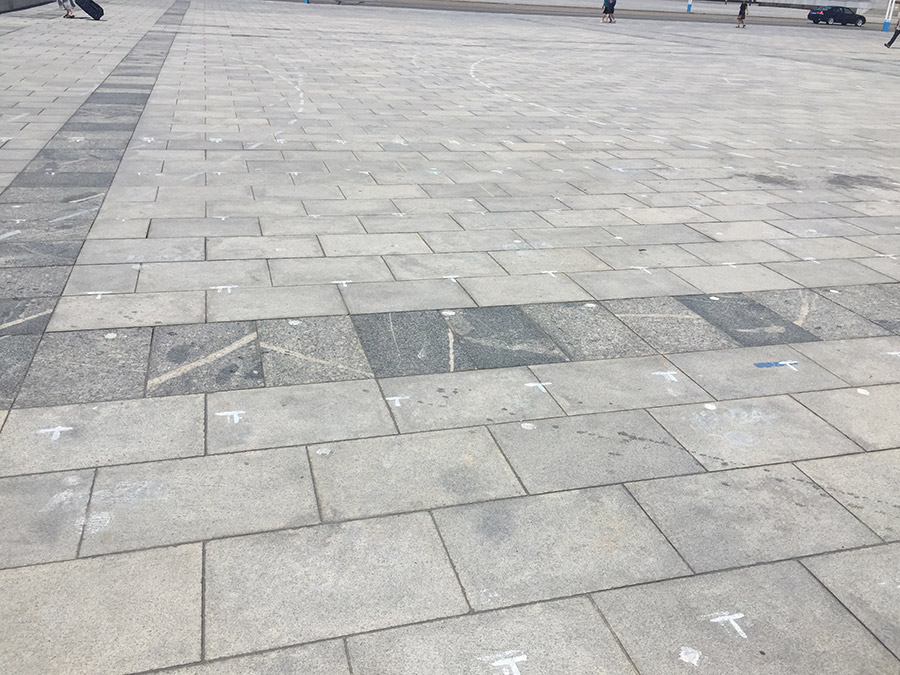
Across the square there’s a building with a white horse in front of it. I ask the guides if I can go take a photo of the horse. Sure. When I get over there, it’s a bizarre stuffed horse that I’m guessing kids sit on. I secretly hope that it comes to life if you put a magic hat on it. Inside the building, there’s a wedding.
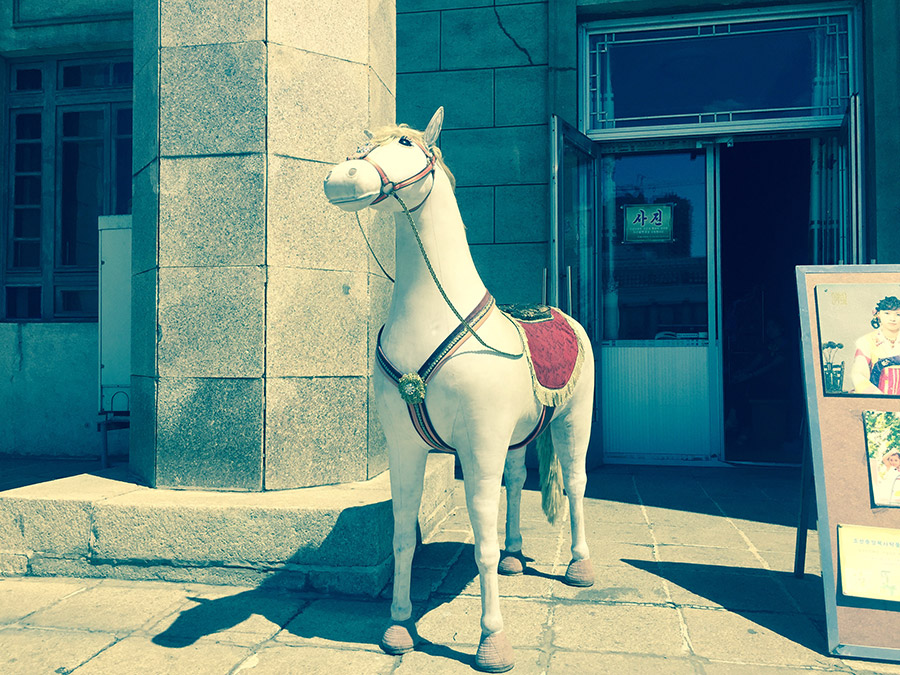
When I turn around, everyone is gone. I’m alone in this vast open square in Pyongyang and I’m not sure where my group went. This is the thing that absolutely is not supposed to ever happen in the DPRK and it’s morning #1. The sun shines down and I enjoy an unsupervised moment. I wander around for a while and eventually find my group in the art museum across the street.
I’m getting images of being in more than one not very impressive art museum. We theorized that the good stuff had probably been sold off under the table. But the one thing that stuck out vividly was a life-sized golden statue of Kim Jong Il with a spaceman. It drew us across the room with its mesmerizing incongruity. I so badly wanted to take a photo of this thing, and spent at least an hour trying unsuccessfully to find a picture of it in the bookstore later that day. Kim Jong Il stood there proudly with the astronaut, and I’m sure one of them was pointing to the sky. Why a spaceman? This is so awesome-
“Guys, that’s a pilot,” Julien burst our balloon and deflated all of the magic out of the room instantly.
Hmm. He did have a pistol. Maybe it was a pilot. A pilot with an elaborate jumpsuit and an oxygen tube. But that helmet. That’s a pretty spacey helmet. Nope, I’m going to go to my grave believing that’s Kim Jong Il’s armed space friend that only he can see.
On the way out we passed a painting of a bunch of Korean miners way down in a hole, waist-deep in water. They were all smiling and really happy about their situation. Yeah, that seems realistic.
I’m wandering through some kind of embroidery compound, I realize in retrospect it seems like such a thing couldn’t exist, but it did. It wasn’t quite a museum, wasn’t quite a school, but there was a ton of shit being embroidered:

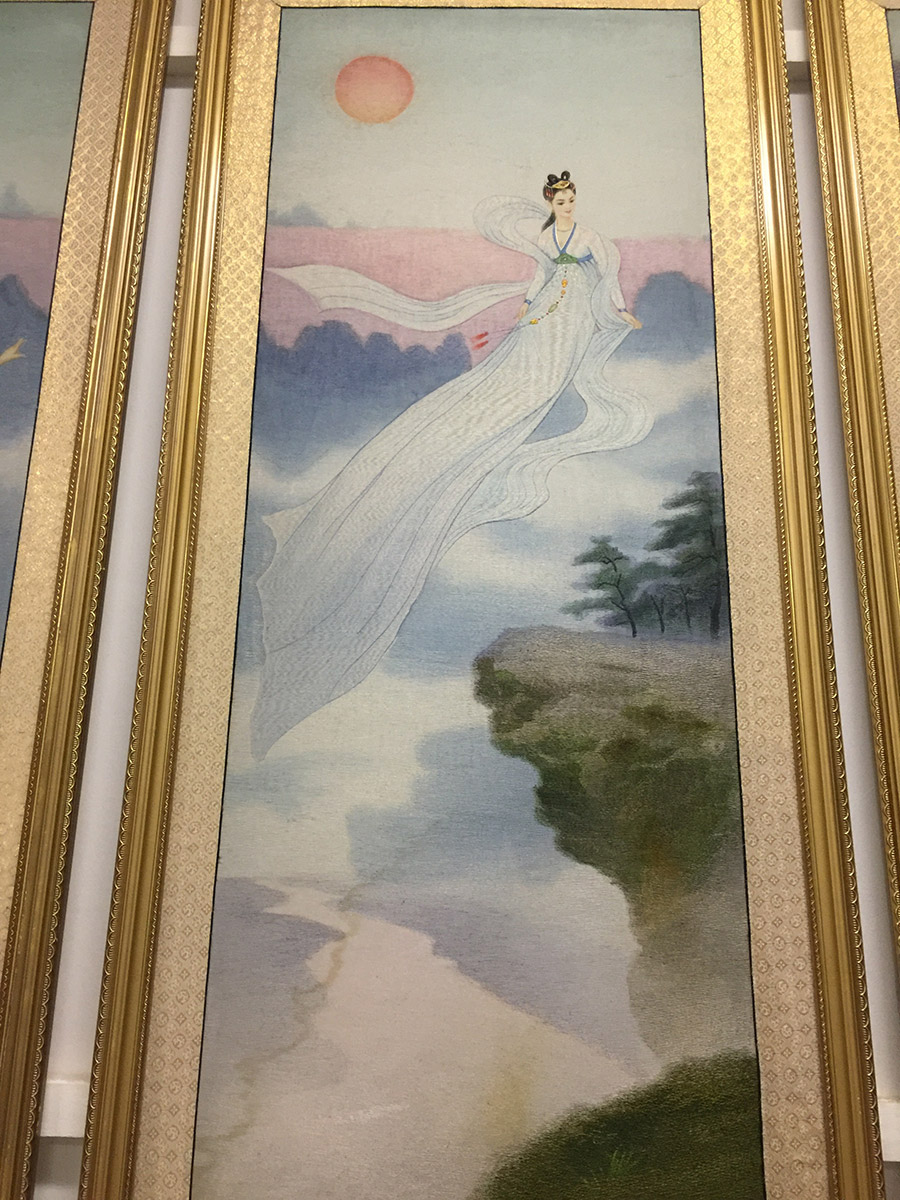
In the middle of a demonstration of some insanely detailed embroidered scenery, we experienced our first North Korean power outage. The building suddenly went dark for about twenty minutes, and then life carried on. The power would go out every day or two the rest of the trip, usually in the middle of the night. You might only find out because your phone wasn’t as charged as you expected when you woke up in the morning, or you got up to go to the bathroom and there were no lights so you had to go in a dresser drawer. Don’t tell Julien I said that.
In a stamp store now. It’s not clear if this is a stamp store or stamp museum, but either way they have a lot of crazy stamps. We’re perplexed by all the stamps featuring US Olympic athletes, the DPRK’s mortal enemies:
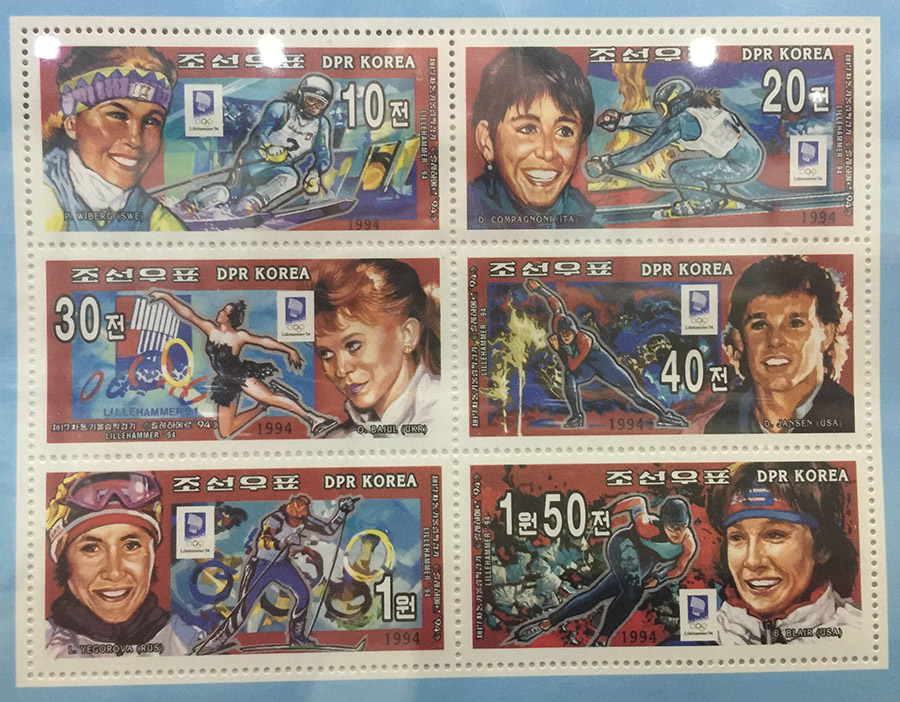
I love that they have a ton of dinosaur stamps. Others are harder to decipher:
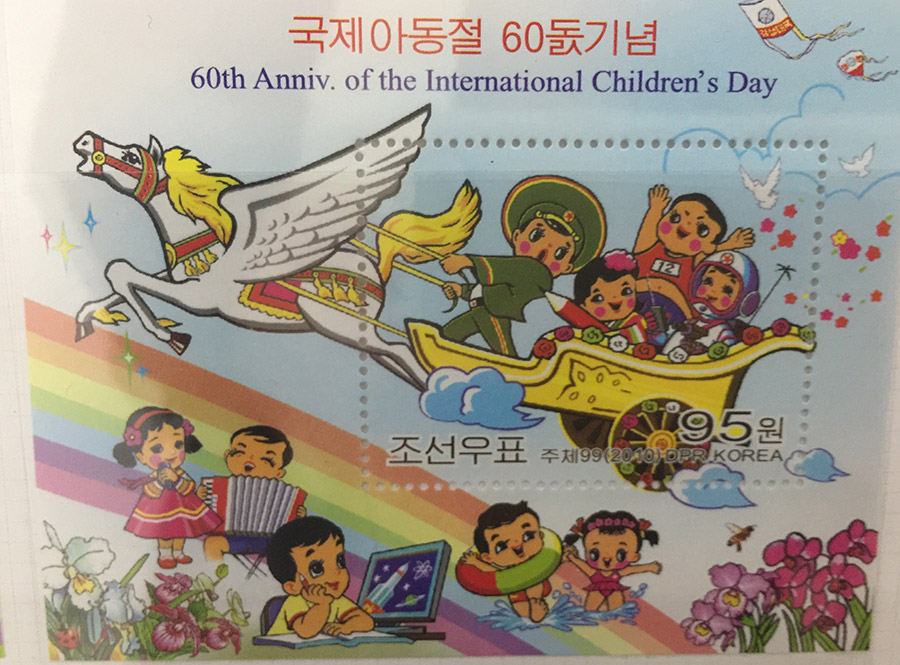
We’re walking down the street in Pyongyang in a not particularly tight group. Nancia and I are talking about Americans’ limited conception of socialism and her experiences living in southeast Asia, and our Korean guide is eavesdropping on our conversation hard. There’s a van on the street blasting some kind of propaganda, which morphs into a surreal echoing web of music as we cross through an underpass beneath the road. I’m remembering reading about the North Koreans having mandatory speakers inside their homes that broadcast propaganda, right next to the required portraits of Kim Il Sung and Kim Jong Il, which the police periodically inspect for cleanliness. Some of our tourmates shared stories of being woken up that morning by a broadcast of strange music emanating out from the city.
We’re about to board a vintage trolleybus from the 1960s. The driver uses a long hook to attach leads from the top of the bus to wires spanning the street. It’s explained to us that all the stars stamped on the side of the bus represent how long it has been since that bus has been in an accident, so North Koreans look for buses with lots of stars. Was each star a day, or a year? God, I hope they’re each a year.
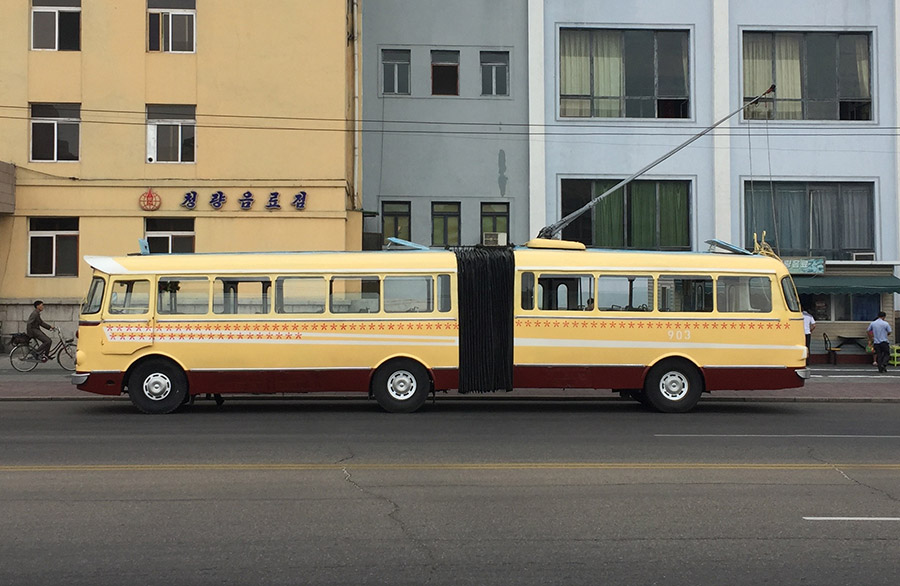
I’m pointing to the pin our guide wears on her lapel, which features the face of Kim Il Sung. Every North Korean wears a Kim face pin, some of the pins have both Kim Il Sung and Kim Jong Il. No one had a pin of Kim Jong Un. I asked why. She explains that the powerfully humble Kim Jong Il would not allow North Koreans to wear pins with his face on them while he was still alive, despite their fervent desire to so demonstrate their love. “Oh, so will you start wearing a Kim Jong Un pin after he dies?” She seemed uncomfortable that I had brought up the possibility of Kim Jong Un dying, which is probably dangerously close to treason, then suggested that only time will tell.
I’d heard mixed things about whether or not non-Koreans could acquire one of these pins. Before the trip I’d read that you could only get one by proving your love of the Kims. I’m not sure how you prove this, if you have to sleep with an ugly Kim cousin or what. We saw some foreigners wearing the pins in the hotel and caught word that you could essentially bribe your way into one for a few hundred dollars. At one point I asked our senior guide if foreigners could acquire one of the pins and he explained that it required a ton of paperwork. When I got home I found out you can buy them on eBay.
One of the most surreal places we visited in the DPRK was the Victorious Fatherland Liberation War Museum, their monument to what they’re taught was their great success in the Korean War. Even the logic of the name is difficult to parse, and one of those things the North Koreans just tune out when you start asking questions.
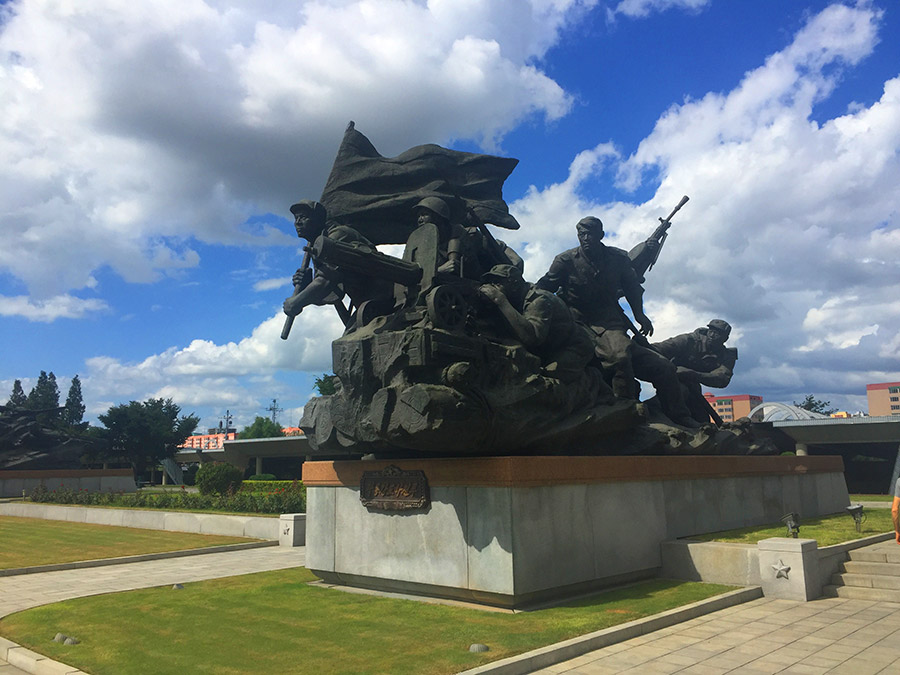
A little Korean War background, as I did not know most of this before I started researching Korea in preparation for my trip. Following the Russo-Japanese war in 1904, when the two countries fought over who would control Korea, the nation was a colony of Japan until 1945. In the waning days of WWII, the USSR declared war against Japan and invaded Korea. This, in conjunction with the US bombings of Hiroshima and Nagasaki, led to Japan’s surrender.
With Japan out of the picture, the US and USSR were left with the task of what to do with Korea, and they arbitrarily decided to split the country at the 38th parallel, with the USSR administering the northern half of the peninsula and the US the southern half. In 1948, separate governments were formed, with the USSR installing Kim Il Sung as the president of the DPRK.
On June 25th, 1950, the DPRK, with support from the USSR and China, crossed the 38th parallel and invaded South Korea. Within two months, the North Koreans had steamrolled the South and held virtually the entire peninsula. In the process, they executed roughly 120,000 North Korean civilians they thought might be sympathetic to the South, while South Korea executed around 200,000 South Korean civilians they thought might have communist sympathies. Not a lot of glory to go around here. The DPRK has a museum in Sinchon blaming the US for all of these deaths.
The UN sent in soldiers from 21 nations, the majority coming from the US, who pushed the North Koreans all the way back to their border with China in the north. A huge number of Chinese troops countered, and the front was pushed back down to the 38th parallel, basically where the war had begun. The last two years of the war were a stalemate, the main effect of which was that the UN forces very heavily bombed the North, completely destroying every city and killing untold numbers of civilians. On July 27th, 1953, an armistice was signed between the North and the UN, bringing an effective end to the war, even though there was never a peace treaty and the North and South are still technically at war today.
In the end, the North had actually lost 1,500 square miles of territory from where they had begun, with the important exception of gaining the city of Kaesong.
On the DPRK side of the looking glass, they’re taught that the North was invaded on June 25th, 1950. Soldiers of the United States’ puppet regime in the South invaded the North as they had always planned to do, but thanks to Kim Il Sung’s National Preparedness Order, the plucky Northerners stopped the imperialist invaders a few kilometers into the country and turned the tables, somehow routing this huge invading force and taking over nearly the entire peninsula within a few months. The rest of their history of the war more or less matches up with accepted reality, though they make all of Kim Il Sung’s defeats and retreats sound heroic and downplay how much help they received from the Chinese. And, they were at war with the United States, not the UN.
When the North Koreans acknowledge the existence of the United Nations at all, it’s to dismiss the organization as a complete puppet of the United States. This is actually quite clever since having the entire free world band against you is more reason for self-reflection than believing you’re fighting to stop an evil imperialist nation that wants to enslave you.
The belief that the US started the Korean War is one of the most unshakable pieces of North Korean propaganda, because so much depends on it. In that world, the North is an innocent country that yearns for self-determination but is constantly being invaded. By Japan, by the US, etc. (they leave out the time that the USSR invaded them). In that world they have every right to build nuclear weapons for their self-defense, to protect them from being invaded again. In that world, the UN sanctions against them are just the US imperialists trying to murder innocent people, not a rebuke of any threat they pose to the rest of the world.
Defectors from North Korea have talked about how accepting the evidence that the North invaded the South was the hardest thing for them to wrap their minds around. It’s that deep in their national psyche. One of the first things our senior guide said to me in our far-ranging conversation on the bus was “You know the US invaded us, right? It’s true!”
Once you wrap your mind around the totality of their belief that they were the victims in the Korean War, you still struggle to understand the Victorious Fatherland Liberation War, as they call it. Wait, victorious? What did they win? The most charitable description of this war would be a stalemate, right? The best answer I got when I asked about this was that they’d foiled the South’s invasion, so that was a victory. I guess. But how is it the Fatherland Liberation War? What was liberated? Either you tried to liberate the fatherland and you lost, or you won a war defending the North from invasion. Which was it? Or was the South trying to liberate the fatherland and you foiled them? That would be weird. This whole line of questioning hit a brick wall of either real or feigned translation difficulties.
This museum was probably the nicest building we were in during our entire time in the DPRK. Countless exhibits provided dubious evidence of the US invasion. Some of the points of evidence were pretty funny, like “The US attacked on a Sunday since no one would believe a Christian nation would attack on a Sunday!” Various quotes from US military documents were provided as further proof. The thing I found the most interesting about these documents was the frequent use of British spellings for words that Americans would never use. An easy enough mistake for a non-native English speaker in the propaganda department to make.
After enough exhibits it all starts to wash over you and I wasn’t even sure what we were looking at by the end. One striking exhibit near the end of the tour featured a huge open field of graves with mannequins representing American soldiers being pecked at by crows. Damn DPRK, that’s some dark shit.
I found the whole thing pretty interesting from a psychological perspective, and didn’t feel the need to argue with the guides, which wasn’t true of everyone in our group. I could understand this though. When you’re in front of the 10th exhibit in a row singing the praises of such and such a glorious young Korean soldier who single-handedly killed 7,000 of the enemy, and you realize that they’re talking about your countrymen and relatives dying, it’s hard not to get a little offended.
The most popular propaganda trope that we heard in the DPRK was about the very young Korean soldier who defeated the enemy. This came up time and time again. He was only 18! He was only 16! There seemed to be an emotional appeal to the innocence and purity of youth prevailing. I was pretty sure by the end of the tour General MacArthur was going to be captured by a 5 year old.
Upstairs we were taken into a rotating panorama room that told the story of the Battle of Daejon. A circular mural of wartime mayhem surrounded us. The round platform we were sitting on rotated slowly as fires and explosions were projected on the mural and the diorama of mannequins and military vehicles strewn between us and the wall. A voiceover told us the story of the bloody battle for the city of Daejon as it was illustrated before us. This was entirely surreal. The battle ended when US Major General William F. Dean was captured by a young North Korean boy. Okay then.
After seeing all the exhibits, we stopped to use the restrooms. They were as nice as the rest of this beautiful building until you got to the sink. I waved my hands under the sensor. No water. I looked over and realized there was a hose snaking out from under the sink that led to a huge plastic tub on the floor, which was about three feet tall. It was full of water. Next to it there was a scoop. I ladled water out of the tub and poured it over my hands. Okay then.
On the way out of the building, I stopped to ask our senior guide a question. It seemed incongruous that they believed America was behind every bad thing that had ever happened in the universe, a country full of baby-killing monsters, and yet here I was. I asked our guide if it made him uncomfortable to have Americans like me on the tour. He explained emphatically that they hate imperialists, not regular American people. I thought of bringing up that all the soldiers twirling their mustaches in the exhibits in that museum were regular Americans who’d been drafted into the army, but these seemed like dicey waters to get into since I had another week in the country and had somehow found myself in the “you’re one of the good ones” camp.
Outside, numerous American tanks, planes and helicopters captured during the war were on display. Many of these were displayed beside huge blown-up photos of the pilots surrendering. One torn-up jet sat next to a large, extremely graphic photo of the pilot dead in the cockpit. “In poor taste” is not really a concept in the DPRK. The vibe of the entire display was definitely “DPRK, The Giant Slayer.”
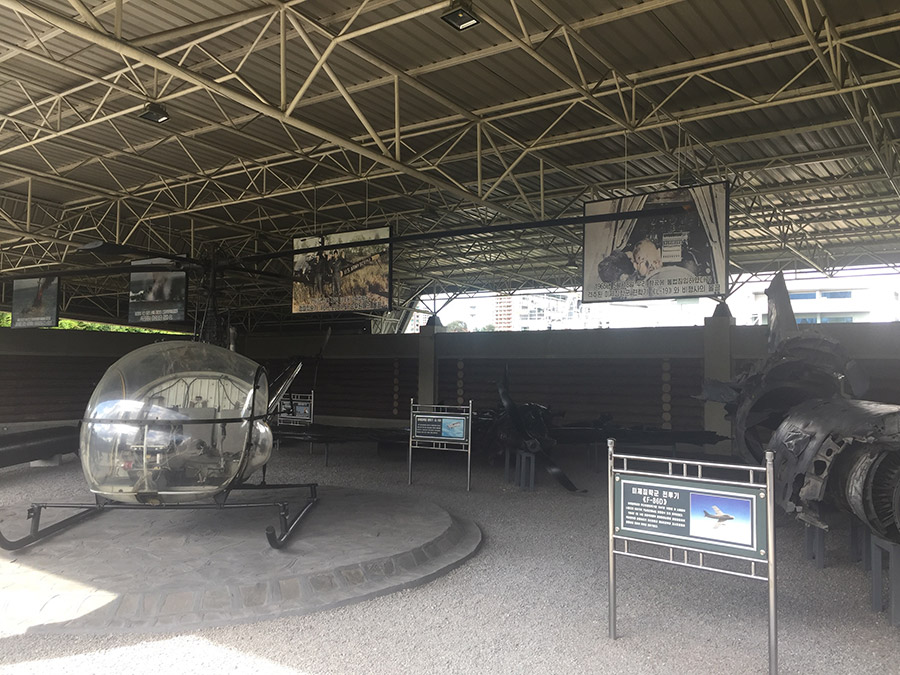
On the waterfront, we boarded the USS Pueblo, an American spy ship captured by the North Koreans in 1968. They were very proud of this. Onboard, we watched an extremely absurd video about the capture of the Pueblo, which was heavy on the horror movie music. It claimed that the spy ship had been disguised as a research vessel as it spied in North Korean waters, but was captured by three brave North Korean sailors in a tugboat or something after they killed one member of the crew. The 82 surviving crew members were held prisoner for eleven months before the US secured their release.
The video had a very funny bit about the Americans’ written confessions, which went something like “I confess to our heinous imperialist acts against the noble Democratic People’s Republic of Korea. We have been treated far better than we deserve.”
The funny thing is when you look at the staged photos of the American soldiers during their captivity, they’re all subtly flipping off the camera. When the Koreans eventually caught on to this, they were told it was a Hawaiian gesture meaning “good luck.”
We were taken into an interior room on the ship and shown walls and walls of electronic equipment. “See! It was a spy ship!” Well yeah no shit it was a spy ship. There’s nothing about this ship, inside or out, that doesn’t scream “Hey, over here! Spy ship!”
What didn’t make sense to me was how an obvious spy ship with 83 sailors on board was taken by three guys without the Americans firing a shot. I mean, I know your hearts are as big as the ocean, Korea, and you fight with the spirit of 100 men, but still. This scenario doesn’t make any sense. If they were sneaking into North Korean waters, wouldn’t they have been a little more ready for a fight?
Once I got home and read up on the incident, it made more sense. The US account, anyway, is that the ship was in international waters when it was surrounded by six North Korean ships and two jets. It’s believed that the ship was taken on orders from the USSR to attain the naval encryption equipment onboard, which was used to corroborate the information being given to the Soviets by John Anthony Walker, a US naval officer who was spying for the USSR.
Two days before the Pueblo was taken, 31 North Korean commandos snuck into the South and attempted to assassinate South Korean president Park Hung Chee in his house, in what came to be known as the Blue House Raid. If I’d known about this at the time I would have liked to ask the guides about this, to see if they have a story about Park Hung Chee single-handedly invading the North.
Our bus bumped along the rough, potholed road on the way out of Pyongyang, headed north. The road was absurdly wide, as wide as the freeways in Los Angeles, but only supported the occasional car. Why were they built so wide? Perhaps they could be used as runways in a pinch? Like everything in North Korea, it seemed like they’d just been built this way for effect. Look at our grand roads! The DPRK philosophy seemed to be to build things as grandly and impressively as possible, and then never spend another cent on maintenance or upkeep. So you ended up with grand marble palaces where the sinks didn’t work and wide expansive roads that were rotten with potholes. Perhaps if they hadn’t made them so wide, they could afford to repave them occasionally?
The thought also crossed my mind that very few people in North Korea have cars, so as long as the bike paths are smooth no one’s really going to care that the roads have a lunar quality to them.
We crossed a bridge and looked at the concrete crumbling alarmingly on the edges of the oncoming lanes. Surely the concrete beneath us was no better.
Leaving Pyongyang we got our first real glimpses of the North Korean countryside. The first surprise is that they have plenty of crops. After reading about the Arduous March, famine, and criticisms of North Korea’s farming policies I expected to see a lot of wasted land, but at least in the relatively flat south of the country, every available square inch seemed to be covered in corn and rice.
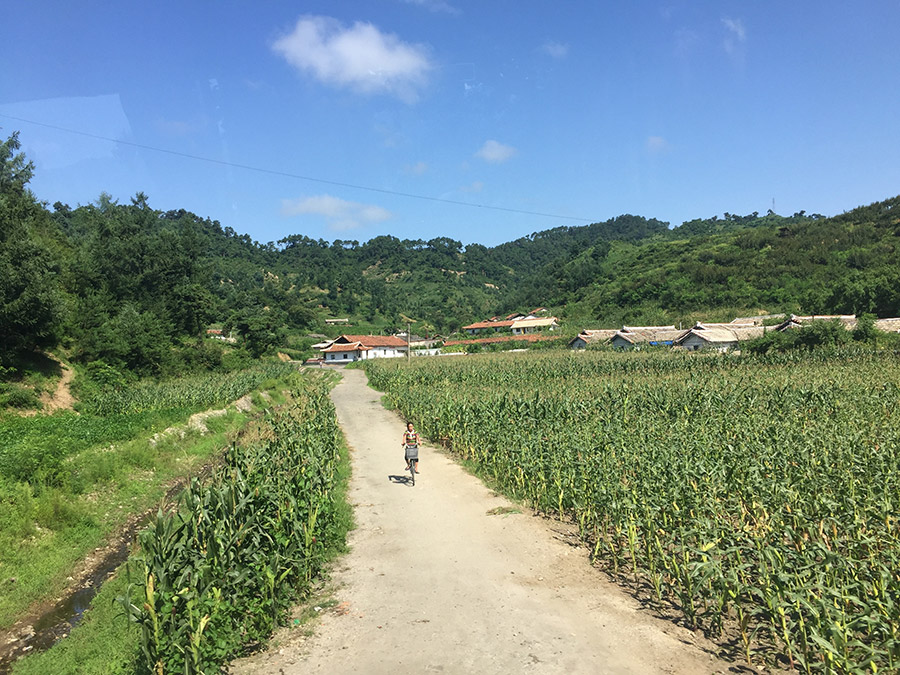
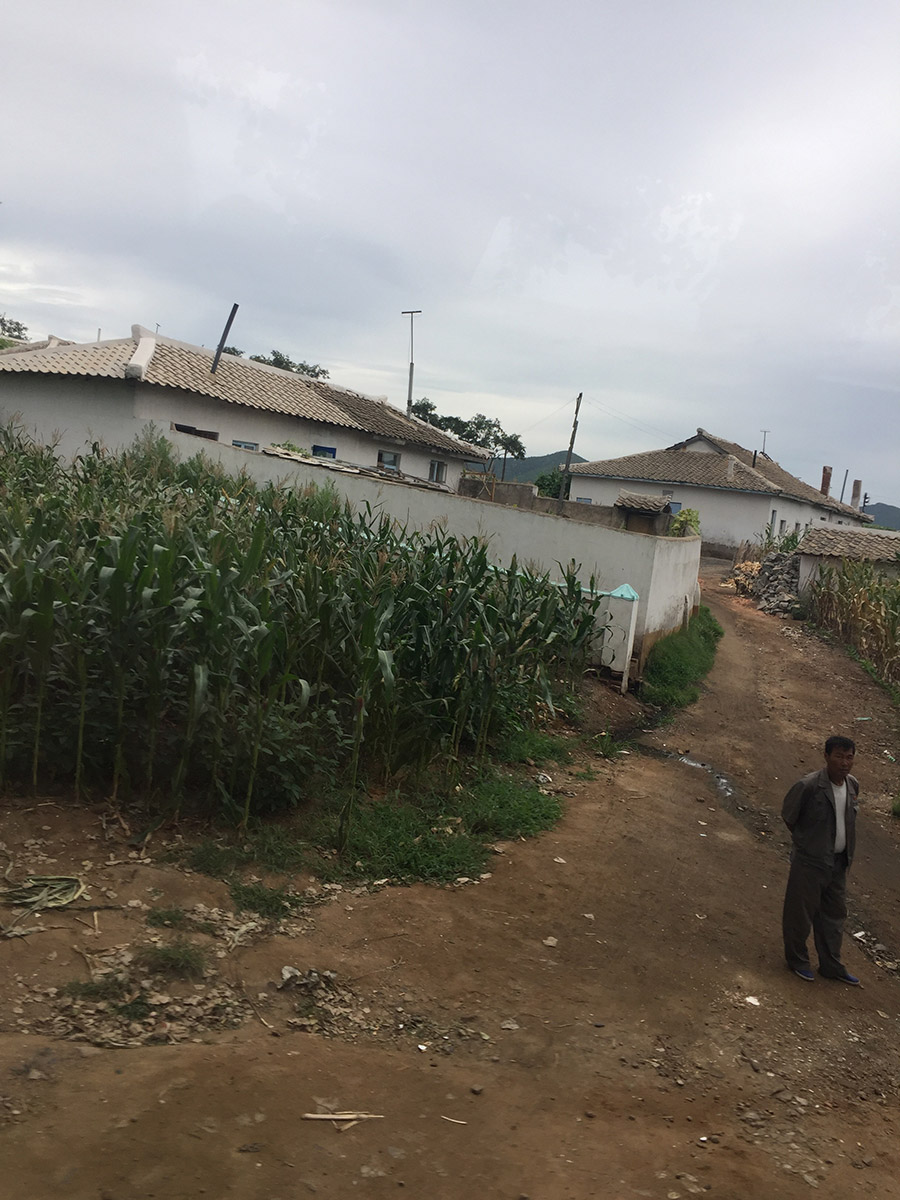

Much of the housing in the countryside was government-issue, either huge apartment blocks or strings of identical duplex houses. Everything had a bit of an old and crumbling feel to it, though it was hard to gauge how badly off the people here were. Surely they were well behind China, and the DPRK is the poorest country in Asia. But I’ve seen people in worse housing in the deep south of the US, and it wasn’t like we were seeing people in mud huts or corrugated tin shanties. The people looked thin, but not emaciated. No doubt their lives were hard.
One of the most consistently striking things I saw in the DPRK was people doing manual labor without any mechanical assistance. Jobs you’d normally see someone do with a backhoe or a jackhammer, in the DPRK there’d be some poor guy out there with a spade or a hammer. Road repairs didn’t involve a dump truck and a steamroller, it was one guy with a bucket of tar and another guy with a trowel.
We spent much of the trip trying to connect the crops we were seeing in the fields with what was showing up on our plates. We saw, and ate, plenty of rice. We saw soybeans growing and were served tofu. Potatoes, potatoes. But the one major disconnect was corn. We saw absolutely immense quantities of corn being grown in the fields, day after day. But all that ever showed up on our plates were a few kernels here or there. Maybe it wasn’t the right season for the corn to be ripe? However corn didn’t seem to be a staple of the Korean diet in any form, either. What would their corn-based recipes even be? We wondered if all the corn was being exported to profit the government, to buy luxury cars or missile parts. We wondered if many of the crops we were seeing weren’t actually feeding the people.
One of our guides told us about the development of a special potato in North Korea, and how it allowed them to farm the hillsides and the mountains that make up the vast majority of the land in the DPRK. Perhaps one day if we were lucky, she suggested, we might get to try this potato. Stay tuned!
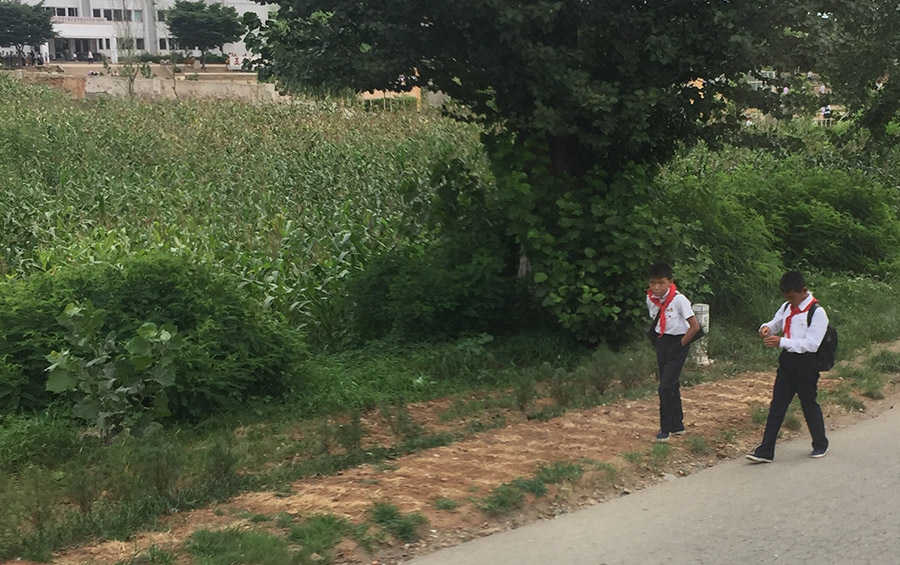
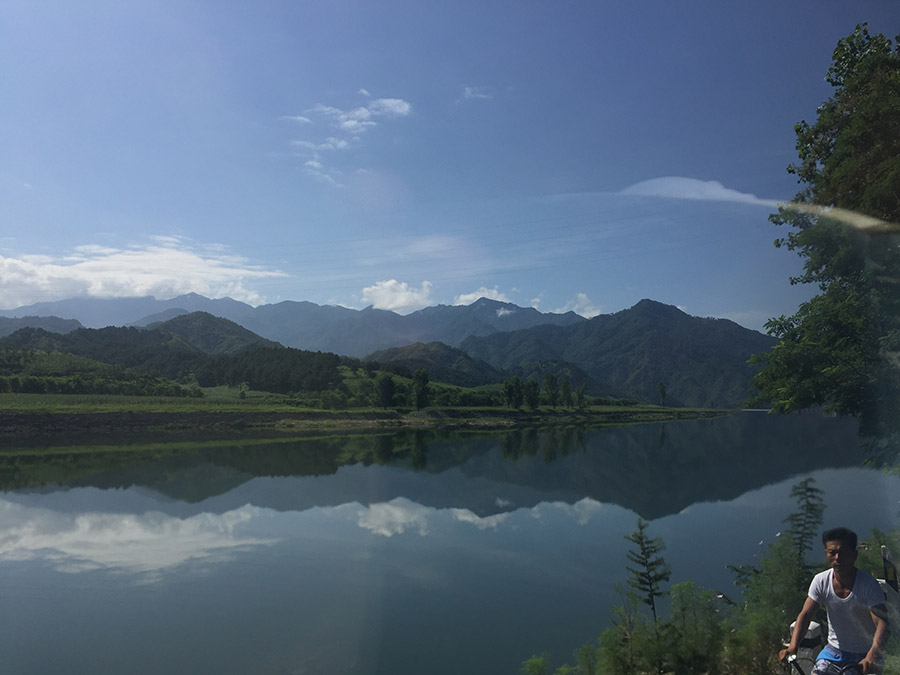
Later in the drive I spotted our senior guide sitting in the back of the bus and went back to talk to him. He was very interested in what I thought of his country so far. Over the course of a few hours, we had an increasingly open conversation about relations between the US and the DPRK, the Korean War, our lives and our families.
The back of the bus took the full brunt of the road’s many cavernous potholes. Our conversation was frequently punctuated by everyone in the last row of the bus being tossed two feet into the air and then landing on each other’s laps with every bump. This is something of a boon for conversational closeness. As we talked, I hooked my feet under the seat in front of me, as this was the only way to keep from hitting my head on the ceiling every time we hit a pothole.
I was so engrossed in this conversation I missed most of the road drama happening in front of us, as night fell I only caught glimpses of our bus heading down a road that was blocked by a truck, backing up, taking some alternate route, and ultimately ending up in a town entirely unrelated to the one we were planning on staying in that night. An announcement was made that we’d be staying the night in this random middle of nowhere town now. Okay!
This was actually kind of exciting since although I didn’t believe the theories that everything we saw on the trip was choreographed and phony, it was still fun to be somewhere we technically weren’t supposed to be. The hotel rooms here reminded me a lot of Japan, with tatami mat floors, low firm beds and a “the whole bathroom is the shower” bathroom. Our room had a concrete balcony that seemed to sway slightly when we stood on it. Outside of the hotel, the town was pitch black. Occasionally someone would walk by carrying a flashlight.
We went down to dinner, and were presented with a green splat on a plate that looked like rubber vomit. Potato pancake! Oh DPRK potato, that’s where you were hiding. Then they dropped off the potato cannolis, with a generous squirt of potato sauce over the top. Okay, I didn’t know that was a thing, but- Would you care for some potato chips? I guess- And why don’t you wash that down with this bowl of potato soup? Oh god, I think we’ve blundered into their ironic punishments sentence for people who are caught stealing a potato.
The potatoes just kept coming as we did our best to cope. I fully expected to return to our room, open the door, and be instantly buried under an avalanche of potatoes.
I suspect the instinct of the reader at this point would be to figure that I’m exaggerating, but in reality I’m forgetting at least three more all-potato dishes they served us at that meal. It all blends together in an off-white puree in my memory.
Every night we stayed outside of Pyongyang would end with an announcement about when hot water would be available in the hotel. It was usually for a half hour each evening and again early in the morning. We took mental note of this and headed off to see what mischief we could get into.
On the fourth floor landing we found a pool table, which was occupied by a fairly large group of North Korean men. The rest of our retinue paused apprehensively on the stairwell as I blundered right into the thick of the Koreans and said hello. They were in the middle of an extremely intense game of pool. Shirts were coming off. I was trying to understand if shirts versus skins pool was really a thing when I noticed their peculiar balls. The pool balls. These were the roughest pool balls I’d ever seen in my life, it looked like they might have been carved by hand. Tensions rose and the cigarette smoke thickened as one man tried to knock what may have been an onion painted like a pool ball into the corner pocket. Okay, we’re out of our depth here, let’s call it an early night.
In the morning we headed off to the International Friendship Exhibition, the grand hall in the mountains where all the gifts that foreigners have presented to the Kims are kept on display. The drive out of our unplanned stop-over town was wonderful as it seemed very likely that none of these people had ever seen foreigners before. We had a lot of fun waving to people on the street and seeing their faces light up in happy surprise before they waved back. Often times you had to wave for several seconds before it would dawn on them “Oh my God he’s waving at me!!” but they always had a joyful response in that moment of recognition.
Pat pointed out to me in one of our conversations that an American visiting the DPRK is like a virus. Just by being there, and not being the horrible devil Americans are painted to be in North Korean culture, you’re giving everyone you interact with a reason to question what their government is telling them. You don’t have to be Gandhi, you just need to not have horns and refrain from killing any babies while you’re there. I felt like I was seeing this process in miniature every time a Korean on the roadside flipped suddenly from scowling at us to smiling broadly and waving back.
Over the course of the trip a few of us made a game of who we could get to wave back to us. In the countryside, children were the easiest marks, then women, then men. Then it was another step up in difficulty to get people in Pyongyang to wave back. They were far more wary of foreigners or perhaps of being seen interacting with foreigners. The boss level in this game was getting a soldier to wave back. By the end of the trip we’d even accomplished that lofty goal.

We arrived at the Friendship Exhibition Hall and were required to turn in our cameras, sunglasses, basically everything we were carrying. They apparently tossed all of these things in a sack and ran them over with a train since when we got our stuff back, Nancia’s camera had a caved-in screen and my sunglasses were snapped in half. Note to self, probably better to leave things on the bus.
As we stood in the lobby awaiting entrance to the halls of gifts, I chatted with my Australian friend Magic Mike. “You know, this whole place is a lot nicer than I was expecting,” Mike said, referring to the DPRK. “Yeah,” I said. “It’s pretty nice as long as you’re not in a labor camp. On the way here we passed a few miles from one of their big ones.” “Oh yeah?” “Yeah, they have about 120,000 people in forced labor camps, most of them for the ‘crime’ of not appearing loyal enough to the Kims. It’s hell on Earth and you don’t get out. They’ll all die in there.”
I suddenly realized the entire room had gone silent and I was talking about the labor camps WAY too loudly. Uh-oh. After a brief pause everything went back to normal. Okay then.
The International Friendship Exhibition Hall is a massive marble complex separated into wings for Kim Il Sung, Kim Jong Il, and Kim Jong Un. Each wing is divided into areas by geographical regions with glass cases for each country, displaying the gifts Dear Leader received from that country. Tensions were high among our heavily international contingent, as everyone was both anxious and yet dreading to see what their asshole countrymen had given Kim Il Sung.
To give a sense of the scale here, we spent hours in these halls and didn’t even go into the gifts from Asian countries at all, which heavily disappointed me since I wanted to see one of those taxidermy alligators that holds a tray of drinks:
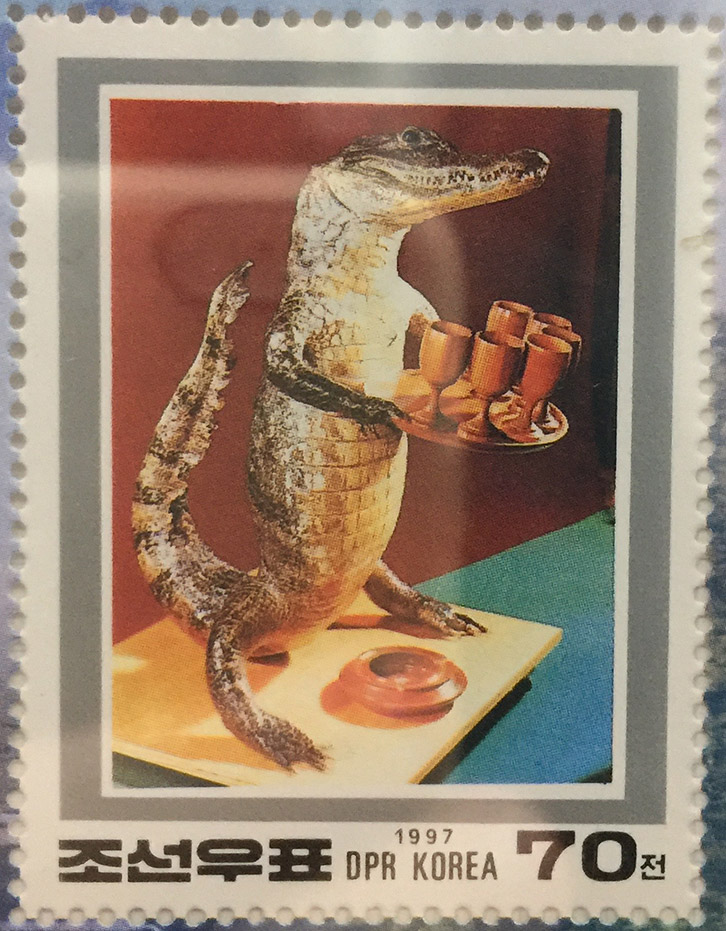
The gifts we did see ranged from the mundane to the bizarre. Most of them were from obscure communist groups within each of the countries. The most significant gifts were from the USSR and Cuba, etc. Russia seemed to have provided an unconscionable number of dead bears. We teased the Australians endlessly that they better have given Kim Il Sung a boomerang, and sure enough, they had. They saved the American case for near the end, and Arielle and I raced over to see what we’d given. I laughed out loud when I saw two identical little statues of a cowboy riding a horse. Arielle joked that we just needed a tiny McDonalds and all of America would be represented. There was a hockey puck from CNN that said CNN on it. What? That was basically it.
All of this was repeated in the wings for Kim Jong Il and Kim Jong Un. Dennis Rodman had gifted a Harlem Globetrotters jersey and I had to explain about six times that Dennis Rodman is not on the Harlem Globetrotters, they’re not a real team- never mind. There seemed to be an awful lot of NBA stuff for a country that hates America.
Between the halls of gifts, we were taken into large shrine-like rooms that housed absolutely terrifyingly lifelike statues of Kim Il Sung, Kim Jong Il, and Kim Jong Il’s mother Kim Jong Suk, all of which were gifts from the Soviet Union. I don’t know if they were wax or witchcraft or what, but these things were on point. The statue of Kim Jong Il especially mesmerized me. I stood in front of it for several minutes, waiting for it to blink, and willing it not to.
The third wing wasn’t exactly a Kim Jong Un wing, it was more a jumble of the most recent gifts organized by year. This fit a very consistent theme throughout the country where the cults of personality for Kim Il Sung and Kim Jong Il were carefully crafted and meticulously maintained, where everything about Kim Jong Un seemed like it had been crammed in at the last second without much thought.
We passed through other rooms displaying the bulletproof cars and planes and trains that had been gifted to the Kims, along with huge maps with light bulbs showing where each of the Kims had traveled within their lives. I was struck by how poorly traveled Kim Jong Il was compared to his father, it was pretty much just a small arc among the other communist nations. Kim Jong Un didn’t have a lightbulb map. Maybe he doesn’t leave the country.
I found it pretty interesting to think about why we were seeing all of this. Why do they have these grandiose halls full of largely chintzy little gifts? Our senior guide inadvertently answered this for me. “You see how great our leaders are? So many from around the world pay their respects.” Ah. Okay, I see the propaganda value of this now. It’s a holy shrine to the greatness of the Kims, every little paperweight tchotchke further proof that the world agrees, these guys were just goddamned fantastic. To an outsider, the displays of gifts were kind of pathetic. If you’re a businessman and you want something from a head of state, you bring them a gift. If you’re visiting from a foreign government, you bring a gift. It doesn’t mean you approve of or admire them. It’s just a polite formality. But for a North Korean who doesn’t know much of the outside world, and who has lived their entire life with absolutely everything and everyone around them telling them how great the Kims are, why wouldn’t this look like further proof of their greatness? The building was really nice, and look at all this stuff!
Immediately I began to think of our public buildings in America, and what purposes they serve. What are we meant to think standing in front of the Lincoln memorial, or staring up at the the Washington monument?
After the gift halls we visited the Pohyon Buddhist temple nearby. My “Wait, is this real?” sense went into overdrive since I’d been trying to figure out the state of religion in North Korea ever since we’d arrived. We were told by the guides that North Koreans were allowed to follow any religion they chose. But we also knew most of the Westerners who were in prison in North Korea were there for proselytizing. As in, like, accidentally leaving a bible in their hotel room when they checked out. This didn’t seem like an environment overly tolerant of religion. On the first night, our guide had asked on the bus if any of us were religious, and absolutely no one raised their hand. I’m sure this wasn’t actually true, we all just thought it was a trap.
Before I left for the trip, my mom said “When you meditate in North Korea, make it look like you’re taking a nap.” I’d watched a documentary on the flight over where the DPRK government had taken the filmmaker to a Catholic church in Pyongyang to show him a service. “See, we have freedom of religion.” But the filmmaker left more confused than ever. Were these just North Koreans posing as Catholics? Their singing of the hymns did seem a little too perfect…
This paranoia loop has no end. I asked our guide for clarification and she explained that North Koreans are allowed to practice or teach whatever religion they want, but it was illegal for foreigners to spread their religions. Hmmm.
I entered the temple and took in the beautiful artwork and architecture.


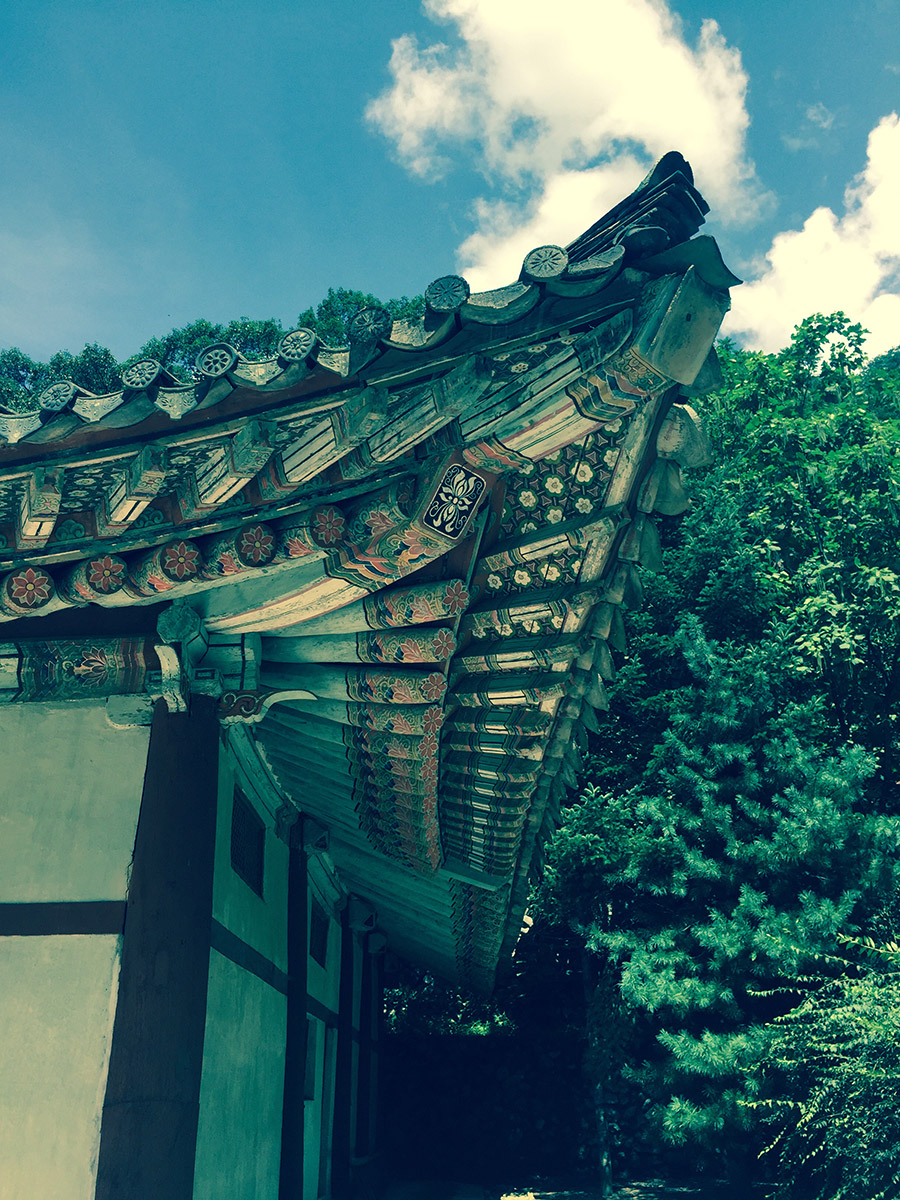
The monks looked like monks. If they were actors, they were good ones.
Our guide waited for me as I lagged behind the group, ducking into one of the other shrines to take a photo.
“Are you a Buddhist, Sean?”
“Nope!” Nice try, DPRK.
As I stood in front of the shrine, a monk stuck his head out and we made eye contact. He very subtly looked down at his wristwatch.
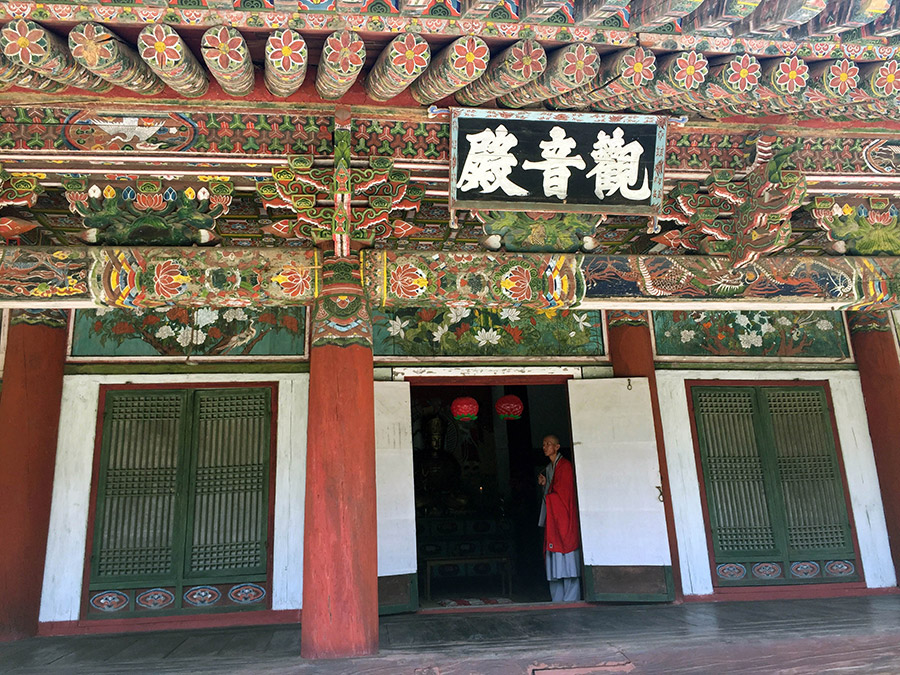
Was he just a guy in a robe who was there for effect? Was he looking to see if the tourist visiting hour was up so he could go back to drinking soju and watching the Moranbong Band? Did he have a wig in the back that he wore the rest of the day back in the city? Or was he just a monk who wanted to know what time it was? Goddammit, DPRK.
Later when I asked Pat about the religion issue, he offered perhaps the most intelligent take on the subject. He believed the North Koreans were free to practice whatever religion they liked, as in they wouldn’t be sent to jail for it. But this would sure as hell put you out of favor, in a country where your very survival depends on being in favor. So you could be a Buddhist or a Catholic as long as you weren’t overly attached to eating food or sleeping under a roof. This made sense to me.
Goodbye maybe monks. I hope for your own sakes that you’re just actors.
After lunch we headed up to Mt Myongyang, “The Mountain of Mysterious Fragrance.” There were no actual odor mysteries that I was aware of.
The original DPRK tour I’d planned to join in September would have allowed me climb DPRK’s four big mountains. Trump’s travel ban put an end to that plan, but I was still going to get to hike Paektu and Myongyang, so I resolved to make the most of my time here and climb to the top. They’d only given us 90 minutes at the mountain, which was going to make it tough. Nancia and our senior guide joined me on the hike, though each eventually fell by the wayside when the opportunity to have a smoke arose.
I think technically our senior guide was supposed to stay with me, but when we reached a rest stop and someone told him we were only half-way up, he immediately gave me a very polite “Fuck it, you’re on your own” and I headed the rest of the way up by myself. This was probably for the best since that random person had been completely wrong, we were only actually a third of the way up at that point.
The path crisscrossed back and forth around the tall waterfall that rained down from the top of the mountain. I chatted for a moment with my friend Francine from Mexico and then further up encountered Jean-Sebastien, a thoughtful Frenchman on our tour who would go on to blow my mind with his passion for Taco Bell. He was standing there, looking dazed. “Hey, weren’t you with Julien and Mike?” “Yeah, they wanted to go to the top but I don’t think they’re going to make it.”
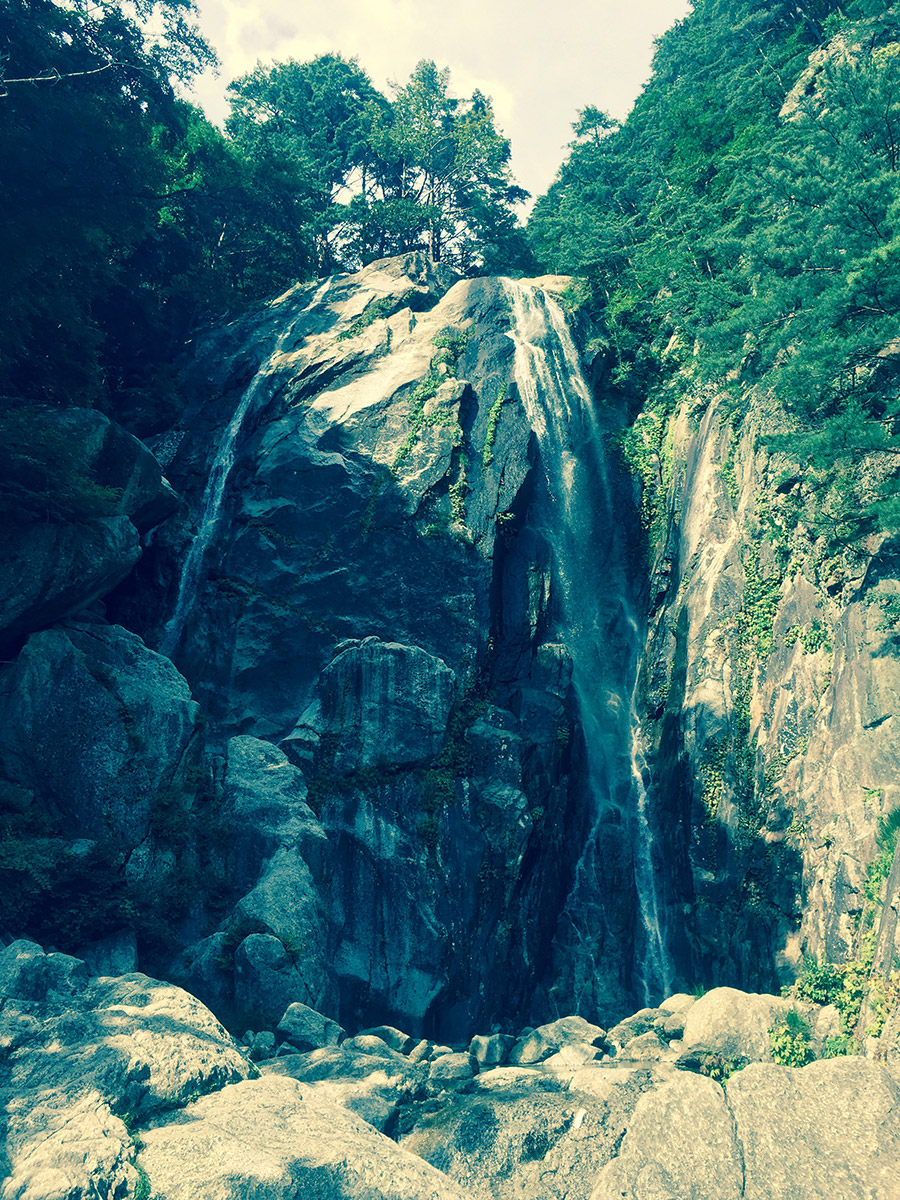
I continued to climb as the trail grew steeper and steeper and the view down in to the valley behind me grew ever more beautiful. Sometime much later I caught up with Mike and French Julien. Mike was dripping wet. “Yeah, I took a dip in the waterfall up there, it’s quite nice.” I told them I was going to the top and they wished me luck, they were headed back down so they wouldn’t be late for the bus.
I looked at my phone and figured I’d have just enough time if it wasn’t too much further to the top. The way the path zig zagged it was pretty much impossible to tell where the top was.
After I passed the step in the waterfall where Mike had gone for a swim, the path grew much steeper, until I was clinging to a chain and pulling myself up from one rocky outcrop to the next.
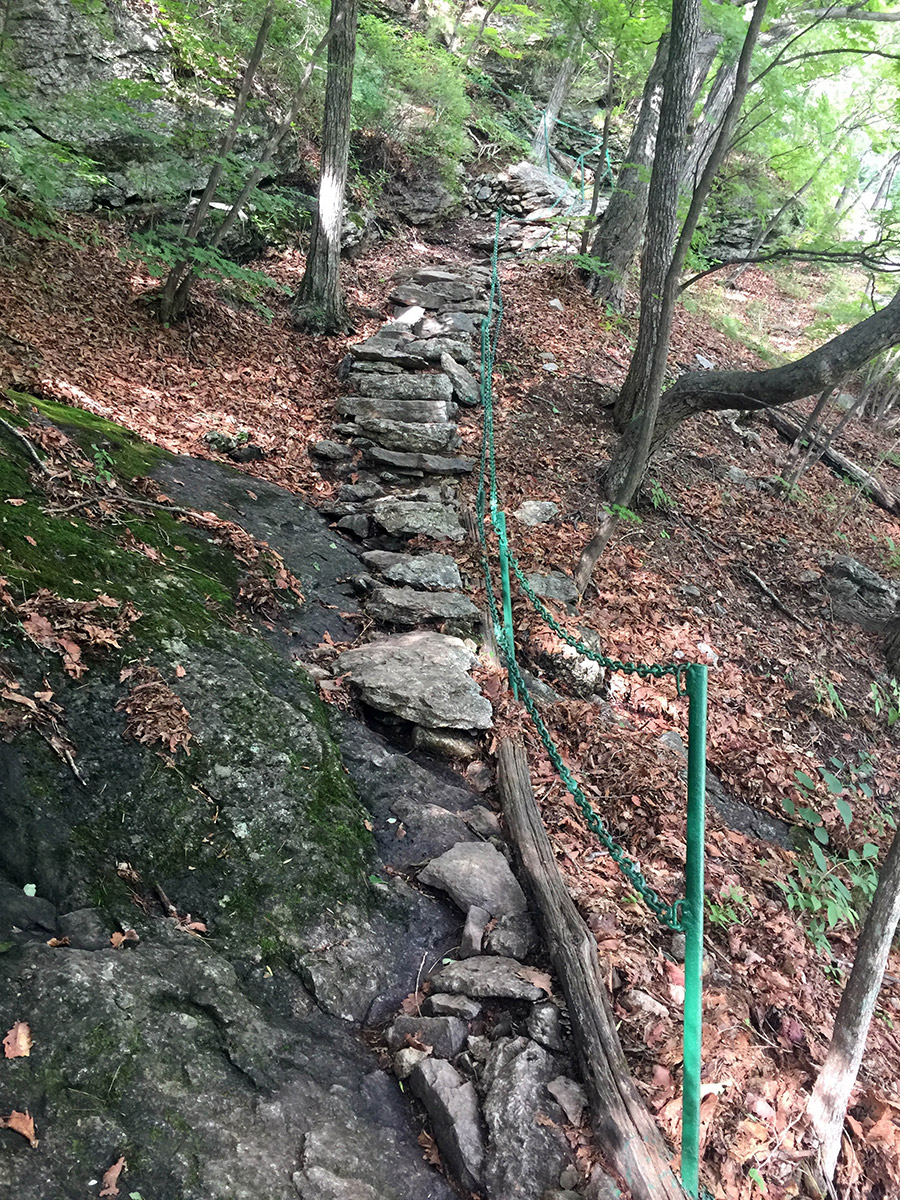
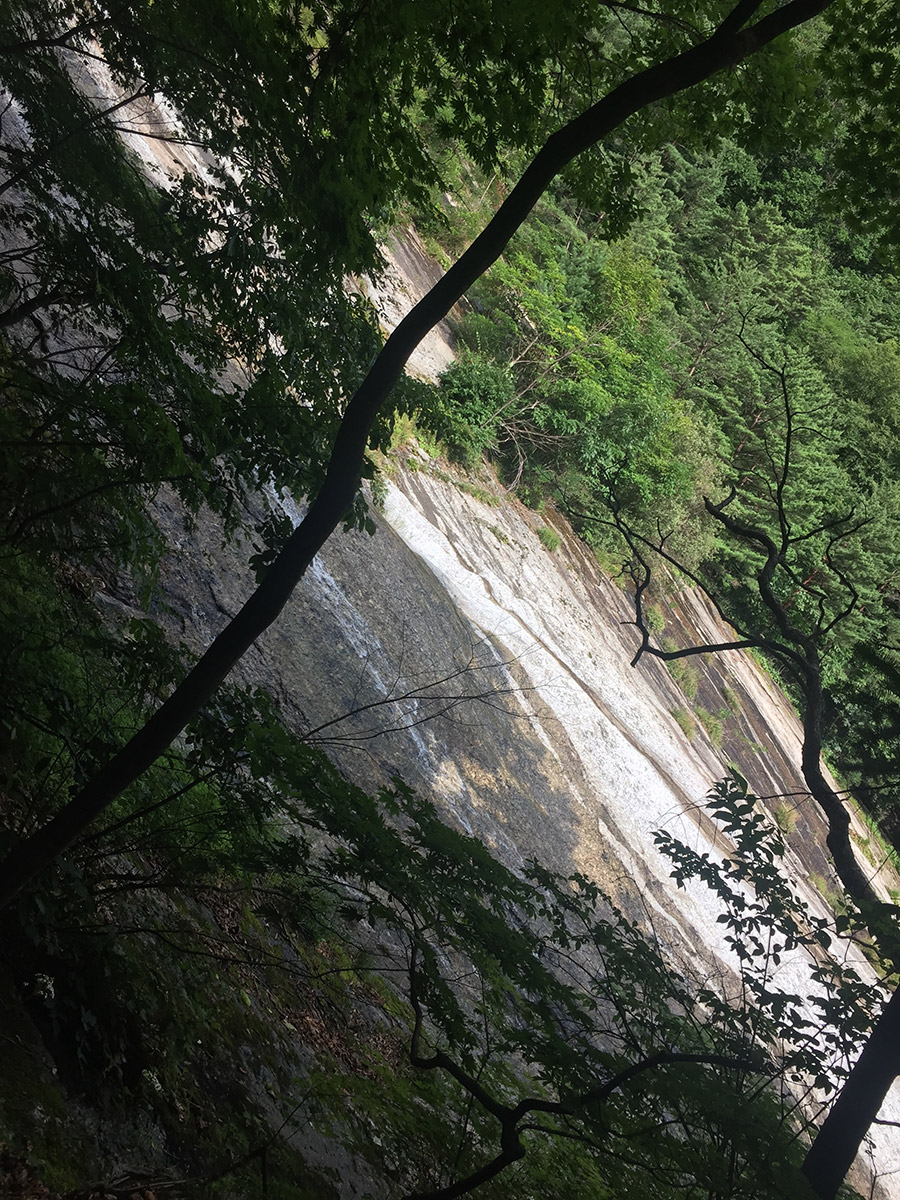
The higher I climbed, the sounds changed and there was a new kind of bird in the trees up above me. I couldn’t see it, but it sounded just like a duck. Would there be ducks up here? Mountain ducks? This should be the mountain of mysterious sounds.
I looked at my phone again and the bus was leaving in 20 minutes. Shit. I was fully committed at this point, the sweat was dripping off my hair and it was going to suck a lot to get this close but not reach the top. I decided I could run down from the peak and still get to the bus reasonably close to our scheduled departure time. I continued to climb.
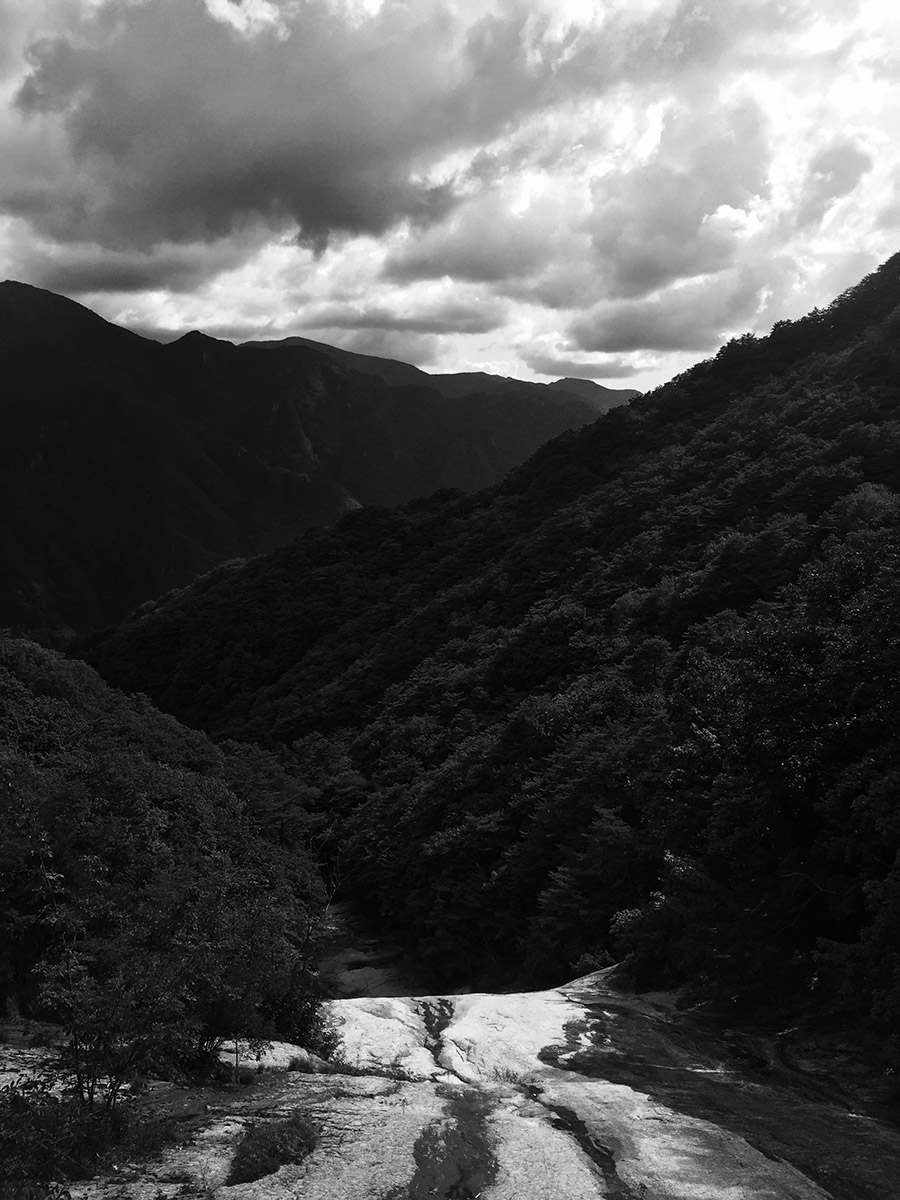
Even though it was only our second full day in the country, getting out from under the 24/7 surveillance and being truly on my own felt wonderful. The sun shone down as the waterfall streamed by. This was easily one of the highlights of the trip.
Eventually I reached the end of the trail, which concluded with a little gazebo at the top of the waterfall. From that point the mountain leveled off and the stream that would become the waterfall disappeared off into the woods. It wasn’t quite the very highest point on the mountain, and I realized a fork in the trail much further down the mountain that had only been marked in Korean was probably the trail to the overlook on the very top ridge. Oh well, this is very close and the view is great.
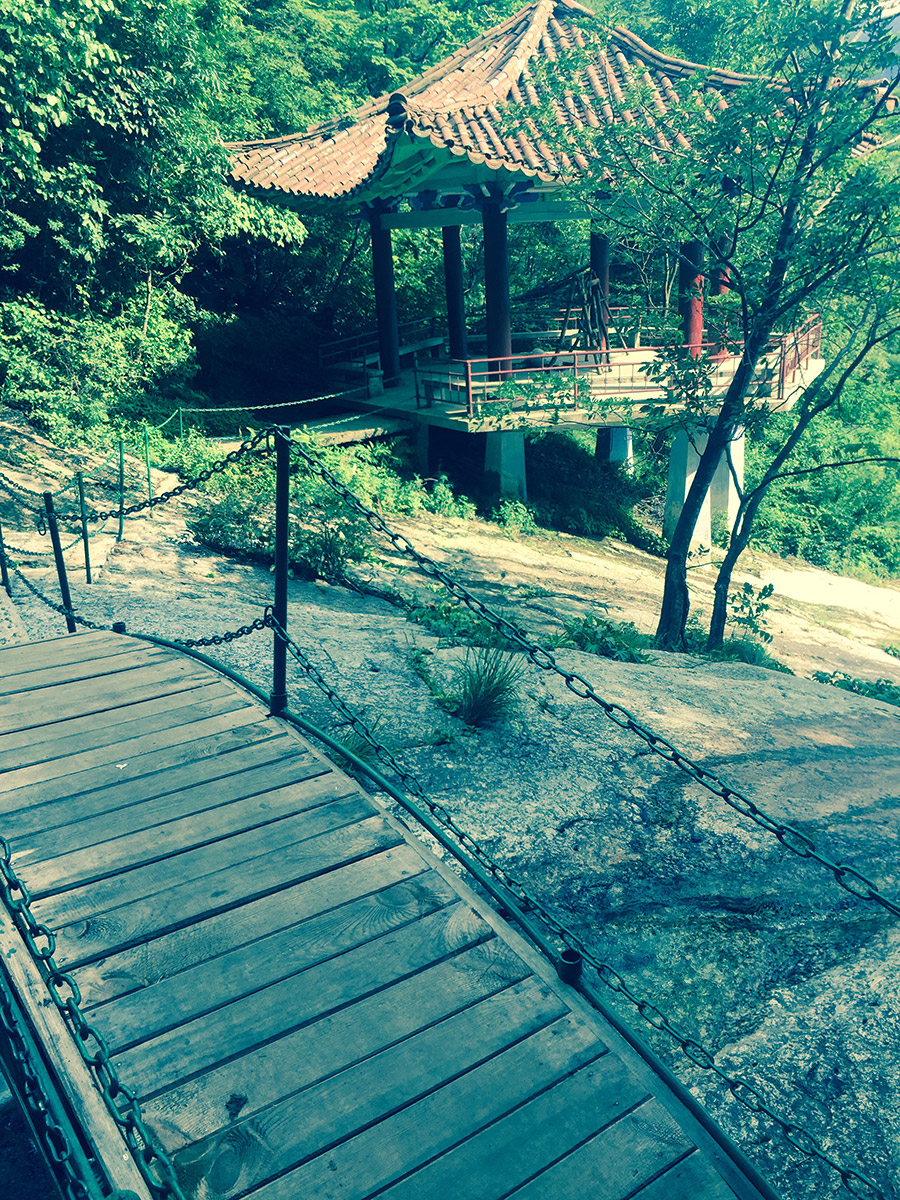
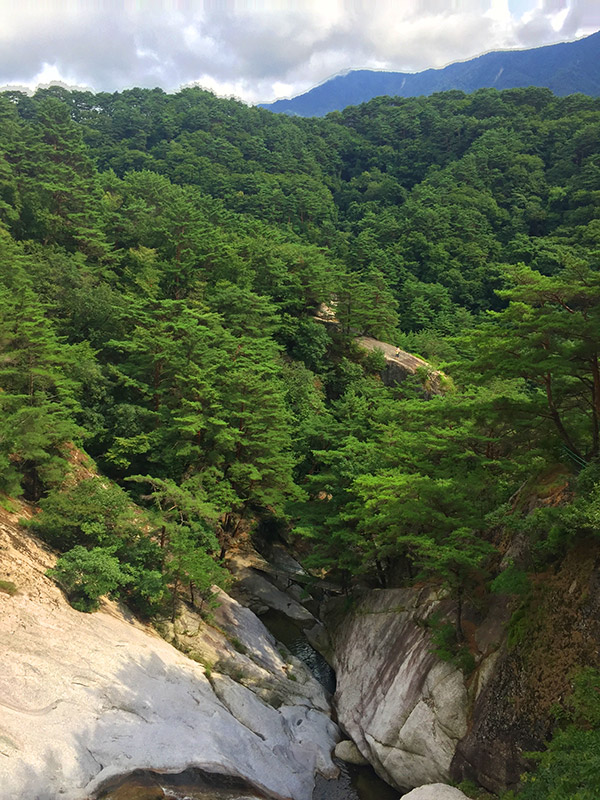
I took a few photos that really failed to capture the view, soaked in the scenery and headed back down. Before long I encountered an Eastern European woman and the unfortunate North Korean guide she was dragging up the mountain. She asked me if they were close to the top and if it was worth seeing, and I told her about what I’d seen up top. She thanked me and continued on. As I passed her guide, he gave me an unmistakable look that said “What in the fuck are you doing up here by yourself, white man?”
Once I was far enough past those two that I wouldn’t freak them out, I began sprinting down the mountain. I figured if I ran all the way to the bus I’d only be about 15 minutes late, which seemed acceptable. The really steep parts of the trail weren’t ideal for this, and some of the bridges got pretty wobbly at running speed. But I made good time and before too long I was at the rest area near the bottom, where our senior guide was waiting for me.
“Oh man, I’m really sorry I’m late. Thanks for waiting for me.”
“It’s okay. I know you are a health nut.”
I had planned to sprint all the way to the bus, but our guide was in no hurry whatsoever.
“It’s okay Sean, we have nowhere to be. We’re just going back to Pyongyang. No hurry.”
Mike and French Julien were waiting for us a bit further down, and we exchanged stories of the hike as our guide walked us very, very slowly and casually back to the bus. This took something like 25 minutes.
We were about 45 minutes late when we finally arrived at the bus. The other guides were pissed. The rest of the tour group was divided between the pissed and those who were excited to hear that I’d reached the top of the mountain. We apologized and everyone eventually got over it, as they were sweet people and in time other people were late for things. Our senior guide didn’t give a hot goddamn. He was clearly in charge.
“Here’s your room key,” our guide said as we stood in the lobby of the Yanggakdo at the end of our long day. “Uhm, this is the same room we had last time. With the wet beds?” “Yeah they promise they fixed that.” “Right.”
We got up to our room and, sure as the sun rises in the east, the beds were still wet. Julien wisely dreaded the fingernail-pulling exercise that going downstairs to complain was going to be, so I volunteered to go down and try to get us another room.
As I rode down in the elevator, I thought to myself “I’m going down to the front desk of a hotel in North Korea at midnight to demand a new room. This is insane.”
Eventually I got someone to come to the desk and politely explained our dilemma. After much repetition the clerk seemed to get it and said “I will send housekeeping to change your bedding.” “That’s great, but that doesn’t fix the problem. The ventilation is blowing wet air into the room. That new bedding’s just going to be wet in another hour. We need another room.” Every last bit of this seemed to be lost in translation.
The clerk walked away like he was going to do something about this and then came back to me a few minutes later. “What are you still doing here? I sent up housekeeping.” “Yeah, like I said that doesn’t really fix our problem. We need a different room.” He walked away again with an air of purpose and returned ten minutes later. “What are you still doing here? I sent housekeeping up to your room.” Oh my fucking Christ.
This went on back and forth for a solid hour. The clerk told me several times they didn’t have any other rooms to give, and I told him politely that I didn’t believe him, there are a thousand rooms in this hotel and there are a hundred people staying here. At one point the clerk and his co-worker conferred in Korean and seemed to agree that it was worth giving us another room just to get rid of me. They went to a huge bank of keycards and came back with one.
“Here you go.” It was the first room we’d been given on night #1. The room that was somehow even wetter than the one we were in now.
I looked down at the card, looked back at the clerk and said “You’ve got to be shitting me” with my eyes. Both the clerk and his co-worker burst out laughing. Oh you fucking guys.
Was it because I was American? Could they tell? Maybe they mess with Canadians too just to ensure ample coverage. Sorry Canadians.
We went through a few more rounds of “What are you still doing here?” and finally I said, look, clearly we’re not communicating well here, let’s just call and wake one of our guides up and get this straightened out. This seemed to either scare or inconvenience them enough that they finally came back with another keycard that mysteriously hadn’t been in play for the last hour. I thanked them and started to walk away. The clerk said something in Korean and both he and his co-worker burst out laughing. I walked back to see what was up and they both immediately stopped, and the clerk said something that I’m certain was Korean for “No, nothing, just get the fuck out of here.”
On the ride back upstairs, I was sharing the elevator with a few Chinese tourists. One of them had accidentally leaned against the panel of floor buttons, so we were stopping at several floors in a row: ten, eleven, twelve. The elevator doors opened on ten and the floor was utterly pitch black, a void. Two people emerged inexplicably out of the darkness and boarded the elevator. What the- Eleven. Pitch black. Twelve. The two people who’d emerged out of the darkness on ten disembarked and disappeared into the black on twelve, the darkness swallowing them up as the elevator doors closed behind them. Well okay then.
When I got up to the wet room, Julien was watching the maids change the bedding. Sorry ladies, we’re switching rooms. Don’t worry, this bedding will be wet again in an hour.
The third time was a charm and our new room was fine. I’m fairly certain no one else on the tour believed our moist bedding story and our guides must have thought we were totally insane. But when I got home, I looked up reviews for the Yanggakdo online and found the unlucky souls who’d had our two rooms. “Why is everything wet? How is everything wet??” “The bathroom mirror fogged up and we hadn’t even taken a shower.” “It was like a jungle in there.” It was a bit like having a poltergeist in your house and then one day you find the support group for people whose couches are also levitating.
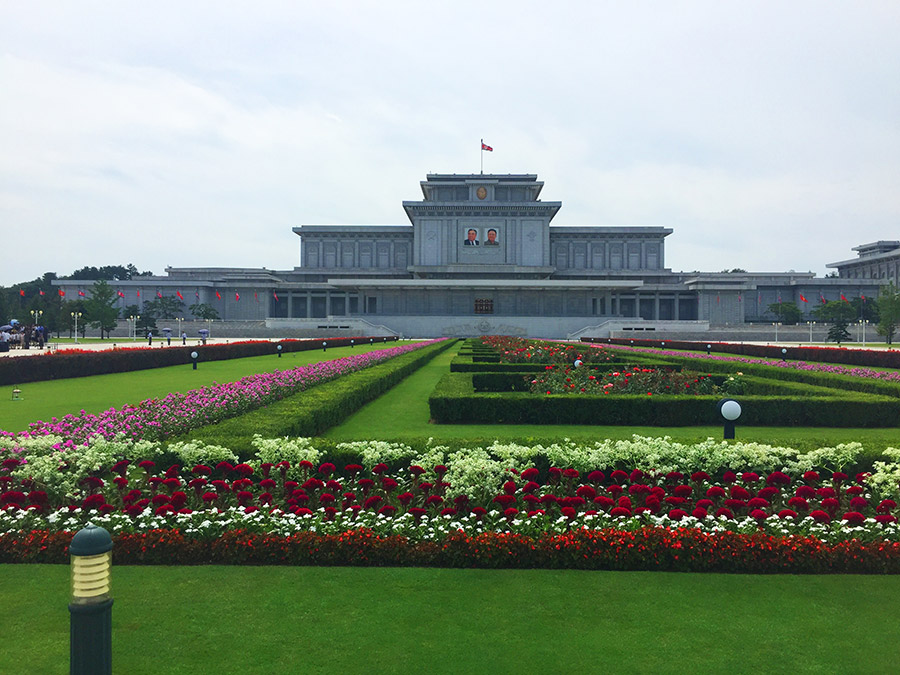
The most tense day for the guides was the morning they took us to the Kumsusan Palace of the Sun, the immense marble complex where the bodies of Kim Il Sung and Kim Jong Il lie on display in glass coffins. This is the holiest of the holies for the North Koreans and a bad place to have a cultural misunderstanding. We heard horror stories of the guy who did a handstand there or the guy who went into diabetic shock in the middle of everything. We were required to dress up to get inside, which is annoying when you’re traveling light and you have to take up a third of your bag with dress shoes, slacks, shirt, a tie, belt, top hat, diamond-tipped cane, etc.
But we were all looking great as they marched us in formation into the building. What followed was an improbably long series of slow moving sidewalks through endless marble hallways. We’d been warned on the way over not to stand with our hands behind our backs as this was considered a deceitful pose in North Korean society. So naturally the sidewalks scrolled us past dozens of photos of Kim Il Sung and he had his hands clasped behind his back in every single one of them. Whatevs, DPRK.
Our guide pointed to the lawn outside and implored us to admire the cranes, the symbol of longevity. Both carved into the outside walls and in the flesh inside the moat running along the building there were many white birds, none of which were cranes. “Uhm, I think those are geese.” “I’d go so far as swans but they’re definitely not cranes.” This was one of a thousand moments on the trip where you weren’t sure if there was a language barrier at play or if they really believed those birds were cranes. For what it’s worth, cranes are traditionally a symbol of longevity in Asian cultures, geese and swans are not. Hmmm.
At one point between the endless series of moving sidewalks, we passed through a room where we walked over rotating rollers covered in fake grass that scrubbed the bottoms of our shoes. Another passageway had us dart through a huge metal machine that seemed to be sucking all the germs off of our bodies, like we were headed in to work on the Andromeda Strain.
Eventually we finally reached the room. Inside, the cavernous, high-ceilinged marble mausoleum was dimly lit and bathed in an eerie red light. Oh shit, it’s on, North Korea. In the center, there was Kim Il Sung in a big glass box, looking mighty waxy. Some believe that the figures in the coffins are just wax replicas, but based on the unnervingly realistic statues of the Kims we’d seen at the other museum, the apparent fakeness of these bodies made me believe they were probably the real deal, just coated in enough layers of shellac to keep the flies away. If they wanted to lay out fake bodies that looked real, they certainly had the means to do it.
I’d read that the bodies were shipped away to Moscow periodically for touch-up work, using the techniques the Soviets perfected on the bodies of Lenin and Stalin.
We lined up horizontally at the feet of Kim Il Sung’s body and bowed in unison, as required. This was repeated on his left and right sides. I’m not sure why you don’t bow at the head, maybe the line moves too slowly with 33% more bowing.
We were marched out of the room, across the complex and repeated the entire routine with Kim Jong Il’s body, housed in an identical glass coffin in an identical room. He looked identically waxen and slightly melted. On the way out, a soldier behind me realized he wasn’t where he was supposed to be and ran by me in a sped up, arms-swaying fancy march that it took everything I had inside me not to laugh out loud at.
Granted we found all of this pretty silly but our guides seemed genuinely somber. I tried to think of how I’d feel seeing George Washington and the Marlboro Man’s bodies on display.
After the body gawking rooms we were led through halls filled with honors and awards the two Kims had received in life. The top portions of the walls were lined with photos of Kim Il Sung meeting a veritable who’s who of foreign dictators who had since been overthrown by their own people and in some cases bayonetted in the anus and shot in the back of the head in a roadside ditch.
The honors were organized by country, and in Kim Il Sung’s section I finally found something I’d been searching for fruitlessly in the halls of gifts the day before: his diploma from Kensington University. This was a diploma mill in California that was shut down by the police in 2003. The only Western university that had presented Kim with a degree was the one where the educational requirements were $50 and a self-addressed stamped envelope, and yet here it was, proudly displayed in a case on the wall. Then again I guess the propaganda value isn’t compromised if no one there will ever know what Kensington University really was.
A few more Pyongyang days blend together into fragmented memories.

We’re in the Grand People’s Study House, aka Pyongyang central library, searching their database of available books. 1984? Nope. Animal Farm? Nope. Try The Lion, The Witch and the Wardrobe, they might not realize it’s a Christian allegory. Nope. Damn. The librarian is proudly showing us that they have a random Harry Potter book and some British children’s story I’ve never heard of.
In the A/V room they give us a choice between hearing some North Korean music or The Beatles. The Beatles go into the weird mid-90s CD boombox and we stand around while Paul tells us to get back to where we once belonged. Oh Paul, you have no idea.
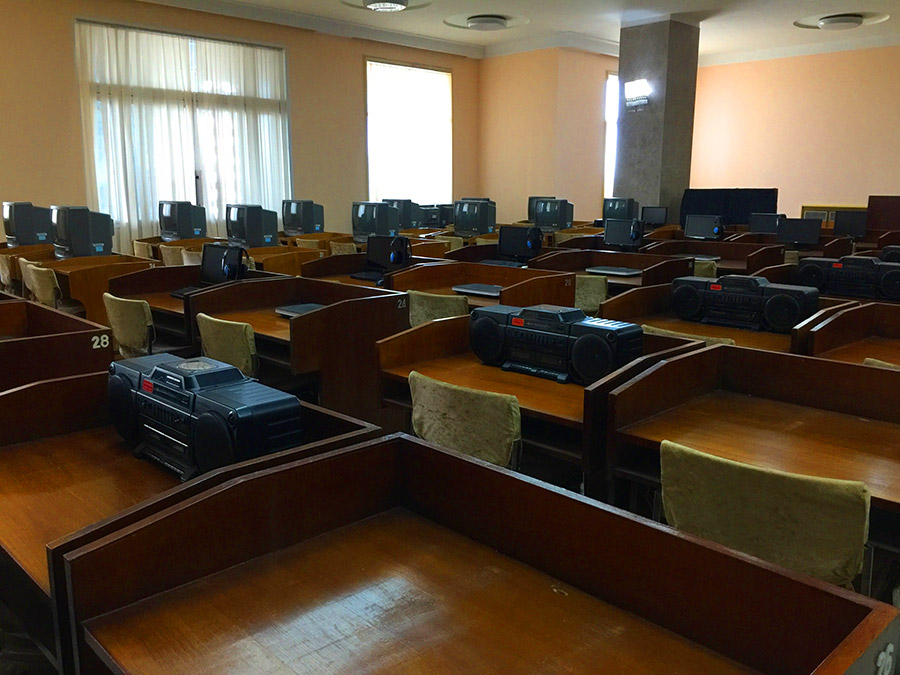
They lead us into a classroom where a programming class is in session. I walk up and watch over one student’s shoulder to see what they’re coding. They’re writing Visual Basic. Hmm, odd choice. I read the code and it’s an auto-dialer program for a telephone. Hmm, odder choice. Would somebody really use Visual Basic for this in 2017? Is this real? Are they just learning things that are 20 years behind the times because it’s North Korea? This is the DPRK, didn’t they hack Sony and write the WannaCry ransomware? All the computers in the library are running Windows XP. Are they just teaching the public obsolete code so they feel like they’re learning something? I never got to the bottom of any of this.
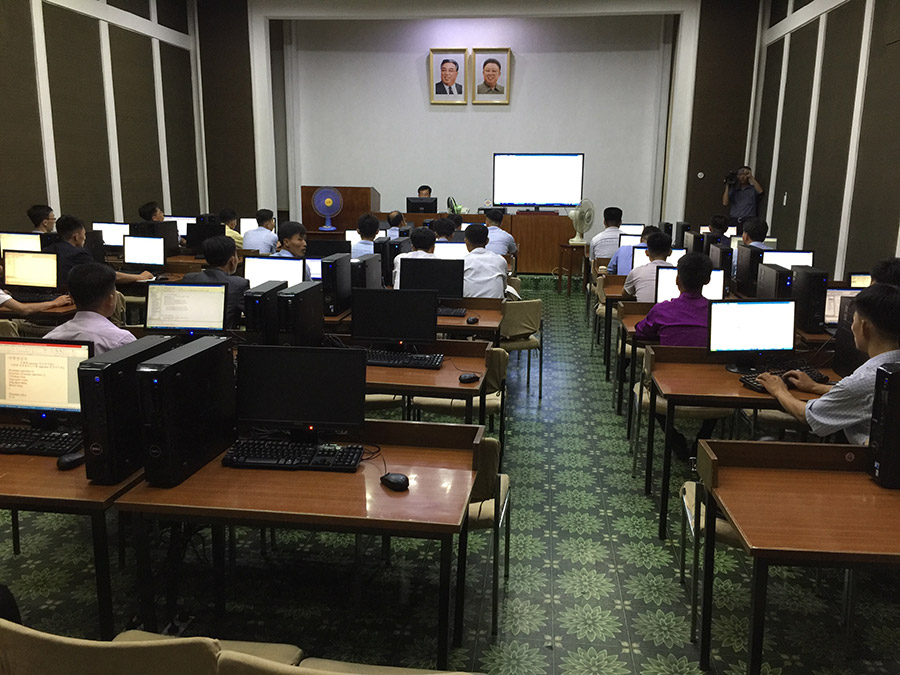
Out on the balcony we took in great views of Pyongyang:
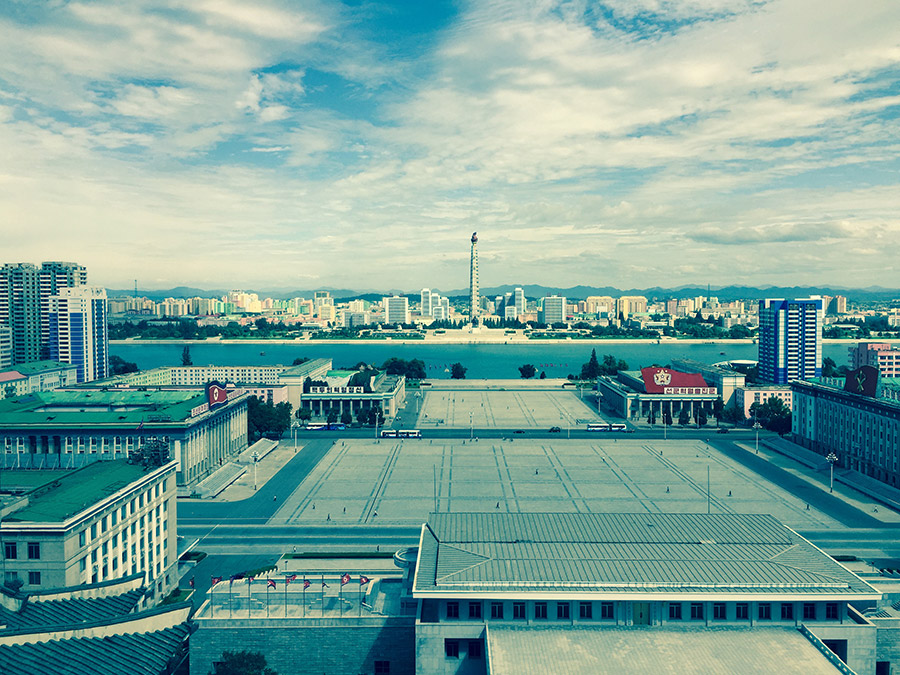
We’re at the Science Museum now, whose all-seeing eye logo they don’t seem to realize is a hilarious thing to have in the DPRK:
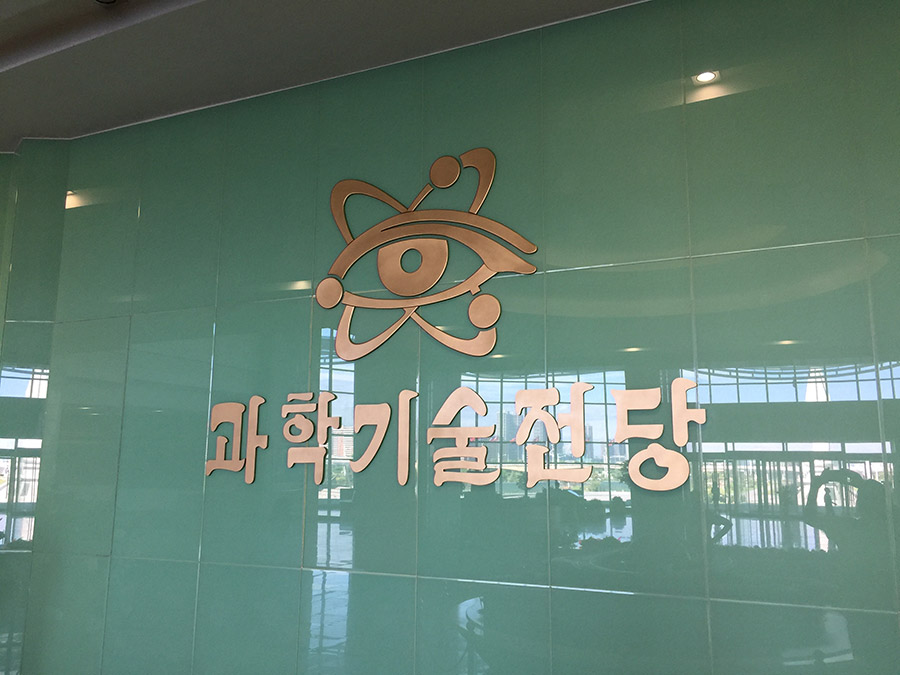
By this point we’re all kind of pissed off to see money spent on flashy nonsense like this when they only have hot water one hour a day and there are people patching their jacked-up roads with buckets of hot tar and hand tools.
In the center of the museum there’s a giant replica of one of North Korea’s ballistic missiles. Hell, for all I know it’s a real missile. Dozens of computer terminals arc around the missile, and kids in red scarves (identifying them as junior party members) sit at the terminals, watching propaganda cartoons.
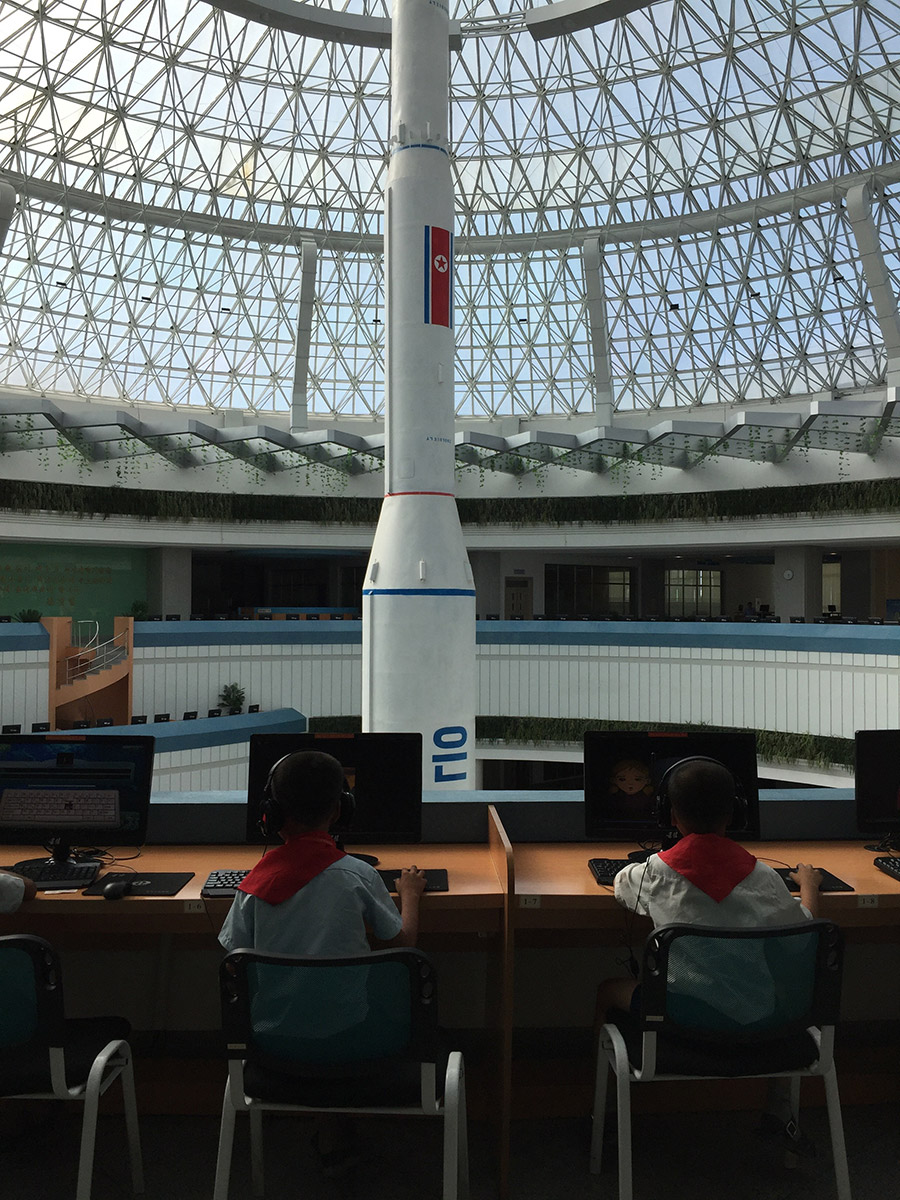
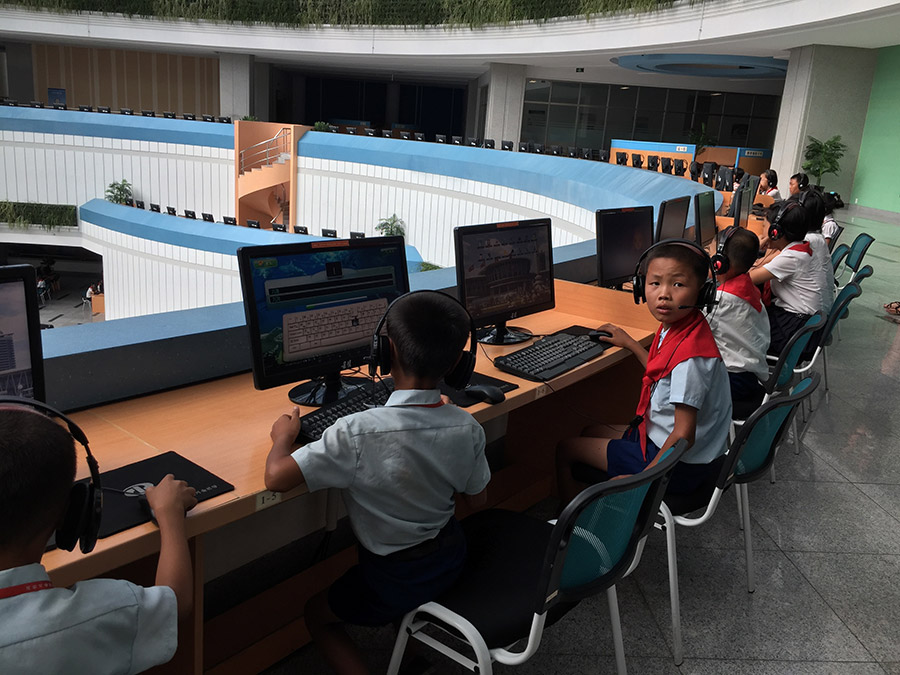
A friend I showed these photos to later cracked me up. “You found the missiles? THEY LEFT THE KIDS IN CHARGE OF THE MISSILES?!?”
We were in a pretty skeptical mood by this point. Did all these kids just happen to be here when we came, or did they gather them up and tell them to use the computers because we were coming? The vast majority of the computers in the building were unattended and didn’t seem to be plugged in.
We perused their small library of English-language books. It was a bizarre mix of extremely dry technical manuals and a picture book about the Dodge Viper.
Several things we saw in the DPRK had QR codes on them, like bottles of water or exhibits in the museum, which we found hilarious. What good is a QR code without internet access? Were they even real codes, or had they just copied the codes of off foreign products to make their stuff look more modern?
We walked through a tiny forest that was in the center of the room for no apparent reason.

This room was filled with kids playing on the various exhibits. The most popular one was a first person tank battle video game that didn’t seem to have an overwhelming justification for being in a children’s science museum.
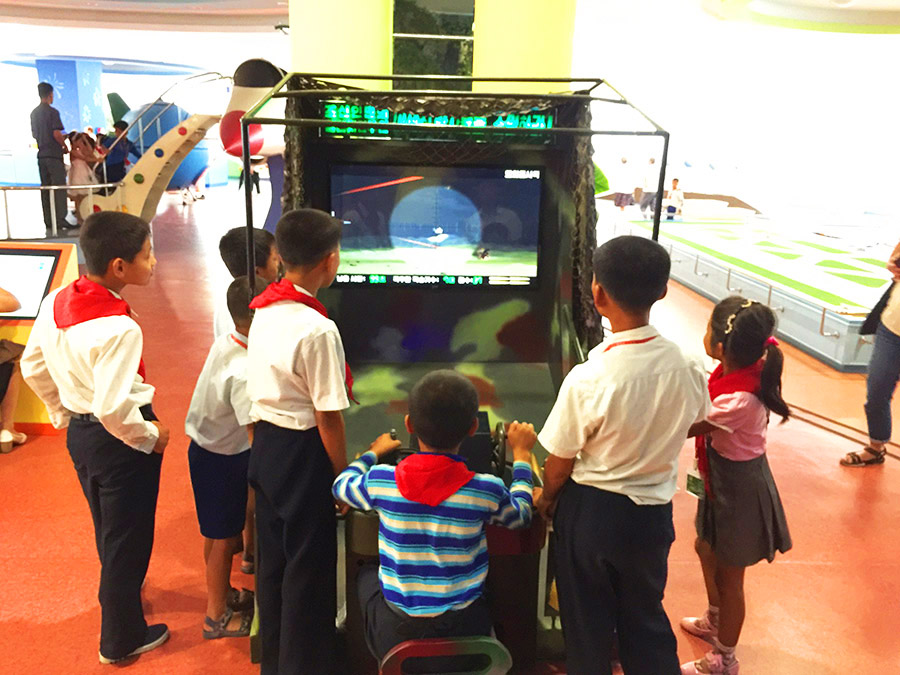
There was also a small replica of an Air Koryo plane:
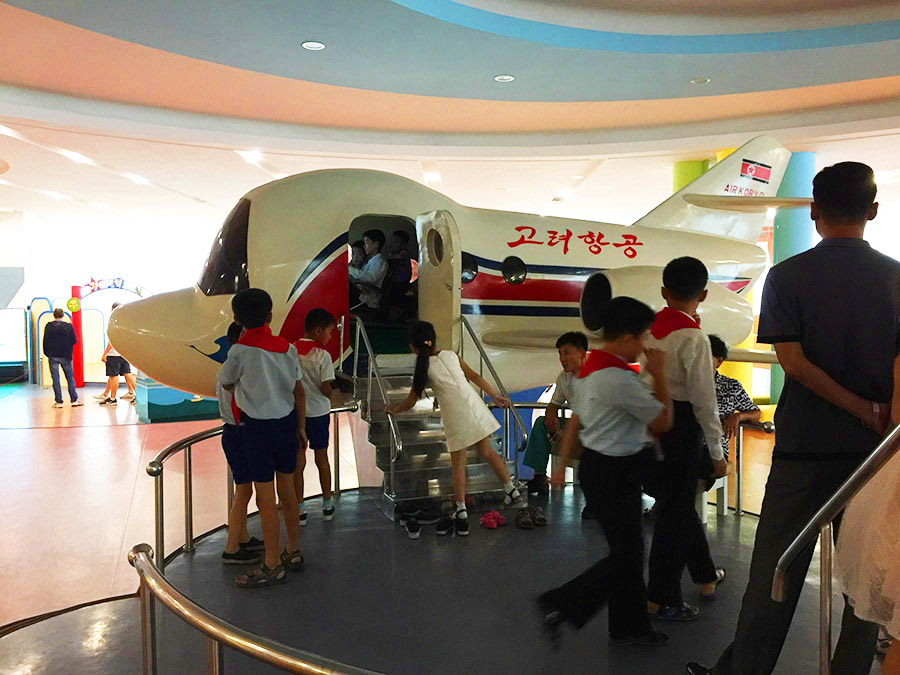
Reg from Australia joked that it was the same plane we’d flown in on. I told him it was too new for that.
Out in front of the building, some DPRK youths were riding a fake Segway around. At first I thought it was literally just wheels on a stick that was propelled only by gravity, but upon closer inspection it did seem to have some kind of electronics going on. Who knows what the hell this thing was.
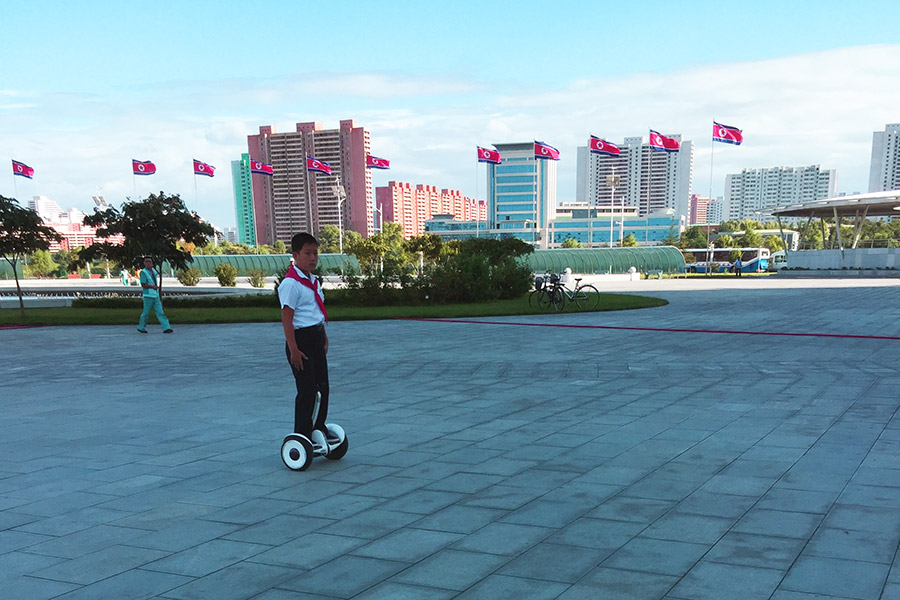
As we walked back to the bus, we looked up at the flags flying in the breeze and Francine said “Happy Liberation Day, DPRK, it’ll be your last!” right as a bunch of soldiers walked by. Thank God, somebody finally said something like that who wasn’t me.

One of my most-anticipated treats in the DPRK was getting to ride the Pyongyang metro. Before we went through the turnstiles we were warned not to take photos of the tunnels. Sure, whatever. I had read that the subway system also served as a series of bomb shelters in case Pyongyang was ever attacked, so I figured they didn’t want us to take photos of this, since it could be considered a military fortification.
We descended an extremely long escalator deep into the Earth.
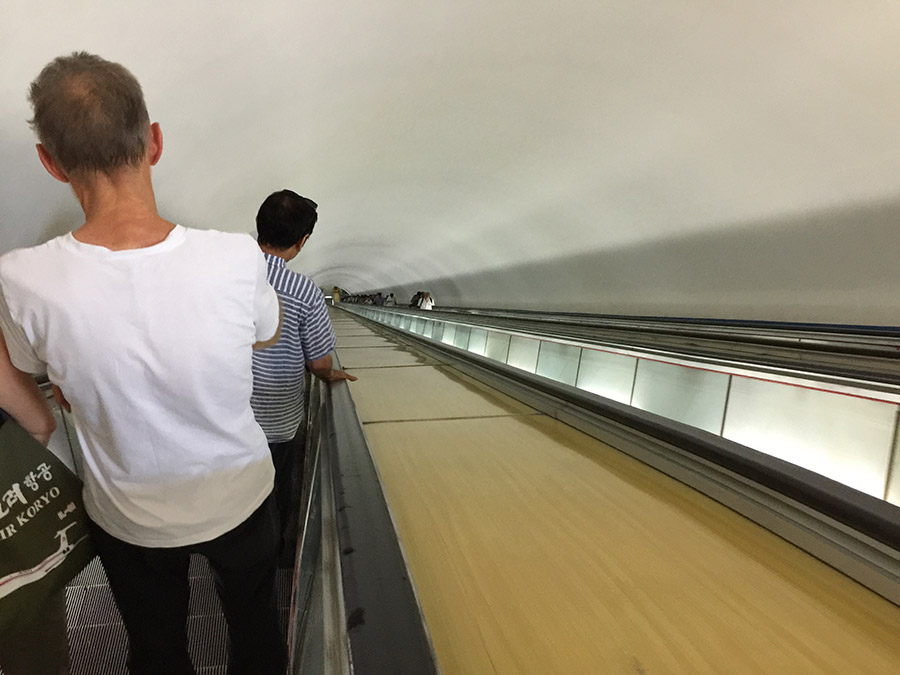
The map of the metro system down below lit up to show you which line to take depending on your intended destination, assuming you can read Korean.
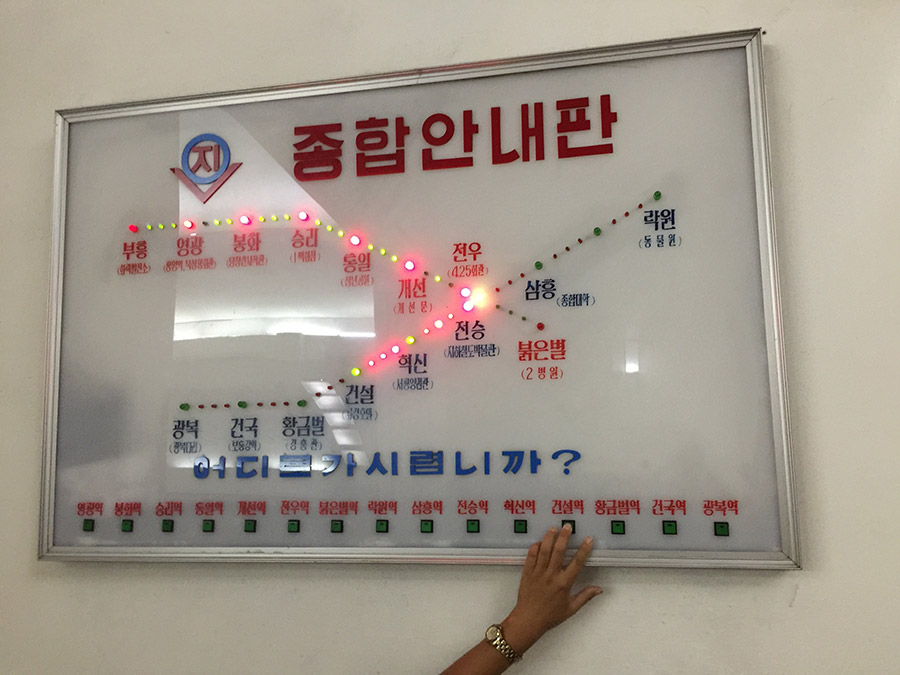
The actual station was pretty amazing, Soviet-style grandeur with a North Korean twist.
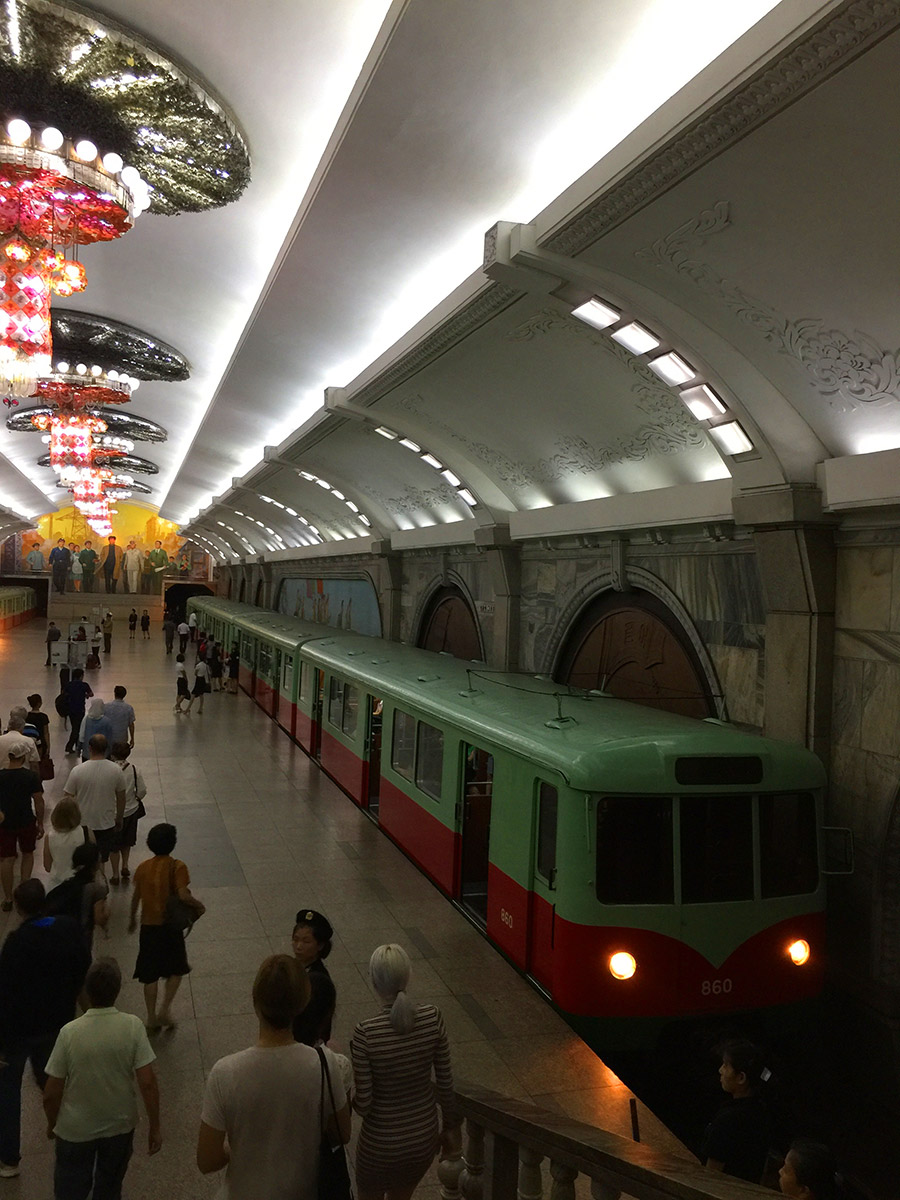
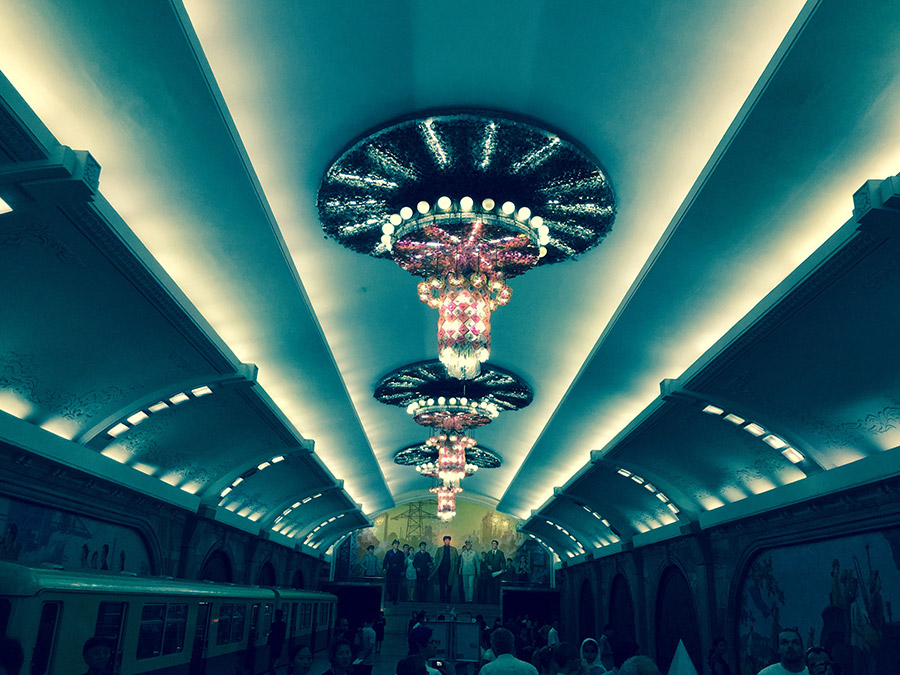
Stands on the platform allowed you to read that day’s newspaper without actually paying for it. I think this is North Korea’s bittorrent.
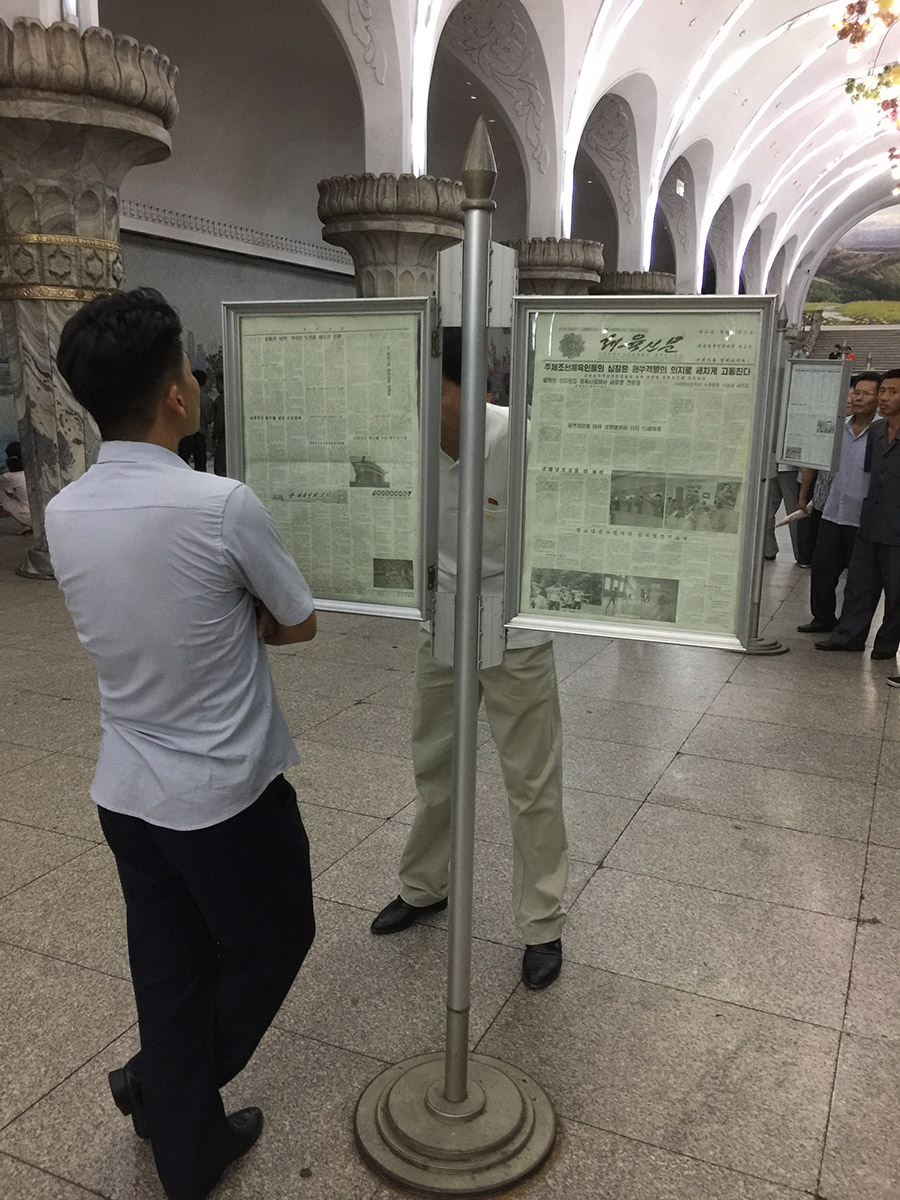
Boarding the subway car, the majority of our group congregated together in an empty car. I walked past this and sat right in the middle of a group of North Korean guys. So cool!
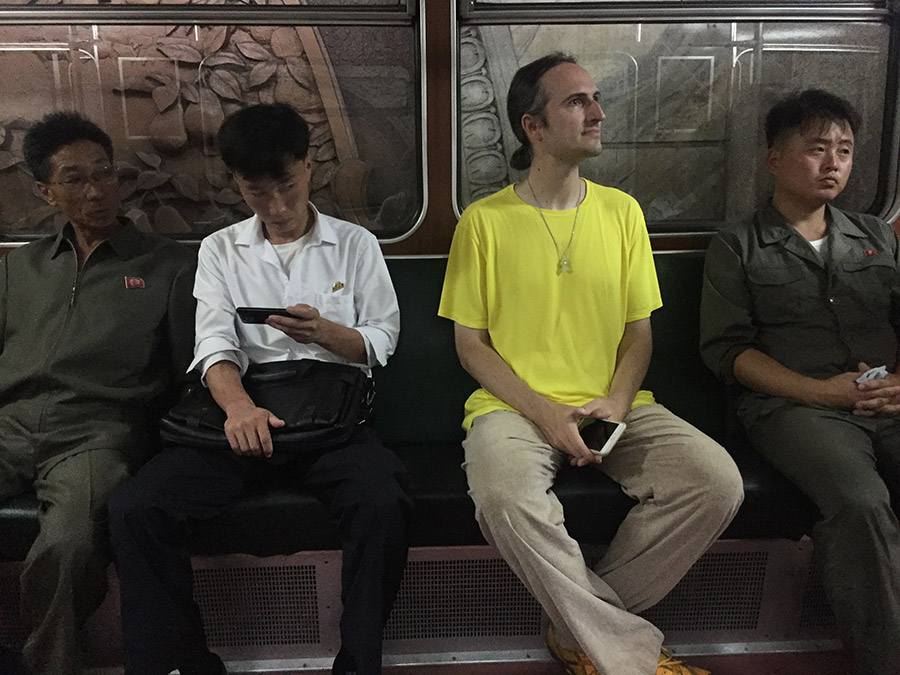
I love how that guy is pretending to look at his phone while he attempts to figure out what in the hell I am. Men in the DPRK don’t wear yellow, or any other colors.
Nancia also got to commune with some DPRK schoolgirls:
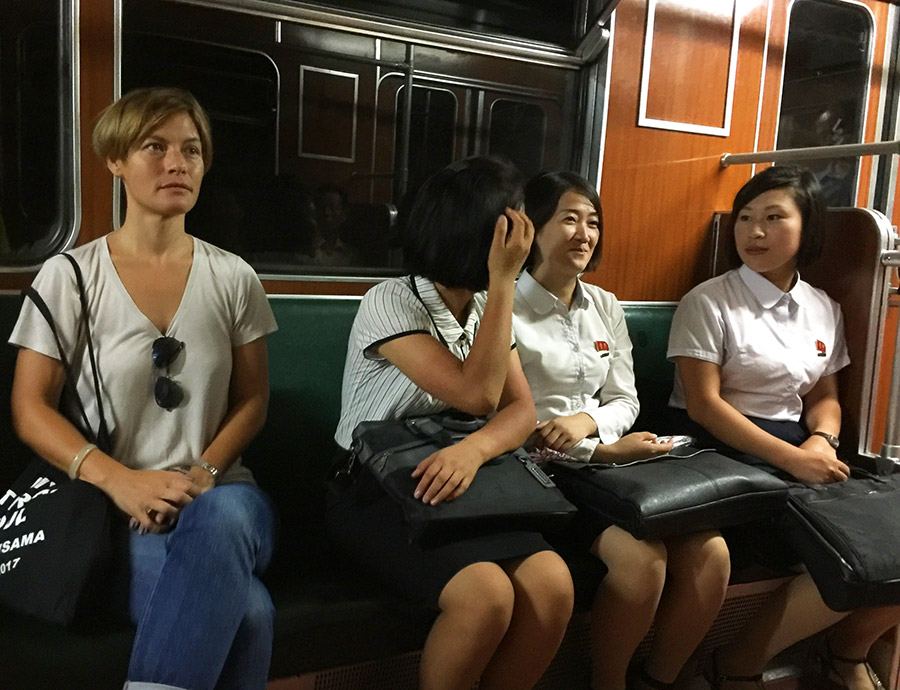
The subway cars had been imported from East Germany in the 1960s and still had German graffiti scratched into the windows. I wonder if any of these North Korean students are studying German?
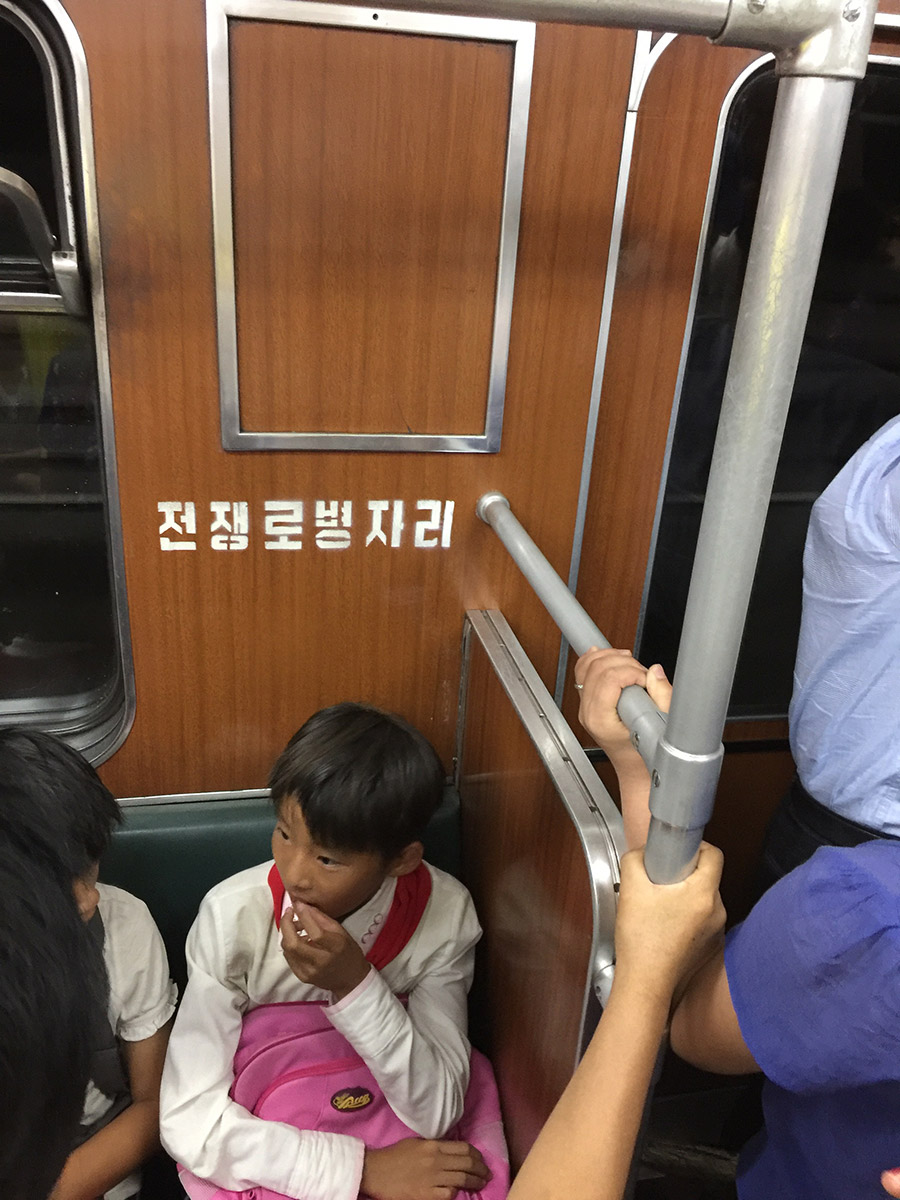
The next station we got out at was just as beautiful.
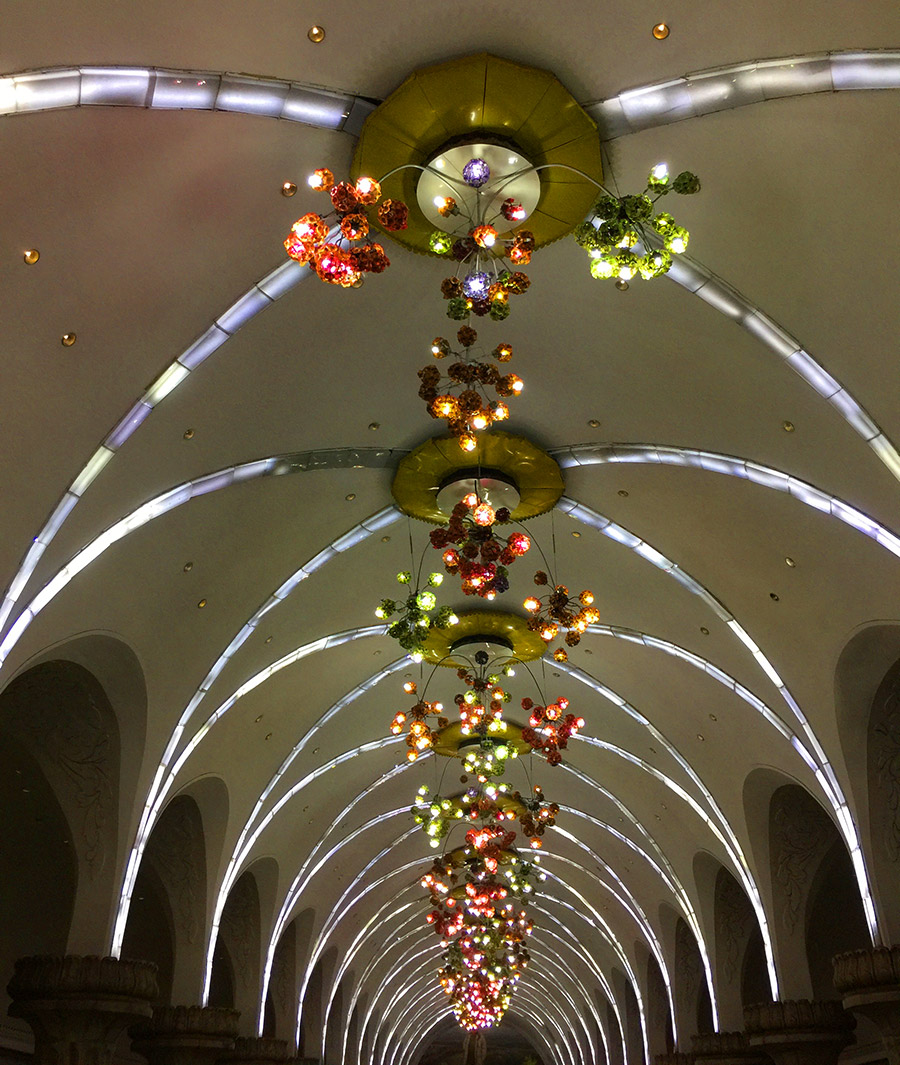
One of the urban legends in the US is that the Pyongyang metro only has two stations. We got out at three stops and passed three others, so I can at least call bullshit on this one. I bought a shirt with a map of the metro route which shows sixteen whole stops.
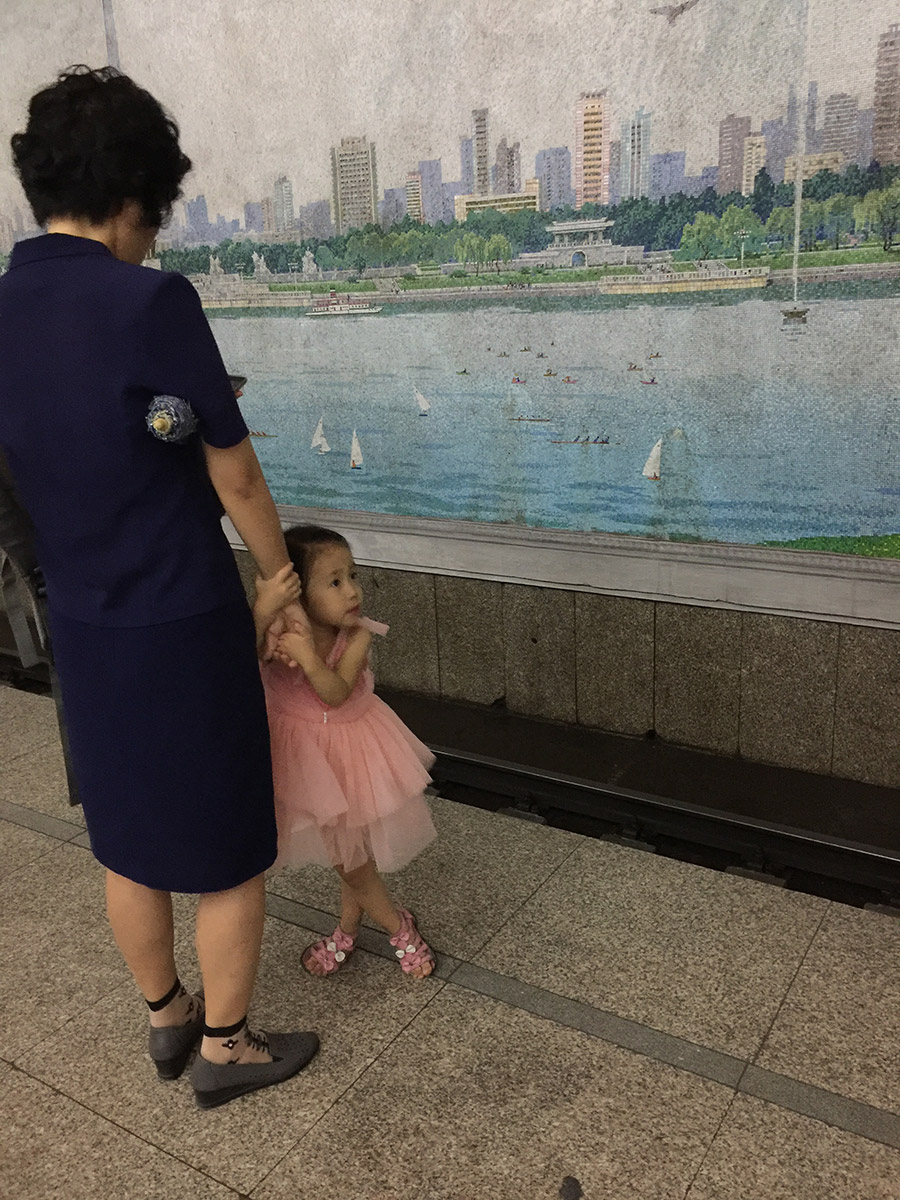
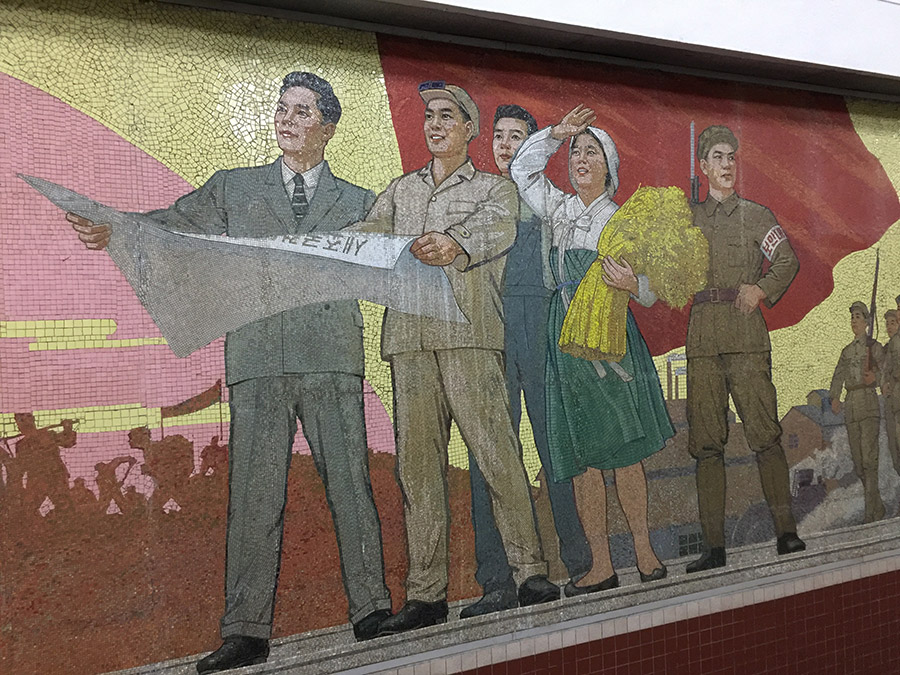
A female soldier stopped me from getting too close to this golden statue of Kim Jong Un.
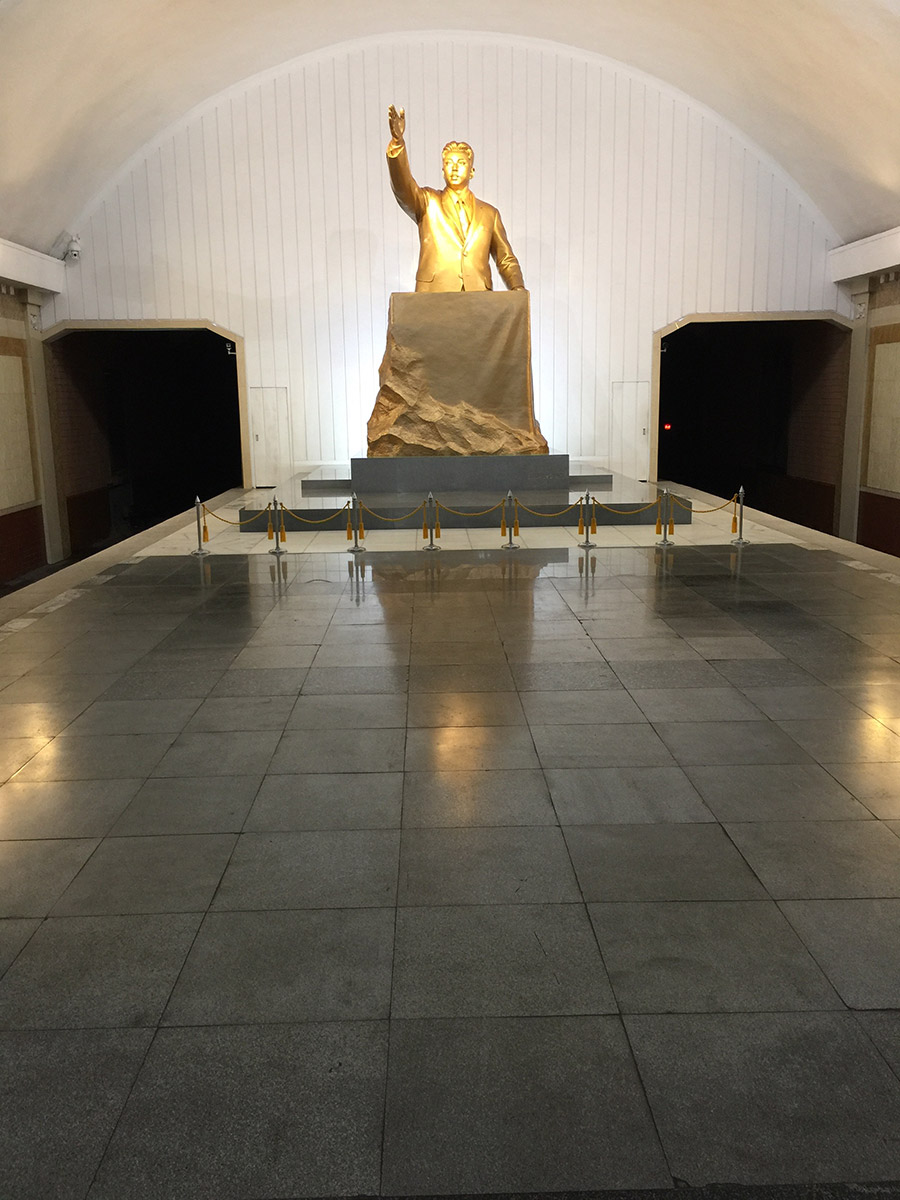
At the opposite end of the platform there was a clock counting down seconds. It seemed unclear if this was counting time since the train left or time until the next train arrived. I took a couple photos of the clock to ponder later.
On my way up the stairs out of the station our senior guide stopped me.
“This one?”
I turned around. He was standing there with a soldier. Nancia instantly denied knowing me for the third time on the trip and disappeared up the stairs.
“Sean, the soldier say you took photo of tunnel, you can delete?”
Oh shit, they meant the tunnel the trains go into. There must be some secret shit in there. Sure.
I unlocked my phone and showed the soldier as I deleted the photos I’d took of the timer next to the tunnel.
The funny thing about this is that for all of the police-state aspects of the DPRK, they don’t understand how smartphones work. When you delete a photo on the iPhone it just goes into your recently-deleted folder for 30 days. I restored all my deleted photos on the flight back to Beijing.
I walked up the tunnel with our guide.
“Sorry about that, why can’t we take photos of the tunnels?”
“I don’t know, they just tell us,” he answered, maybe truthfully.
So it wasn’t the corridors with the bomb shelter blast doors they were worried about at all. Well hot damn, I’m going to get a picture of those then.
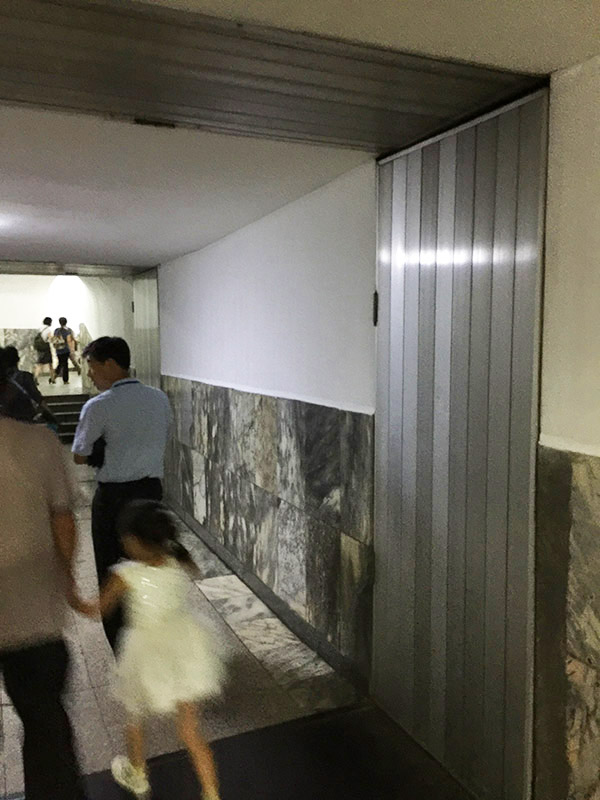
One of the other things I’d been geekily excited about before the trip was going bowling with North Koreans. Nothing seemed more counter to the expectations of what a visit to the country would be like and what you’d be allowed to do. As we entered the Golden Lanes Bowling Alley I stopped to look at the sad concrete bowling ball “decorating” the entrance to the building.
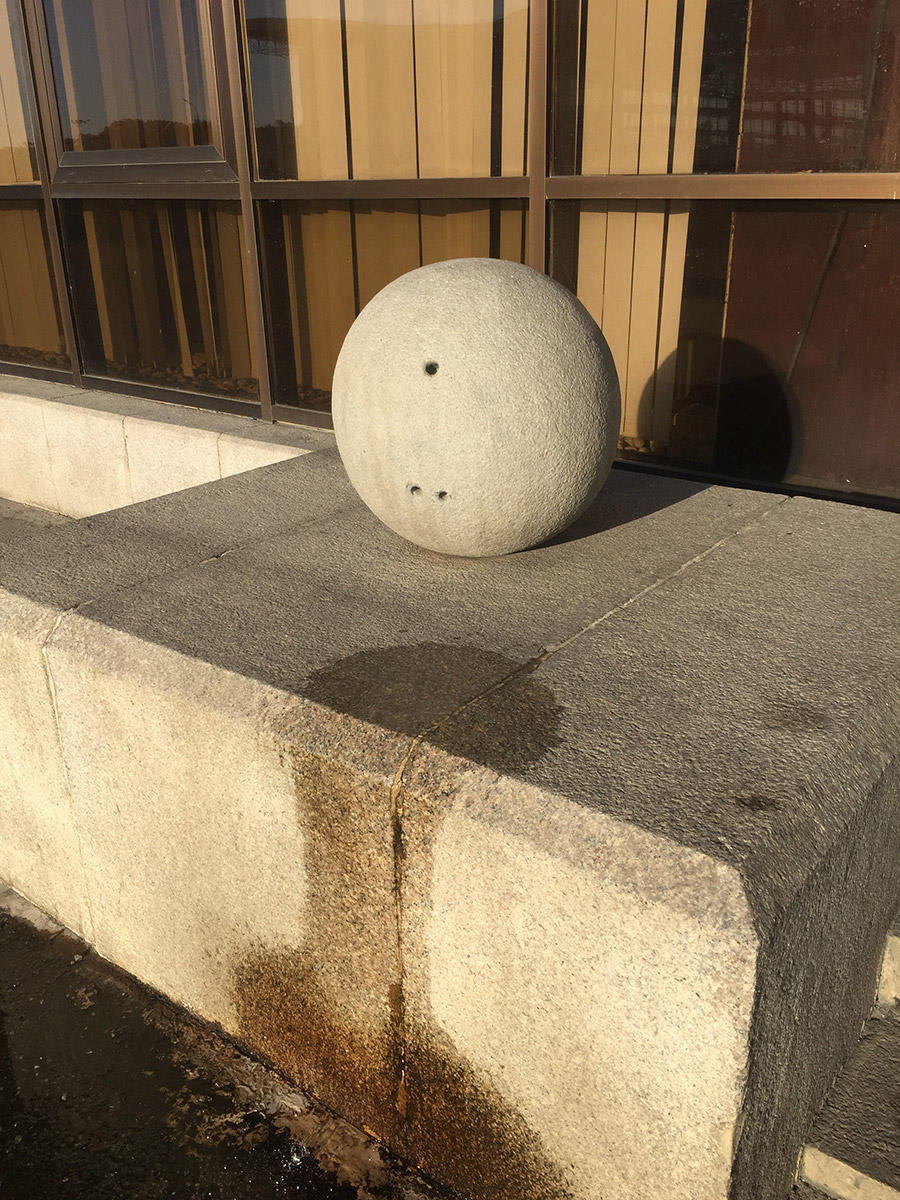
Inside it was a fairly normal bowling alley.
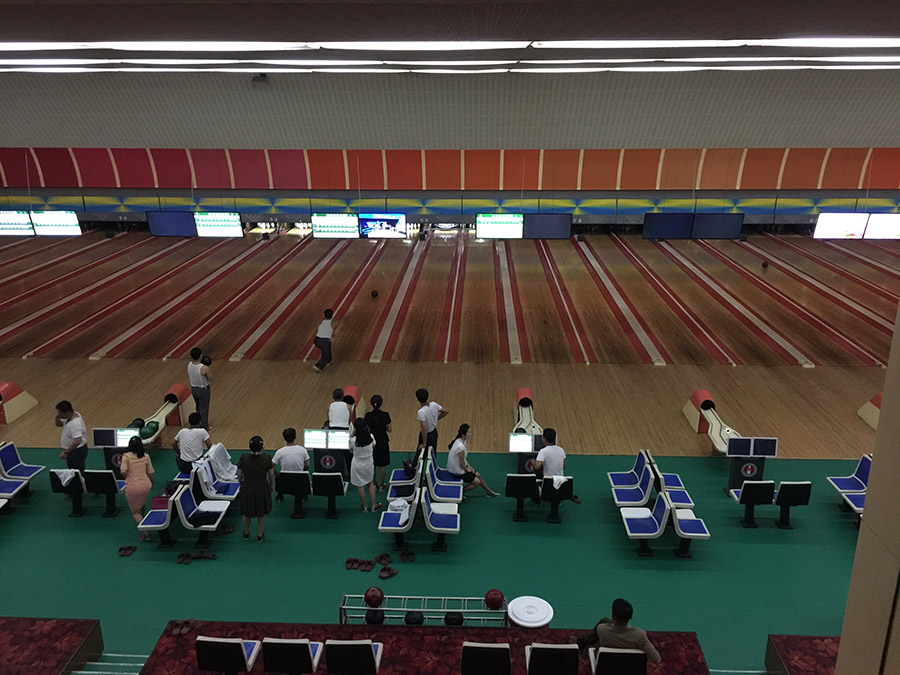
We paid for a few lanes and began the arduous march of finding big enough bowling shoes. Eventually I found a pair that fit my size 13 feet, and they were beautiful to boot:
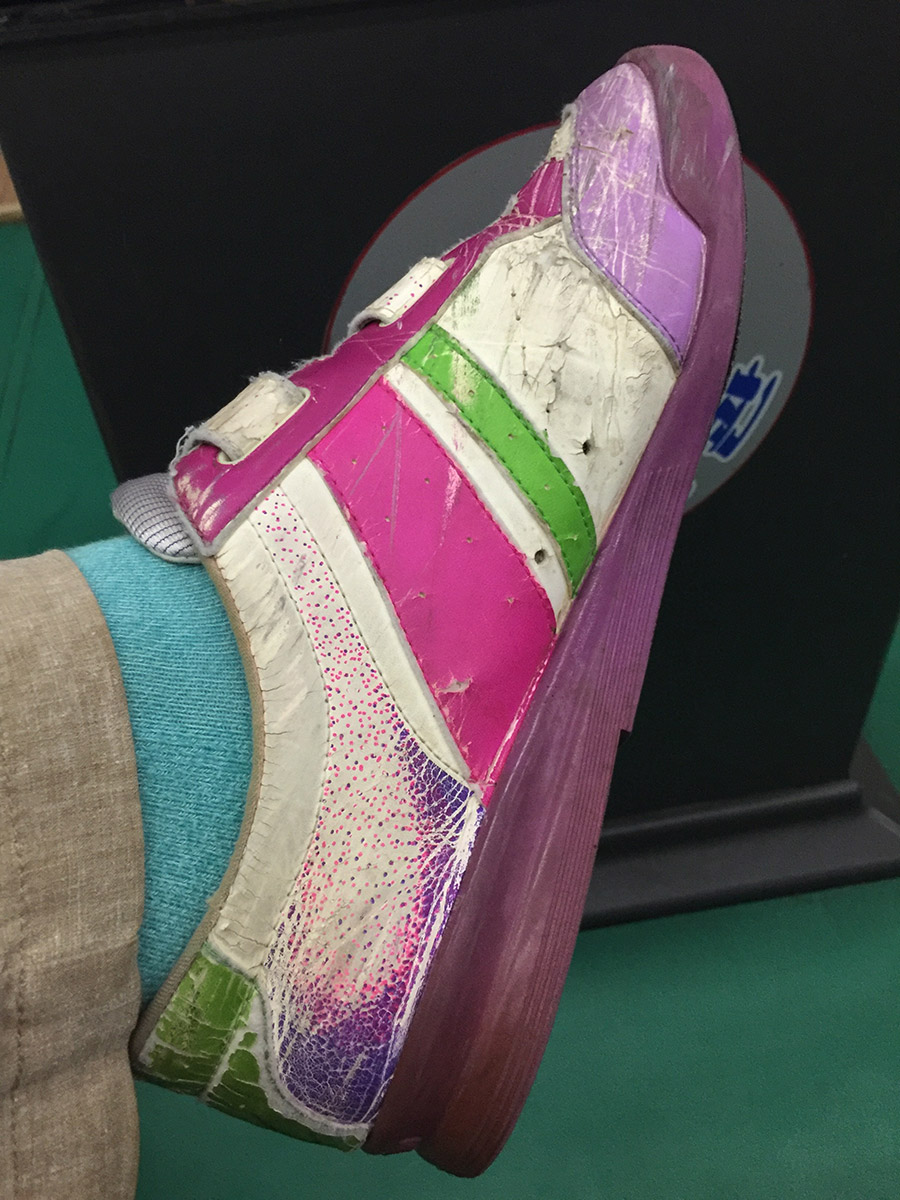
The actual bowling was slightly heart-breaking in that the balls were not drilled for Caucasian hands and the grip was what you’d use to hold a Dixie cup. By the end of the long series of gutterballs I was nearly crippled and the filthy ball had left soot all over my bright yellow shirt. I went into the men’s room to wash my hands, but needn’t have bothered since there was no soap in there. I smeared the filth around on my hands for a minute and went back outside.
At one point we were turned loose inside a department store in Pyongyang. Foreigners are forbidden from having any North Korean currency, but for some reason it was allowed in this one store. A woman inside a tiny wooden booth would take your Euro coin and give you one of each of the DPRK won bills. The 5000 won note had Kim Il Sung’s face on it. I was kind of surprised the smaller bills did not. After you were done shopping you were technically supposed to exchange any won you had left back into foreign currency and not sneak them out of the country in your sock, but this is lightly policed.
The store itself was a strange mix of everything, like if Sears had sex with a K-mart and a grocery store and the top floor was also a food court for some reason. It was simultaneously fascinating and sad. Take a look at the washing machines here, turn around and this counter is sort-of a pharmacy, over here you can buy peanuts. In the grocery area you could pick out fish from an aquarium, like at a lobster restaurant. They were refrigerating huge bags of sunflower seeds. The one item that had a security cable attached to it was the ginseng honey.
There’s a bit of dissonance as you realize that this is where the North Korean elite shop. Only those well-connected to the party can get a bowl of cold noodle soup upstairs, then walk 50 feet over and buy a toilet. One of the drink dispensers in the food court showed an image of bright red watermelon juice over a cascading tank of absolutely clear liquid. In the clothing area you could buy what I imagine to have been a fake Rolex under glass while a worker on a ladder patched a hole in the ceiling over your head.
As always I was drawn to the horrifyingly tacky, so I made several passes by the housewares counter where they had a huge plastic clock shaped like a chicken.
Most people I talked to in America expected everything I saw in the DPRK to be staged, essentially thousands of actors pretending to be living the good life in this socialist utopia. I found this theory unlikely for several reasons, but the most basic of which were the bathrooms. I’m pretty sure that before they hired tens of thousands of actors to snow us, they would have made sure there were at least a few functioning bathrooms in the country. The three basic elements of bathroom functionality are (1) bodily fluids kept where they’re supposed to be, (2) water in the sink (3) soap in the sink. Almost every bathroom I used in the DPRK failed at least one of these tests.
Most often, there was just no soap in the sinks. Which isn’t great, but this quickly became my favorite DPRK bathroom defect. No water? I call it city-camping. Both of those were picnics compared to walking through puddles of urine all over the floor. The men’s room at the Pyongyang Circus managed to pull off the hat-trick of collecting all three defects in one place.
On our tour, the informal punishment for being late was that you had to stand up in front of the whole bus and sing a song or tell a joke into the karaoke microphone that I didn’t know the bus had until one of our guides just suddenly started singing into it one day. When it was ever-late Mike’s turn to sing, he treated us to a charming rendition of the Australian National Anthem. I think so anyway, I don’t know what the Australian National Anthem sounds like, he might have just been improvising a song about Australia. I was laughing about this until I suddenly realized I might be next and I had no idea if I could even sing the entire Star Spangled Banner. Part of me was mortified while another part of me hoped it would come up because there could be nothing more surreal in my life that driving through Pyongyang on a bus, belting out the Star Spangled Banner into a reverb laden mobile karaoke system. Thankfully for everyone else on the bus and for me staying out of prison, I got my shit together and this never came up.
We took a bus out to Nampo, a port city on North Korea’s west coast. The entire purpose of this was to see the Great Western Barrage, a dam that prevents salt water from backing up the Taedong River from the Yellow Sea. We stopped at the anchor-shaped visitor center on P’I Do Island to marvel at… uh, a dam.
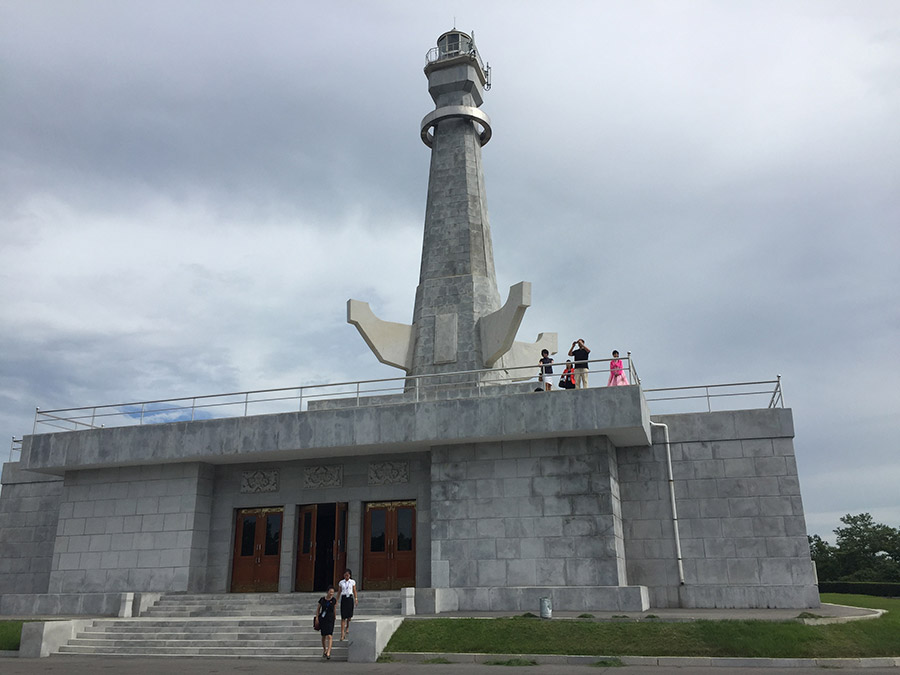
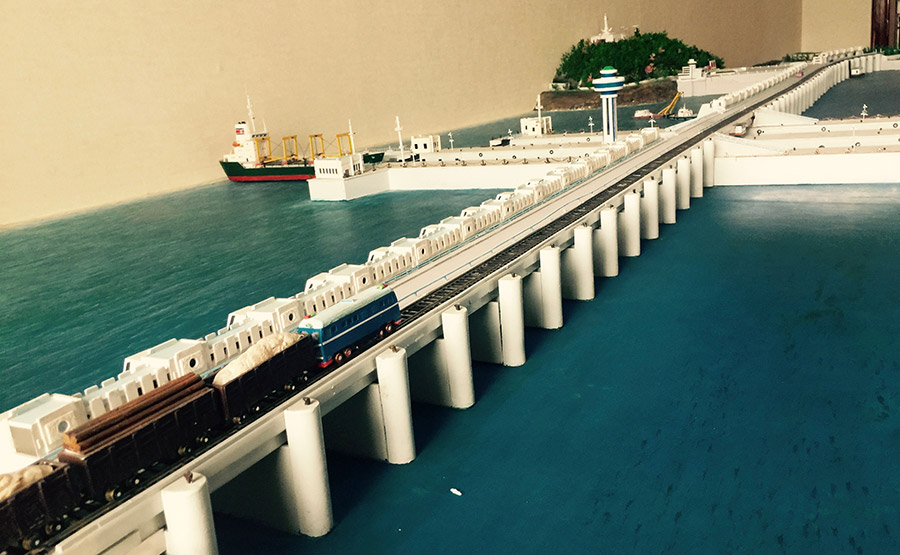
The actual dam was seriously so unimpressive I forgot to take a picture of it.
This was one of the more surreal experiences on the trip, since this dam is presented as one of the greatest engineering feats in the history of mankind. Inside the visitor center we watched a DVD about the dam’s construction for about 40 minutes. This was a fascinating piece of propaganda. The video started out with black and white footage of workers beginning construction of the dam. At some point it was mentioned that this was in 1981. Wait, why is the footage in black and white in 1981?
The construction of the dam is presented as a great triumph of perseverance for the Korean people. Endless footage backed by inspirational soviet men’s-choir singing showed workers toiling in the rain, falling down repeatedly in the mud. What? Why are you doing this work in the rain? Why don’t you have any equipment? It’s 1981 for Christ’s sake- never mind.
The video made it clear that Kim Il Sung had personally designed the dam and guided the workers every step of the way, which, of course he had. It ended with the nugget that people come from all over the world to marvel at this singular accomplishment. Well, I mean, that’s not totally untrue since here we are, but it was a mandatory part of the tour!
We were confused by all of this. They know that every country in the world has dams, right? They have to know- maybe they don’t know. I’m no expert on dams but it’s the kind of thing you pass every two minutes in any other country and aren’t especially impressed by. I mean, I guess it’s impressive that they seem to have built it with 1920s technology. But this was another piece falling into place in understanding North Korean propaganda. All the elements were there, the wise guidance of Dear Leader, the people struggling and falling down and sacrificing themselves for the greater good but persevering, the underdog nation shocking the West with their superior accomplishment, etc.
Oh, minor detail: many outside observers blame the dam for the massive flooding that destroyed the DPRK’s crops during the 1990s and led to the famine that killed somewhere between 200,000 and 3.5 million people. The DPRK decided instead that their Minister of Agriculture was an American spy and had him executed.
We headed from the barrage to our hotel outside of Nampo. Cranes streamed through the sky above us, toward a hill in the distance. When we got there, the hill was covered in thousands upon thousands of white cranes. I thought about asking our guide if they were geese.
The hotel compound featured several houses arranged in a circle with a loop road in the middle. We’re in another compound. Julien and I got to our room and I hopped onto my bed. Have you seen that YouTube clip where the guy tries to cannonball into a frozen pool? This was that. I hit the bed and splatted like pancake batter on a griddle. The bed was literally a board. Okay then.
One of the selling points of our trip to Nampo was the Petrol Clam BBQ. No one knew what this meant, exactly, but it sounded intriguing. It ended up involving our guides carefully arranging hundreds of clams ass-up on a circular stone platform, spraying them with gasoline, and then setting the whole thing on fire. This seemed like a quick, if drastic, way to cook clams and get cancer. But it actually took about an hour of constantly spraying gas on the clams from a water bottle with a hole poked in the lid. Every time I stopped filming for a second, the flames would climb up the stream of petrol and spectacularly catch the water bottle on fire.
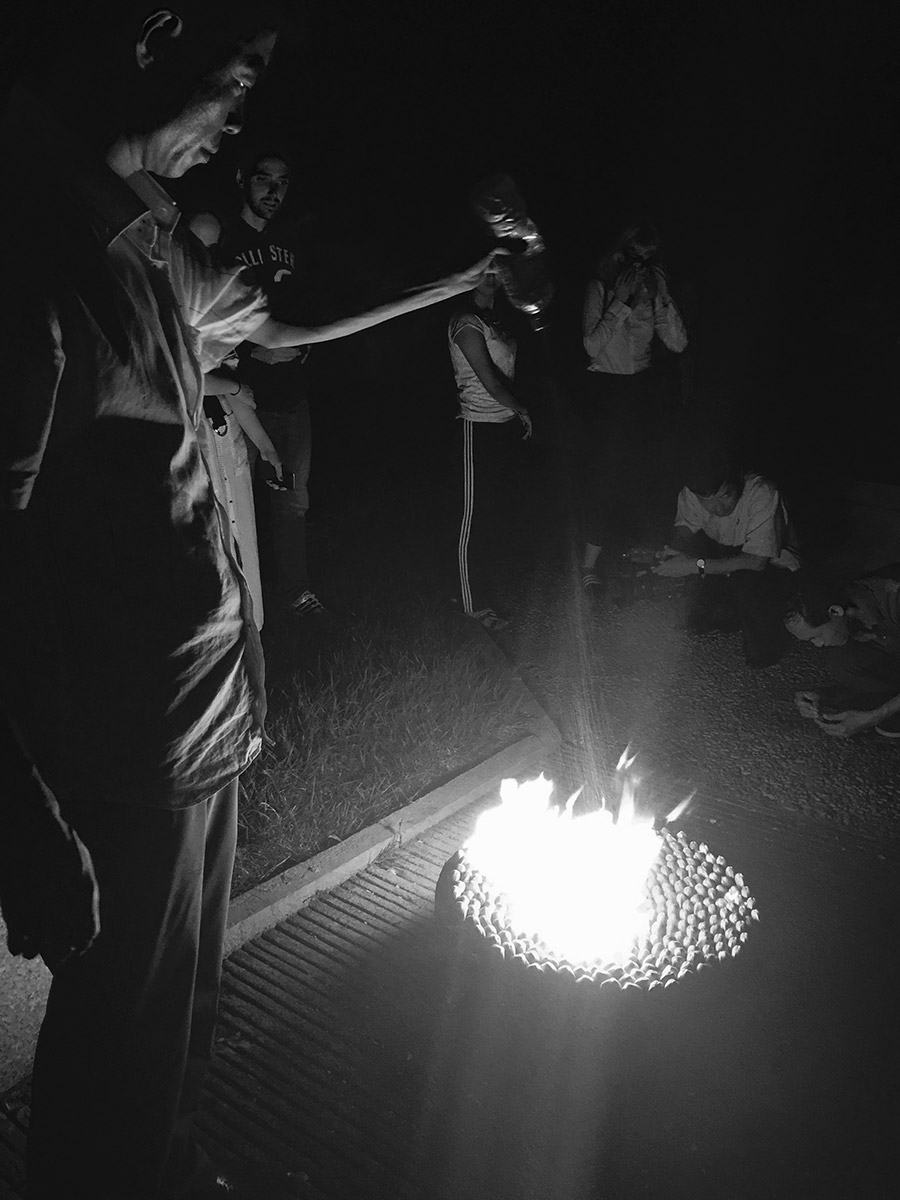
Eventually the clams would open and spurt, indicating they were ready to be very gingerly picked out of the fire and tossed around frantically from hand to hand as they were bitchin hot. After paying this price in pain you had an itty little clam to eat. Everyone said they were great, I wasn’t touching that shit.
Back at the dining hall, the non-Mad Max food was inexplicably great. We’re having crepes in Korea? We’re having crepes in Korea!
Every meal on the trip was served with beer, those of us who didn’t drink were constantly negotiating the beer-to-water exchange rate. Water was a strange commodity in that it was never free, but you also never had a bill small enough to buy a single bottle of water. Whenever I paid for water with a dollar or a Euro, they’d fumble around for a few minutes looking for change, then give up and give me my “change” back in the form of five more bottles of water. I spent a lot of the trip walking around with every pocket bulging with several cold, weeping bottles of water.
The girls told us about their beds, which came with blood-stained sheets. Hmmm.
After dinner we hit the hotel’s rec rooms. One wall of the pool room was lined with booths and a projector for some kind of Big Game Hunter style shooting video game that didn’t work. The next room over was a gigantic ping pong hall. The night gradually progressed into elaborate ping pong grudge matches with our very drunk North Korean guides. This was hilarious.
Turning in for the night, the bedroom was pitch black. Julien told me about how if the room’s too dark, he sometimes wakes up to terrifying hallucinations so if I woke up to him screaming, that’s what was going on. Yeah okay let’s leave this light on.
I laid back on the board and tried to find an angle where none of my bones were pressing into the wood.
The other selling point of this hotel were the hot springs mineral baths in every room. This involved a large tiled tub in the bathroom that had never, ever been cleaned. In the morning I decided to give this a shot. Turning a knob on the wall, smoking hot water barfed out of a hole in the wall and gradually filled the tub. They’d warned us not to spend any more than 15 minutes in the water since this would cook you like a stew. Stepping gingerly into the water, I spent the entire 15 minutes trying to figure out which side of the “this is actually burning my skin right now” line the molten water fell on. On the plus side, any soreness that I may have had from running down the mountain died screaming in that bath.
By the end of the trip it was becoming clear that the guides were way more interested in some of us than the others. “They only care at all about you and Arielle and Vince, the Americans,” Francine from Mexico wryly observed. Hmm, why was this? Were they hoping to get sensitive American government secrets out of us? Were they waiting for us to break bad? The next day I caught our senior guide talking to Francine. Aha! He was asking her what America was like. Hmmm.
One of my favorite bus moments was eavesdropping on Francine trying to show our senior guide one of the Fast and Furious movies. I don't think the concept of an anti-hero translates into North Korean. “They’re the good guys. Well they’re bad guys but they’re stealing a car from the really bad guy.” He kept trying to fast-forward past the action scenes. Dude, that's all there is.
Late into the trip we visited a restaurant that featured dog on the menu, and Mike gave it a shot. He said it tasted like bad mutton, and he seemed to feel a little guilty about the whole thing afterwards. I just now realized Mike probably doesn’t want the whole world to know he ate somebody’s dog. Sorry Mike, I don’t know where the delete key is on this thing.
August 15th is celebrated in the DPRK as Liberation Day, the day Kim Il Sung liberated the country from Japanese colonial rule, which did not happen. You could fairly argue they were liberated by the USSR, which invaded Korea from the north and rolled over the Japanese forces stationed there, or if you’re a fan of irony you could argue they were liberated by the United States’ defeat of the Japanese in WWII. For understandable reasons they gloss over that part in the DPRK.
One of the primary features of Liberation Day was our visit to the Mansudae Grand Monument, the huge bronze statues of Kim Il Sung and King Jong Il.
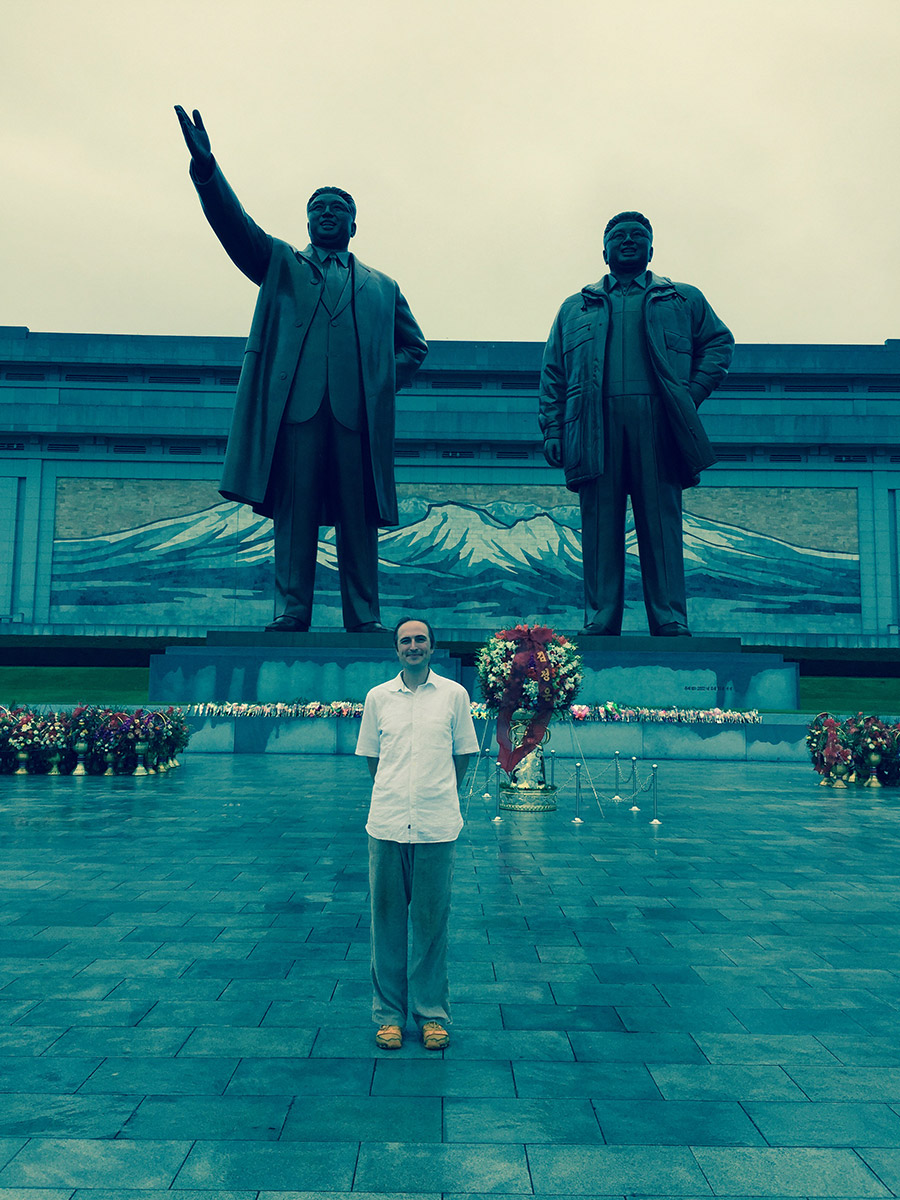
First thing’s first, these statues are much, much bigger than you think they are. They’re absolutely gigantic. They look smaller than they are in photos because you’re not allowed to get very close to them unless you’re laying flowers at their feet. Our tour group ponied up for a bouquet and we all bowed in unison, as is the tradition.
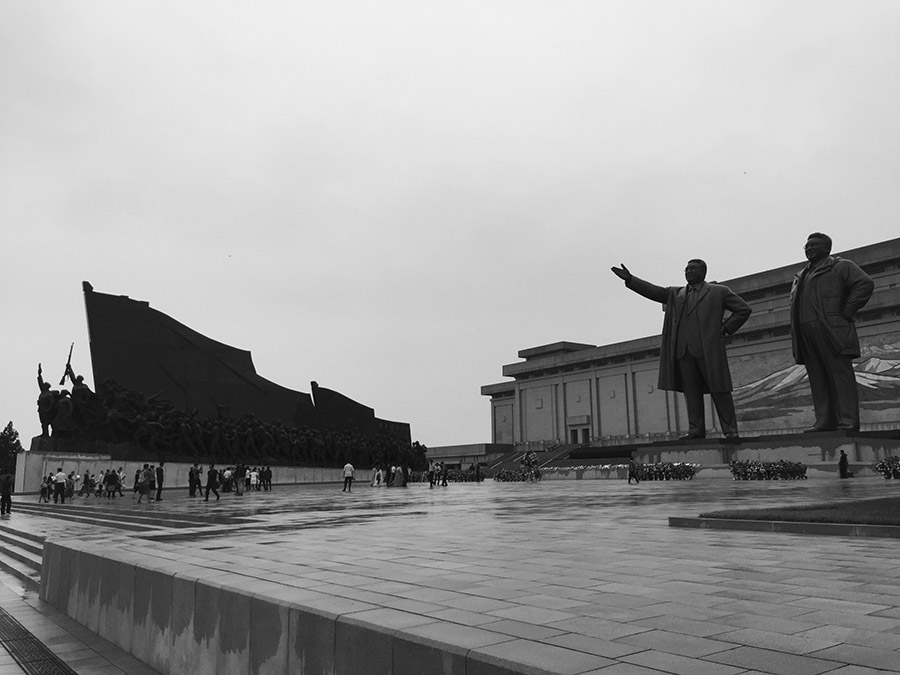
The funny thing about all the statues of Kim Il Sung and Kim Jong Il that we saw all over the country was that we were told that Kim Jong Il didn’t allow any statues of himself to be built while he was still alive. If this was true, they were all built after his death in 2011. This means that in all likelihood, there were statues of Kim Il Sung in all of these locations first, then Kim Jong Il died and not only did they have to add a second statue in each spot, they had to move the huge Kim Il Sung statues over so the pair would be centered together at the monuments, instead of having Kim Il Sung in the center and Kim Jong Il off to one side like a backup singer.
For the first few days of the trip, people in our group were having a hard time telling Kim Il Sung and Kim Jong Il apart in all the photos and paintings we were seeing everywhere. My best advice was “Bigger hair? Bigger glasses? Kim Jong Il.”
Kim Jong Un was easy to tell apart due to his stupid haircut.
Next we went to the top of the Tower of Juche Idea.
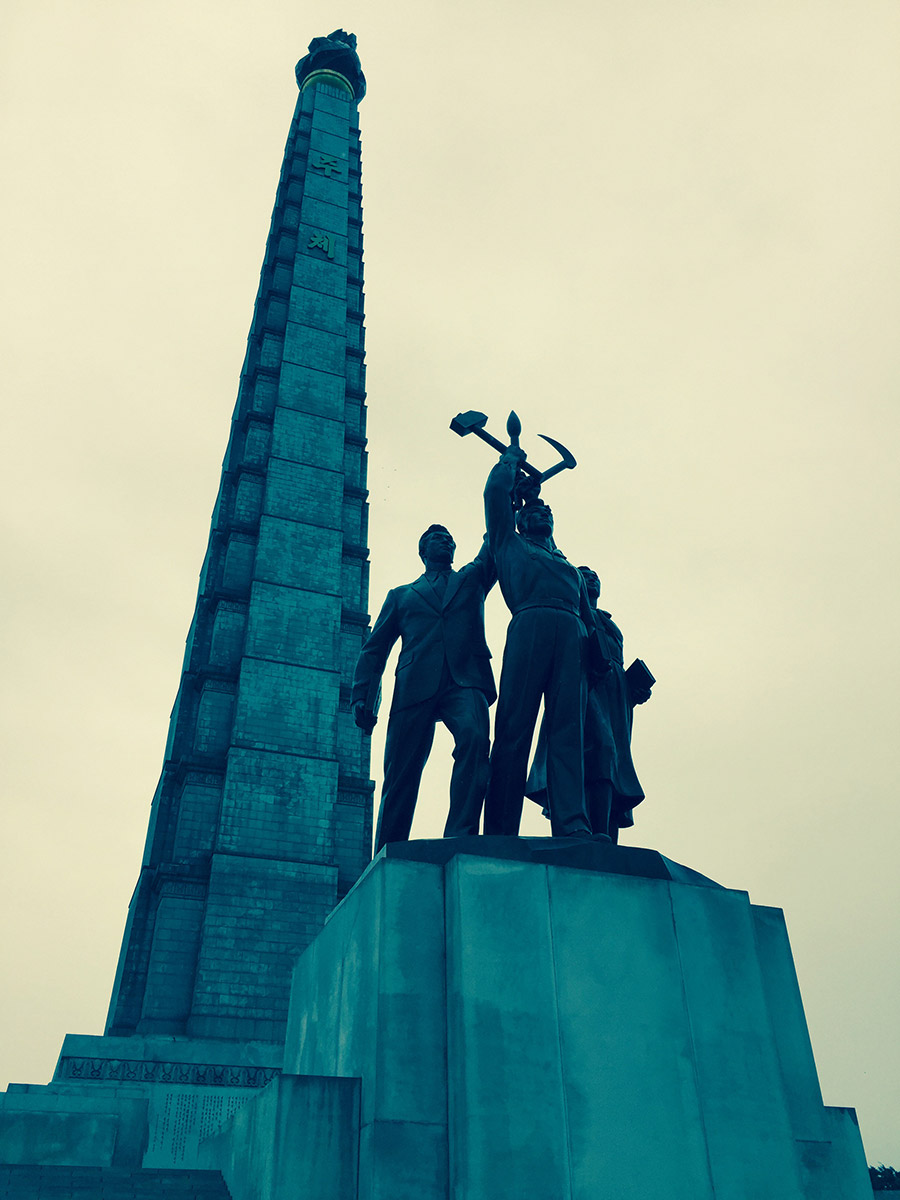
This is the monument to Juche, Kim Il Sung’s philosophy of DPRK self-reliance everyone there talks about nonstop all the time. The best parallel I can draw is to imagine L. Ron Hubbard started a country and everyone there thought Scientology was brilliant and not a bunch of weird nonsense just because their infallible leader wrote it. Absolutely no one understands or can summarize Juche. I was however amused by the abrupt shifts in tone between talk of Juche self-reliance and how pissed off the North Koreans were about the recent UN sanctions, which are just forced self-reliance.
From the top of the Juche tower, we enjoyed a wonderful view of all of Pyongyang.
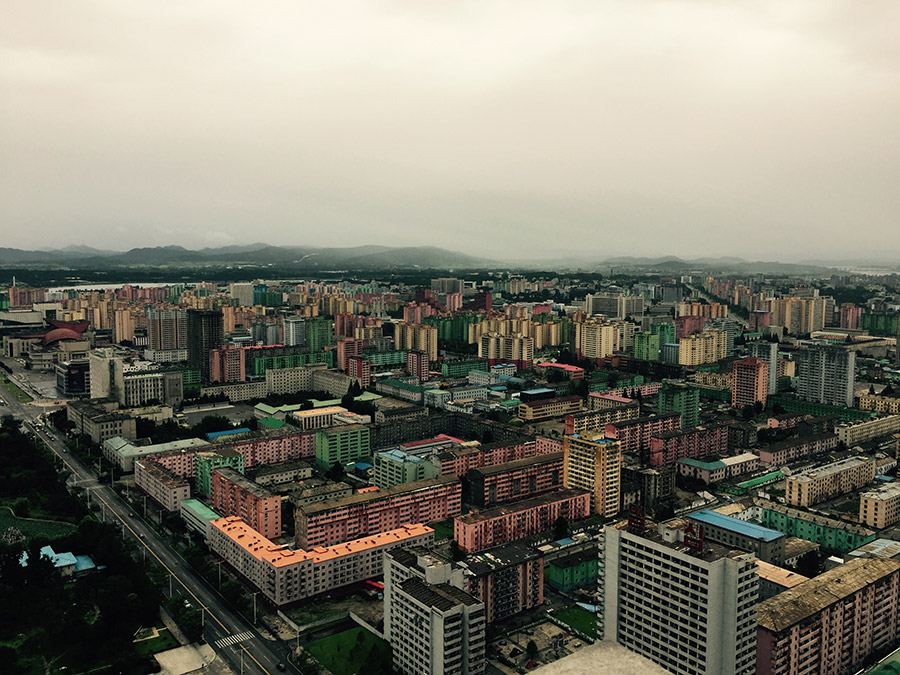
We were admiring the colorful array of buildings in the city, which inspired one of our confused guides to ask if our cities weren’t colorful.
“We don’t have a lot of pink buildings.”
“What color are they?”
“Glass.”
The Juche Tower guide explained the dimensions of the tower. I’m paraphrasing since I rolled my eyes so hard I had a seizure.
“The tower was built in honor of Kim Il Sung’s 70th birthday. The tower is made up of 25,550 blocks, one for each day of Kim Il Sung’s life.”
There was some other biographical detail encoded in the number of corners the tower had or how many pigeons, something like that. The North Koreans LOVE this kind of shit. Nothing in Pyongyang is arbitrarily tall or some arbitrary distance from anything else. Everything is the number of meters from here that corresponds to how many kilos Kim Il Sung could bench-press, etc. They wring every last drop of propaganda value out of every possible mundane detail.
We were at the Monument to Party Founding, listening to an explanation of how the monument was 50 meters high to signify the 50th anniversary of the Worker’s Party of Korea, containing 216 blocks in a 42 meter diameter in honor of Kim Jong Il’s birthday on 2/16/42. Walking away, Francine and I overheard Julien just trying to be polite, telling the guide how cool he thought it was that they attached meaning to all these symbolic details.
“Really? I think it’s fucking crazy,” I said, off to one side. I turned and the other guide was standing right next to me. Goddammit.
Anyway, the paintbrush in the monument looked like a giant penis:
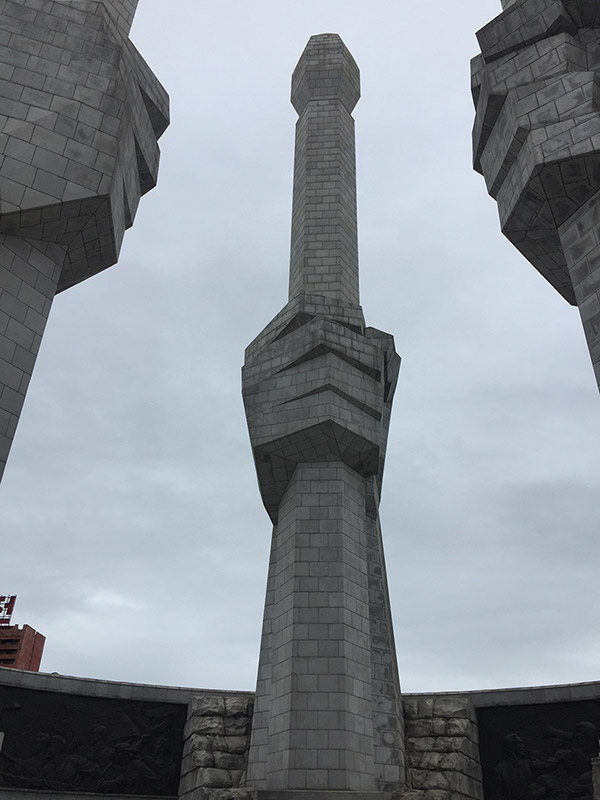
I had another awesome foot-in-mouth moment after satirically paraphrasing our guide’s tongue-twisting descriptions of the philosophies of kimilsungism and kimjongilism for Mike and then realizing that guide was standing right behind me yet again.
They also never fail to mention that this or that building was built in a year. Everything was built super-fast. It’s hard not to note that everything is kind of falling apart and maybe they should have taken their time. They talk a lot about how after the Korean War, the country was rebuilt at “Chollima Speed,” referring to the mythical horse that was fast as shit.
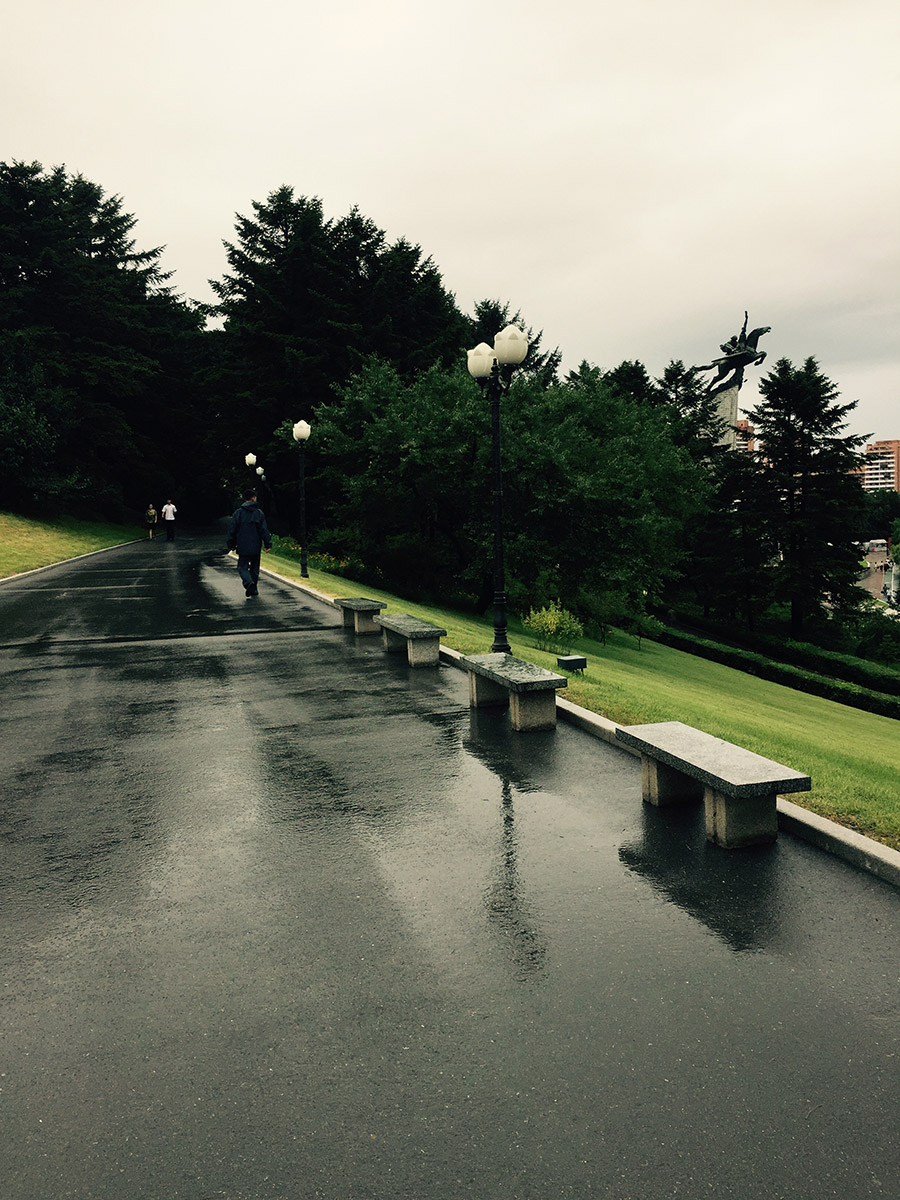
I forget if the workers were required to work at 10x or 100x speed, whatever it was, it was hella fast. They leave out the part where by 1960 the entire workforce was exhausted, the quality of everything they’d built was poor, and national growth fell off a cliff. The government responded by ceasing the publication of year-over-year growth figures. Realizing the problem was the word they’d used for “balls to the wall,” Kim Jong Il later implored the country to work at “Huichon Speed” while Kim Jong Un preferred “Masikryeong Speed.” Sadly, they were beaten to “Ludicrous Speed” by Spaceballs.
We stopped in a little shop for no apparent reason and I was deeply fascinated by all the tacky shit there:
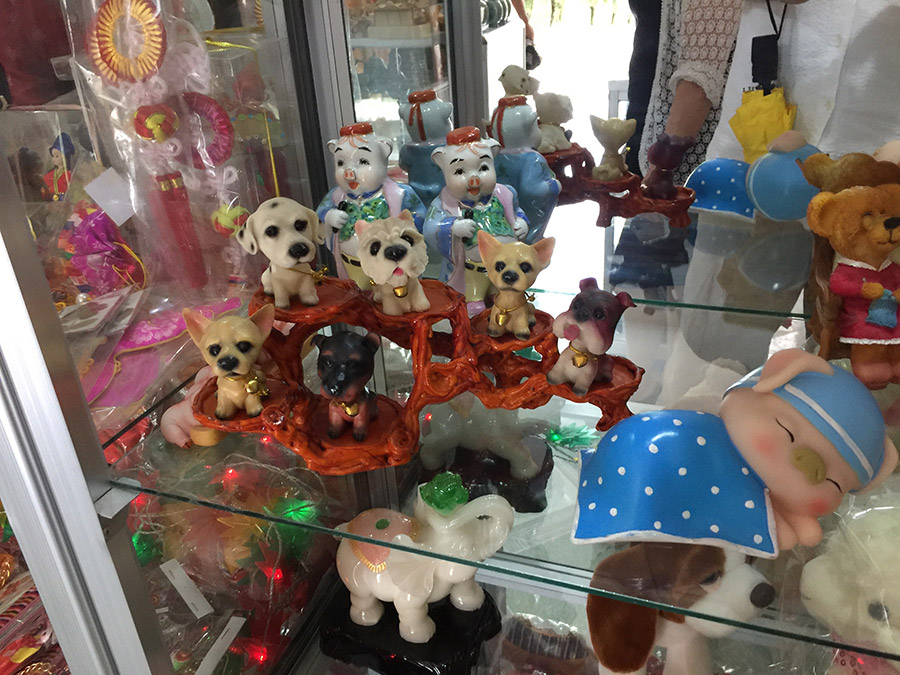
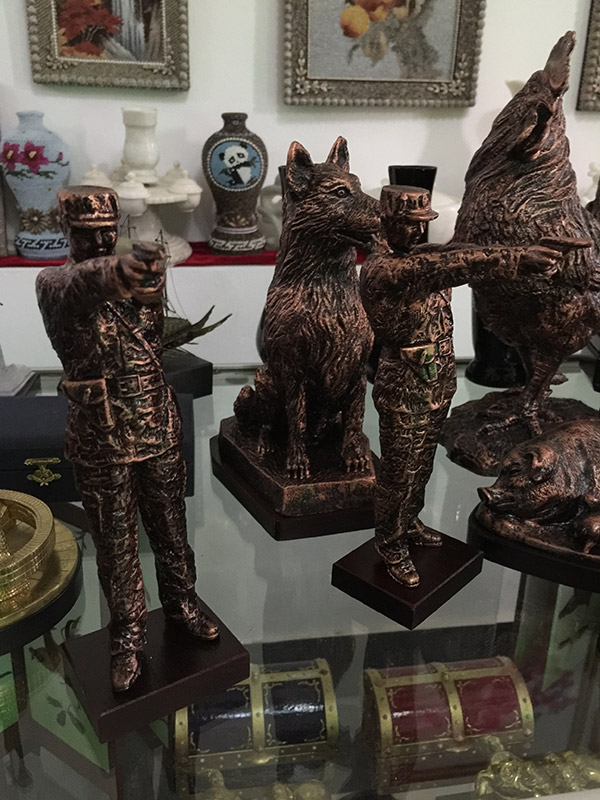
On the way I crossed paths with a tot driving an electric Audi toy car. As mentioned, Pyongyang is home to the privileged.

The big draw of Liberation Day was taking part in a mass dance, when thousands of people dance together in the streets of Pyongyang. Except when it’s raining. We were there on a very rainy Liberation Day and had to settle for a significantly less massive dance under a gazebo in the park. A boombox blasted surprisingly modern music as Korean ladies taught us how to dance in the rain. The French guys were certain it was all staged for our benefit.
Perhaps the highlight of Liberation Day was our visit to the Pyongyang Circus. This is not the “elephant on top of a giant rubber ball” type of circus and sadly there were no North Korean clowns. It’s more like the low-rent Cirque du Soleil kind of circus. It was still fascinating. Children filled the arena and the lights went down.
The actual acrobatics and gymnastics featured in the show are on the level of what you’d see at the circus in any small city in the US. The most interesting aspect of this was when one of the trapeze artists missed a landing and fell onto the net below. Oh my god, are they allowed to do that? Is he going to wake up in a labor camp tomorrow? He climbed the ladder and attempted the elaborate trick a second time. Nancia asked if we were going to have to stay until he got it right. He missed again and fell to the net. The audience began to clap rhythmically in unison as the music built. Waaait a minute, has the crowd seen this before? Is this staged? So much of the DPRK propaganda was about picking yourself up off the mat and struggling through to victory. I think he missed those landings on purpose. The third time through he stuck his landing. Hmmm.
More interesting than all of that, however, were the videos projected behind the performers for the entirety of the show. During the elaborate opening number, when a performer flew in on a rope carrying a gigantic North Korean flag, footage of one of the DPRK’s missile tests filled the screen in the background. Okay! That was strange. Things continued innocently enough, with footage of construction in Pyongyang as performers flipped and spun and danced. Later in the show the performers were suddenly wearing construction worker outfits and the footage switched to some kind of mining operation.
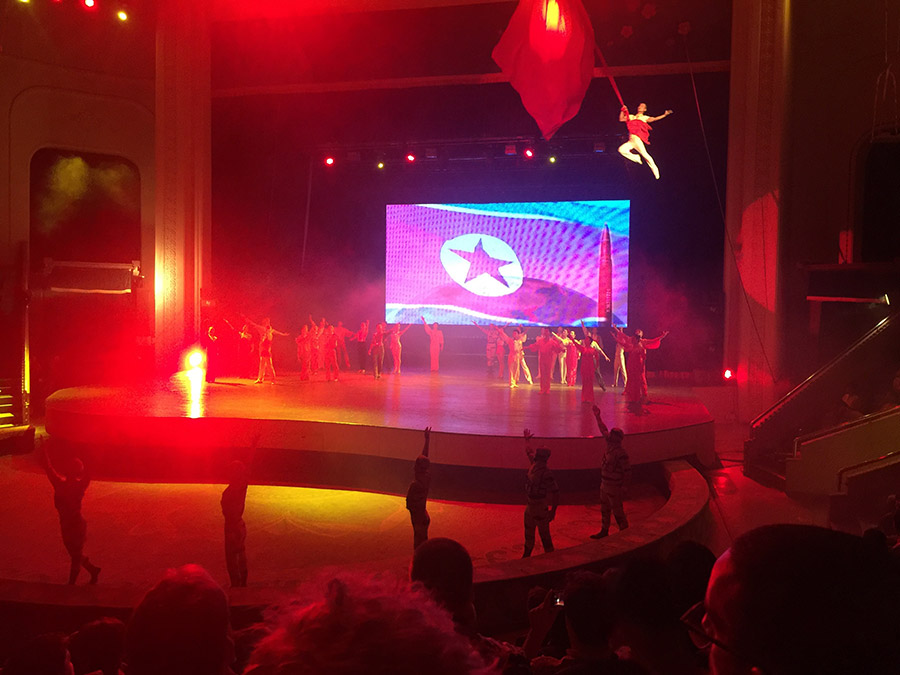
We technically weren’t supposed to be taking photos or video of the performance, and unbeknownst to me, my friends sitting closer to the aisle had been told multiple times by ushers to stop taking photos, but they didn’t pass the word on to me so that they could download my photos later.
The circus saved the (best?) for last, and the last ten minutes of the show featured acrobats dressed as soldiers, performing trapeze and seesaw tricks while footage of tanks rolling and artillery firing filled the screen behind them. This climaxed in an absolute orgy of mayhem on the screen as ICBMs fired, tanks shot, guns went off and hillsides exploded. Smoke filled the arena and the footage just kept rolling. We were all stunned and disoriented.
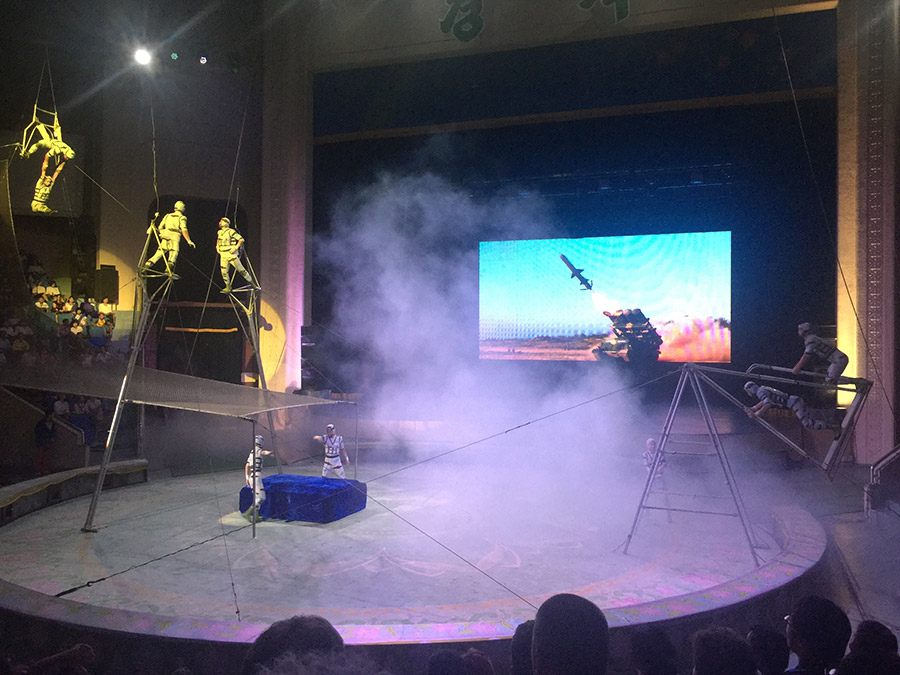
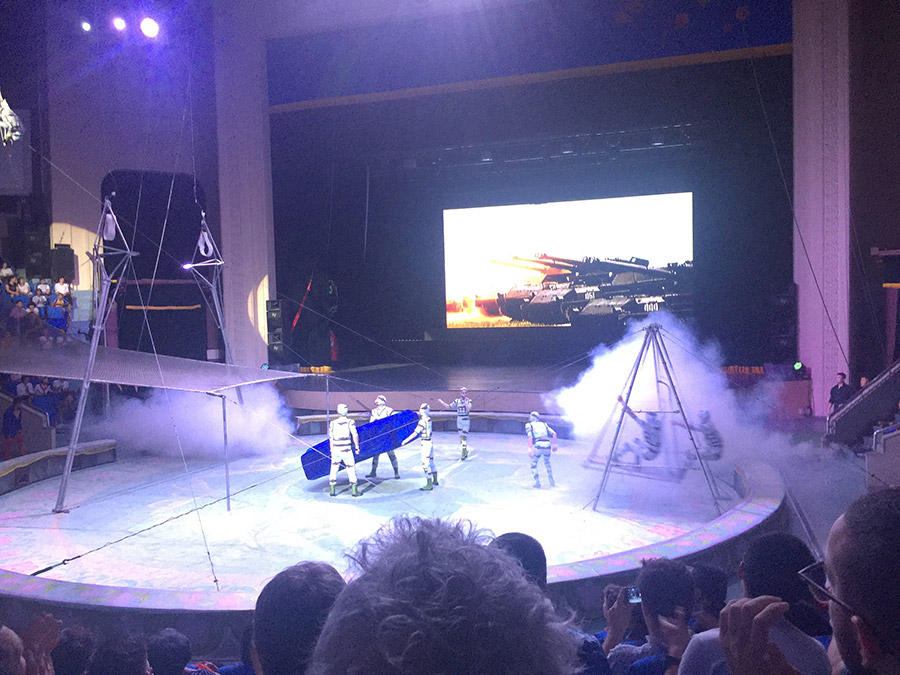
On the bus, our guides asked us what we thought of the circus. Everyone was too dazed to give an enthusiastic answer.
“What’s wrong? Not fun?”
“Our circus at home doesn’t have as many missiles,” I offered.
This started a conversation with our senior guide as he tried to explain the storyline of the spectacle we had just witnessed.
“Army and missile ensures blue skies for the children.”
“All of those crazy explosions were about peace for the children?”
“Yes!”
Everyone on the bus rolled their eyes in unison.
Our guide came over and sat with me and I tried to explain why we thought their circus was fucking crazy.
“This was for children? It was pretty violent for a children’s show.”
This was not translating. Somehow our conversation veered into US sanctions and I repeatedly tried to explain the difference between the US and the UN and how the world community wanted the DPRK to stop shooting missiles everywhere. I looked up and Salama from the Emirates was looking at me with a priceless expression that said “Are you fucking crazy?? Stop talking to him!!”
“We’re just from different cultures,” I offered to our guide, sliding the pin back into the grenade.
Far less disorienting was our trip to the Kaeson Funfair, Pyongyang’s premiere theme park. This was awesome both on the level of milling about freely with a bunch of North Koreans on their time off, and also because I am a child who likes rides.
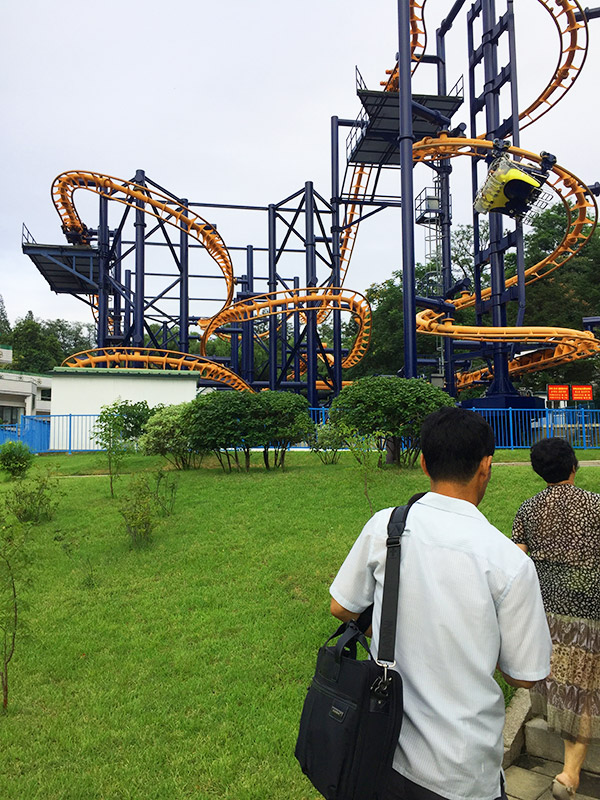
Whenever we wanted to go on a ride, the employees would cut us straight to the front of the line and we’d climb on. This seemed weird but (1) I’m certain we were paying 20x what any of the North Koreans were paying to ride the rides and (2) the North Koreans seemed fascinated by our presence and not in the least bit put out.
The rides were scarier than I had expected. Only part of this was because I was certain the DPRK has absolutely no safety standards whatsoever. If one of these rides had collapsed last week and killed a thousand people, how would I even know?
Our first ride was a roller coaster you laid down on and flew like Superman:
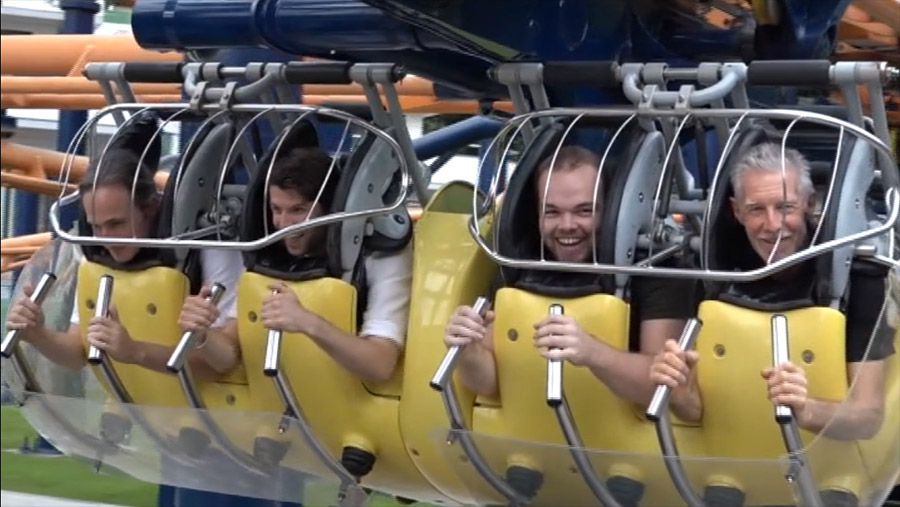
I usually don’t hold on when I’m on a roller coaster since it’s more fun that way. One second into this ride, it became clear that holding on was absolutely necessary for survival if you didn’t want to fly sideways out of this metal sandwich.
Next we rode on a huge twirly thing that swung back and forth, up above the tree tops. Everyone watching told us later that they swung the ride much higher when we were on it than they had for the all-DPRK group before us. I felt a little bad for the two North Korean schoolgirls sitting next to me who didn’t know they were getting the American Imperialist Special.
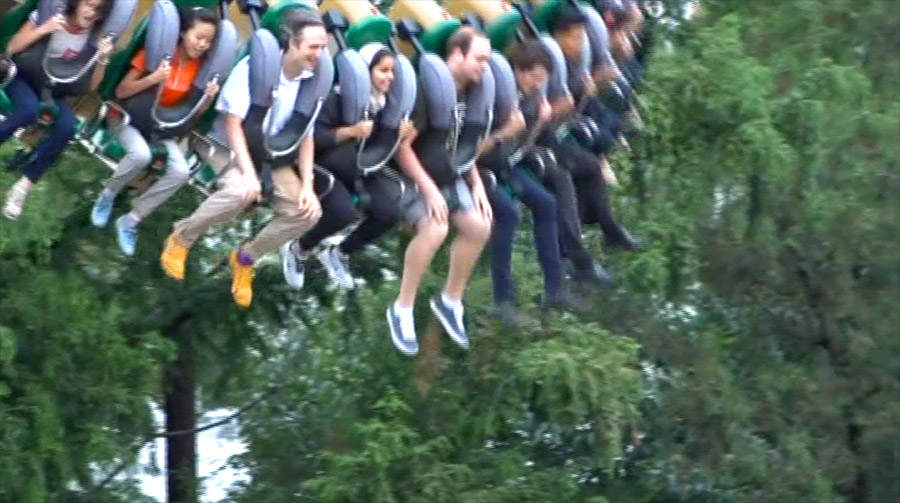
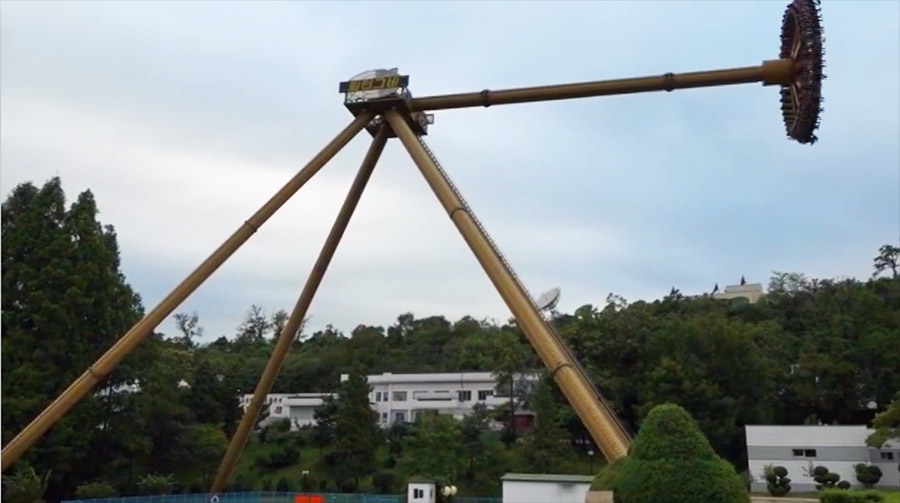
We took a twirl on the bumper cars, and I crashed right into a North Korean guy and his young son, which was super-awkward.
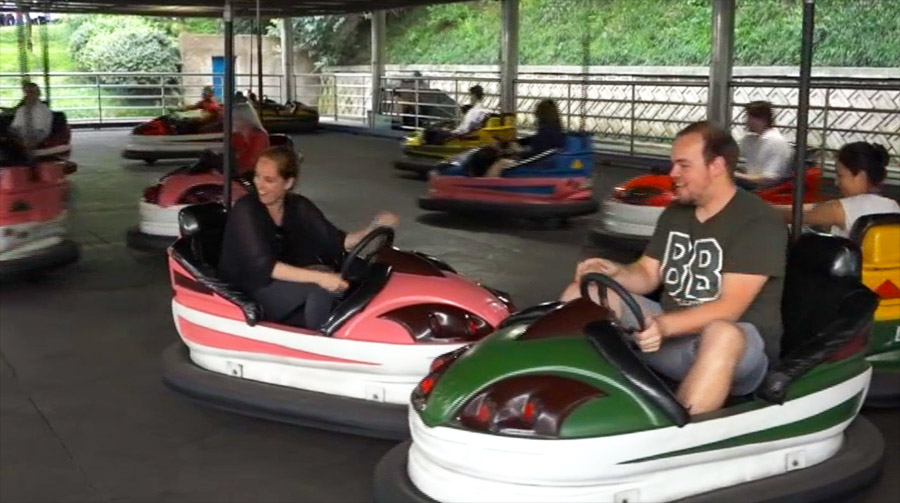
The centerpiece of the park was a giant freefall ride. We strapped in and the Asian-sized safety equipment slowly crushed me into place.
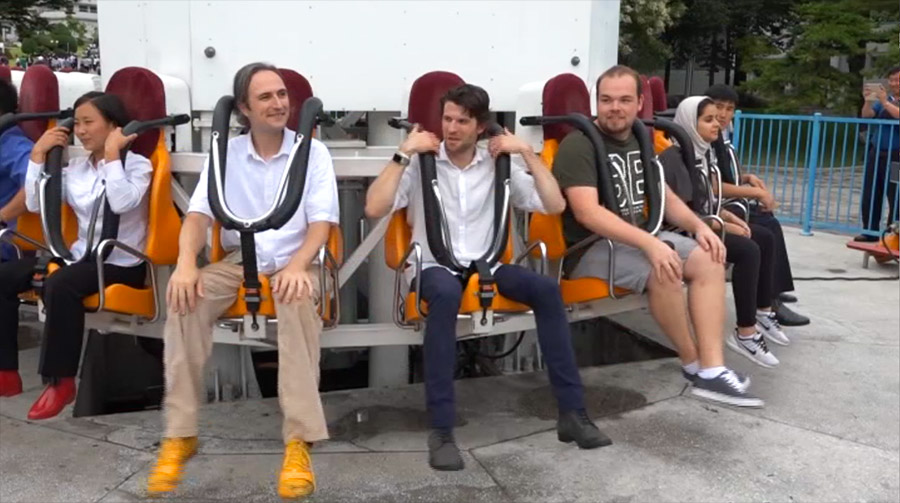
Suddenly and without warning, the ride shot straight up into the sky, much faster than anyone was expecting. This was pretty scary. The view from the top was fantastic.
We stopped at the top. For a really, really long time. The anticipation was killing Julien. The ride started making a weird sound and I wondered out loud if it was supposed to be making that sound.
“Shut up! It is absolutely supposed to be making that sound! Shut up!”
We dropped.
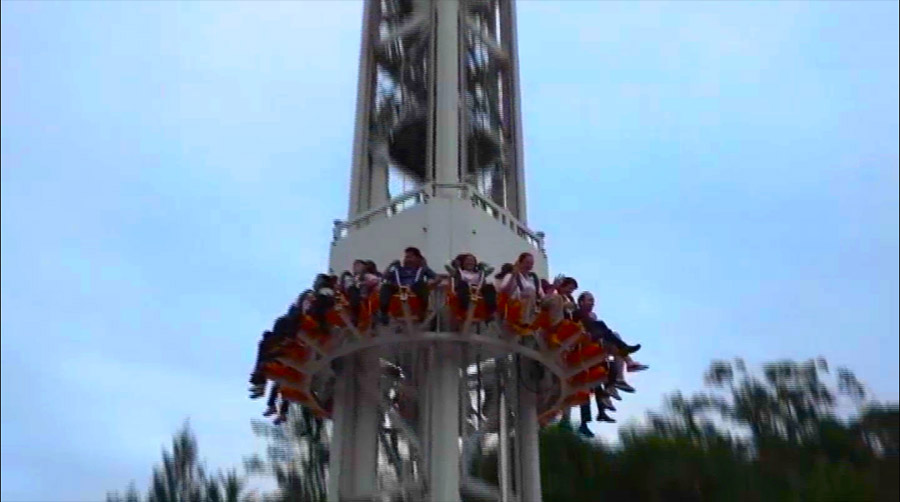
Our last ride was a twisty upside-down thing that only went for about 45 seconds, but that was plenty long enough.
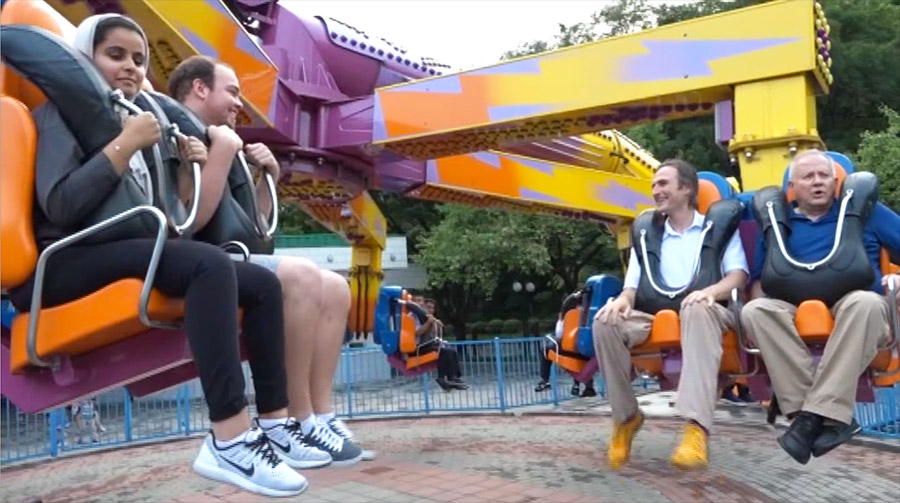
On all of the other rides I had been greatly entertained by Julien’s distress, and this one was no exception, until the ride suddenly pivoted and he was straight above me.
“Don’t barf Julien! Whatever you do don’t barf! You feel fine!”
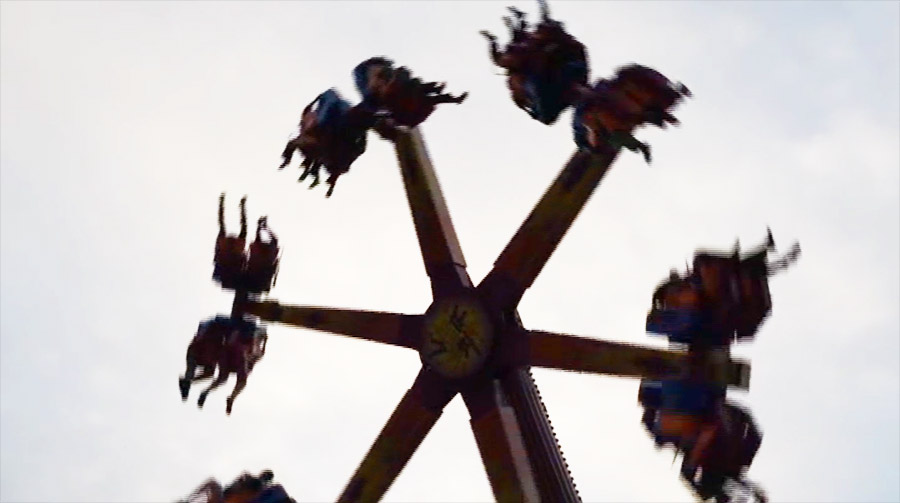
It took my stomach about two hours to calm down after that ride. I need to email Julien and see if his ever did.
While we were all tempting the fates, Nancia was running around, befriending North Korean people and getting photos with them. This was perhaps a much more meaningful use of the time but again, there was a big twirly thing that went fast.
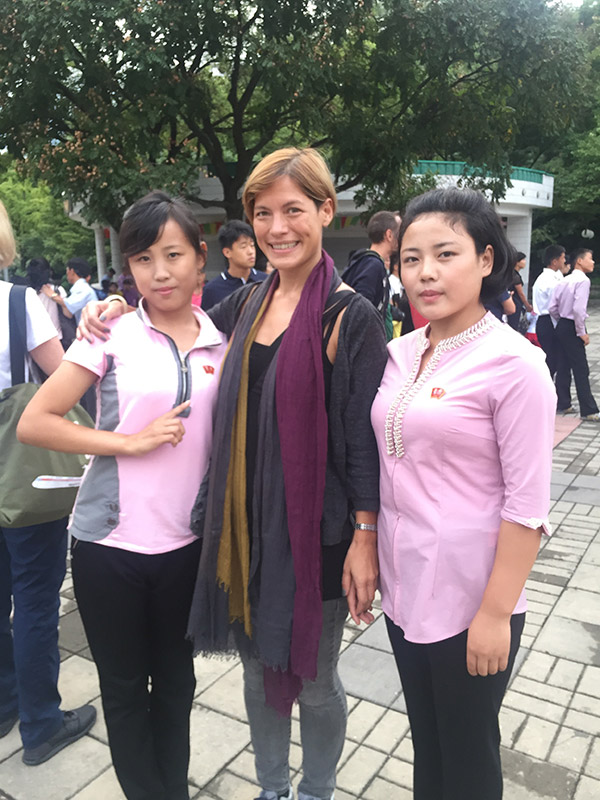
While sitting on the bus getting ready to leave, I looked out the window and watched a North Korean schoolgirl in uniform run up at top speed and tackle two of her friends in a bear hug, wrapping her arms around their necks as they collapsed to the ground laughing, their faces bright with joy. There’s your scene you didn’t expect to see in the DPRK.
Liberation Day ended for us with dinner over an absolutely endless professional karaoke performance.
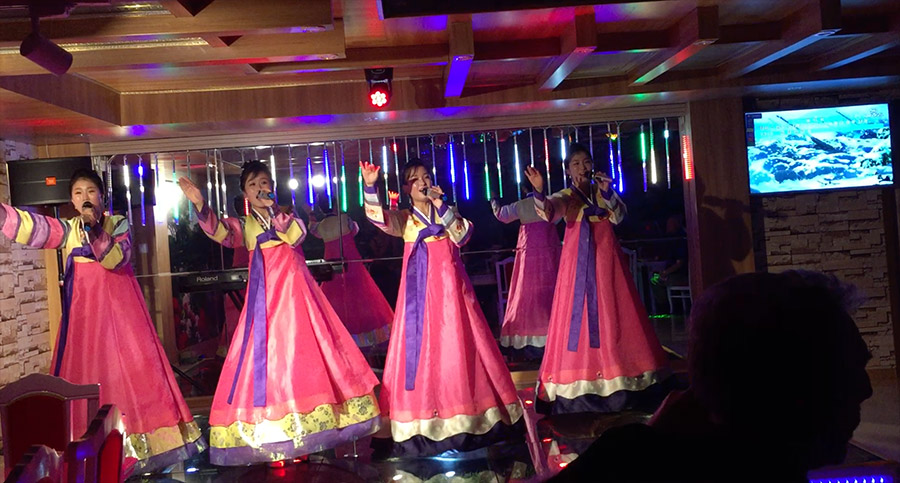
Note the surreal scene on the screen to the right, missiles being launched behind the karaoke lyrics. This was in no way unusual.
We entered the Demilitarized Zone, possibly the most inaccurately named place on Earth, given that it’s heavily armed on both sides, stacked with landmines on top of landmines, and is the tensest border on the planet. But I can understand them sticking with the name, DMZ sounds cool. It sounds like a rapper.
The actual DMZ was a bit less exciting than the build-up. My favorite moment came when Simon from our tour company showed us a map of the compound.
“This side is run by the DPRK, this side is run by the UN, or as they call it, the US.”
We visited the room where the armistice was signed that put a 64 year pause on the Korean War. The huge room was dim and almost empty. Should there be lights? The narration was kind of hilarious:
“Here you can see the flag presented by the US at their surrender. They were too ashamed to give their own flag.”
It’s a UN flag. You were fighting the UN! You were negotiating with the UN- never mind.
Looking across to South Korea, there was no one there. Apparently they schedule things so the visitors from the North are there in the mornings, while the South gets the afternoons, which limits the opportunities for high-fives across the border. I’ve heard that guides on the South side often tell tourists that the buildings on the North are just facades, which is consistent with the various urban legends about the DPRK worldwide. Anyway, we went inside them, they’re buildings.
At the actual line dividing the two countries, there are three Smurf-blue buildings. We entered the building in the center, which featured a table that divided the room into the DPRK and South Korea. We were able to walk around the table to the far side. Voila, I’ve been to South Korea!
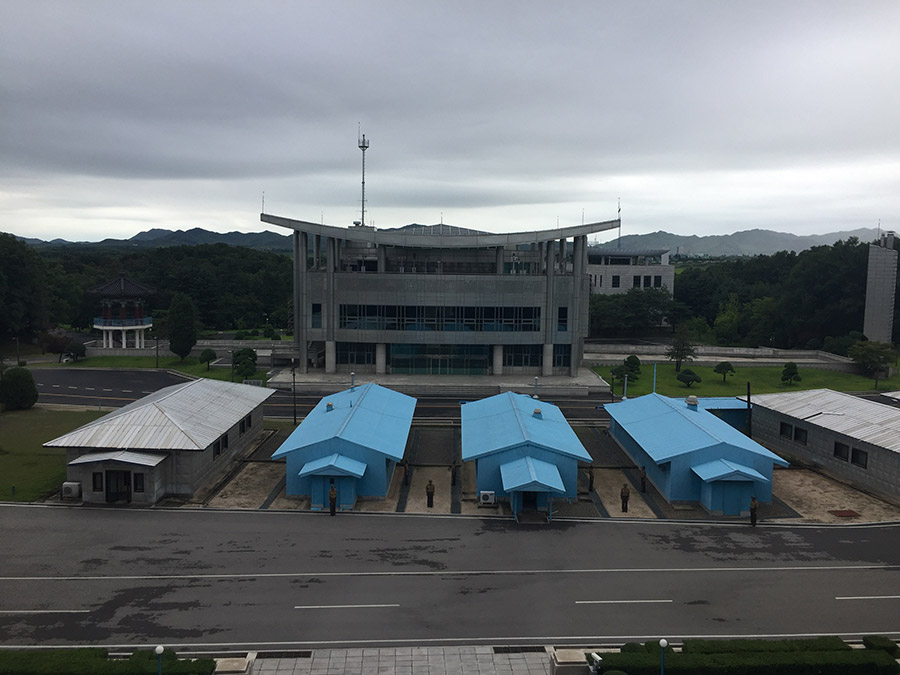
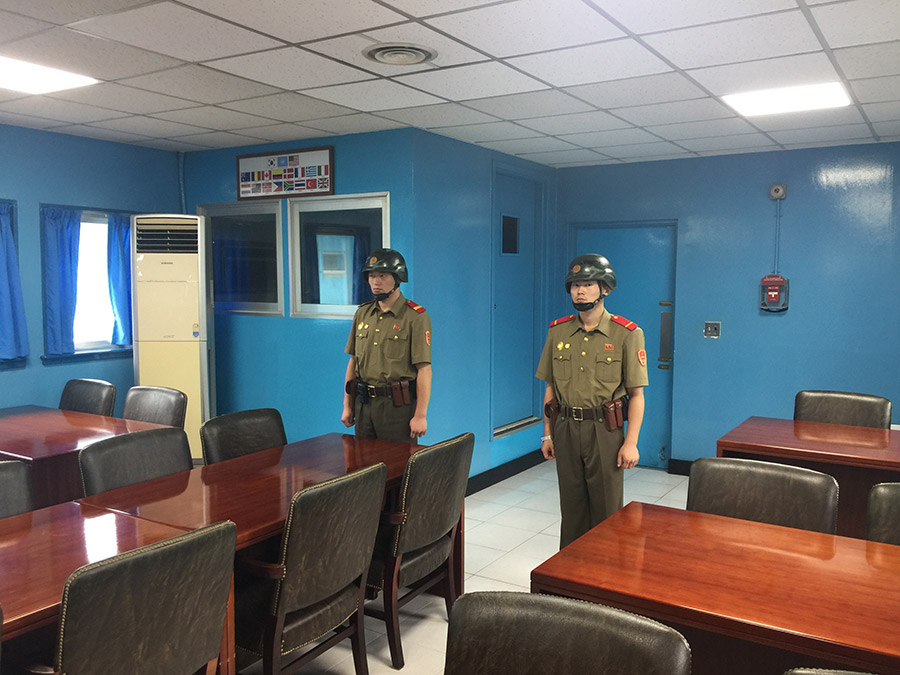
That was literally the cheapest country box-checking ever, in both senses of the word.
We walked toward the far side of the room to look at the framed flags on the wall and the expressionless soldiers guarding the back door to South Korea started advancing toward us, corralling us back into the center of the room. Time to go!
After leaving the DMZ we rode for a long time and climbed a steep hill to a building where we could view the “wall” separating the North from the South. We sat in a room while a North Korean general of some sort explained to us the dimensions of the wall in minute detail. Pat fell asleep literally instantly and began snoring. The general went on in dramatic tones, explaining how this wall was a tragic scar on the soul of Korea, a symbol of how the US was keeping the North and South from their yearned-for glorious reunification.
This was a big theme we heard a lot about, about how the North and South badly want to be reunified but the evil US won’t allow it. I’m no expert on South Korea but from what I’ve read they generally consider the North to be a bunch of sad hicks and that reunification would be far too expensive, since they’d have to pay to bring the North sixty years forward into the present.
Our guides went on at great length about how Kim Il Sung worked his fingers to the bone his whole life to reunify the country. This was kind of ironic since yes, he did, it was called the invasion of the South by the North in 1950. But of course they don’t believe that happened. Their concept of his vision is a unified country with two separate systems (one communist, one capitalist) featuring equal representation. Someone in our group asked if equal representation was truly fair, considering the North has 25 million people and the South has 50 million. This question fell down the “pretend language barrier” rabbit hole where all such questions were dismissed.
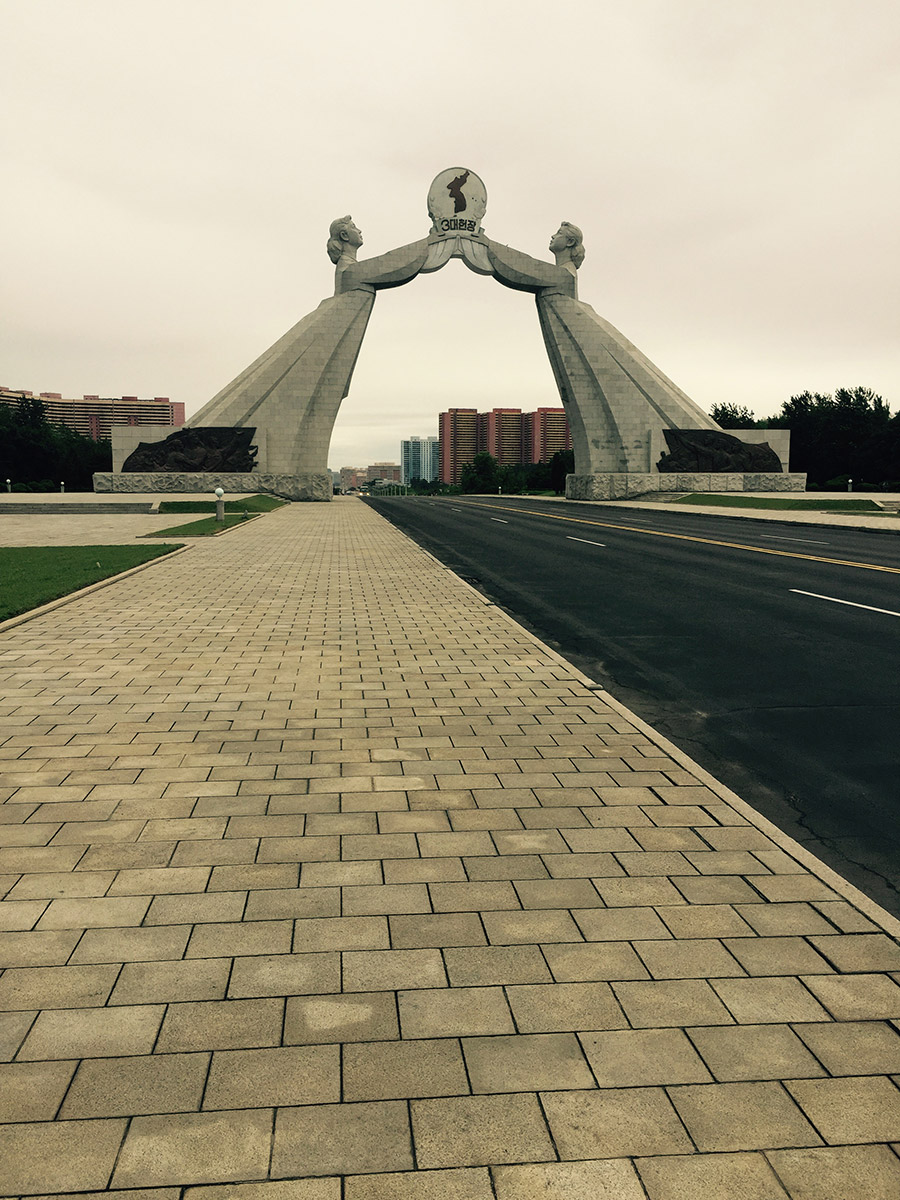
So why didn’t the country reunify if both sides wanted it? That damned US, vaguely somehow stopping it from happening.
This is relevant since we were there to see the wall that the US-backed South had erected to keep the two sides apart. It was kind of strange to think that we had to travel a long way from the actual DMZ to this one specific vantage point to see a wall that was supposed to span the entire peninsula. We went outside and were given binoculars.
“Do you see it?”
“I guess. That brown line that might be a road or just dirt?”
“Yes! That’s the wall.”
“Okay, whatevs.”
We were far more interested in the fact that we could see a South Korean city with huge buildings off in the distance. Is that Seoul?
“No, Seoul is too far off to see from here.”
Wow, that’s just some other city I’ve never heard of. South Korea is doing way better than you guys.
Best as we could figure, the “wall” we saw was just part of the fortifications for a South Korean military post directly across from where we were standing. Way to be weird, DPRK.
Dawn broke and it was time to make our way to Mt Paektu, Korea’s sacred mountain and mythical spiritual birthplace. Getting to visit is a fairly rare privilege and even the North Korean guides were excited. Our tourmate Pat was on his eighth trip to the DPRK and had joined our group half-way through just for the chance to see Paektu.
Into Pyongyang Airport, and again we were the only people there. There were two flights leaving in the foreseeable future, and we were on one of them:
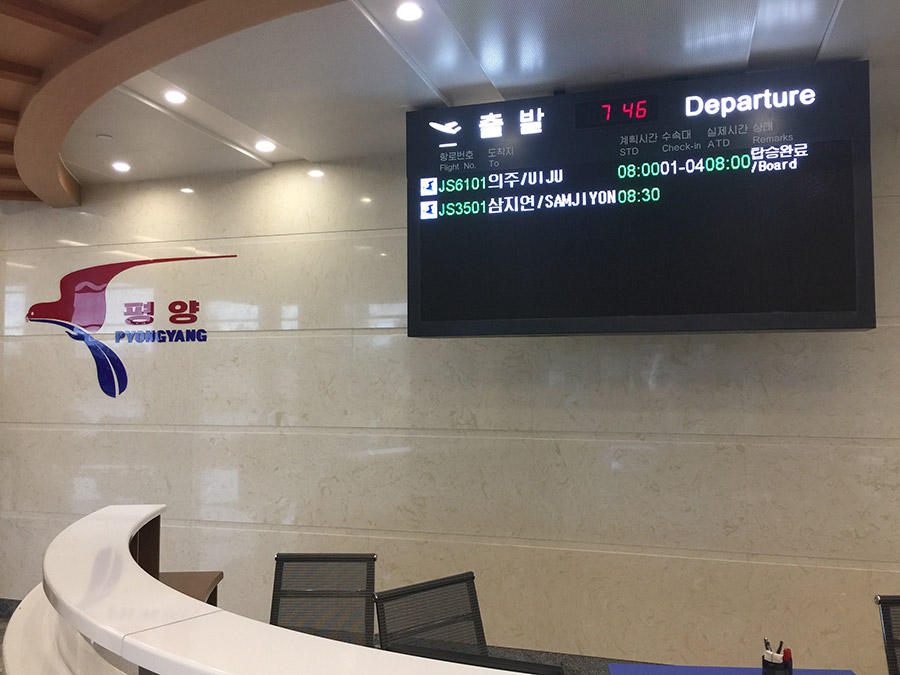
“Kind of smells like piss in here,” Mike observed. “Yeah, the whole country does,” I agreed and oh goddammit there’s a guide standing right next to me. We really need to put a bell on them. The guides were used to this by now, I think. Don’t take it too hard North Korea, you just smell like Paris.
We walked around and got a look at the airport’s various shops and chicken restaurant.
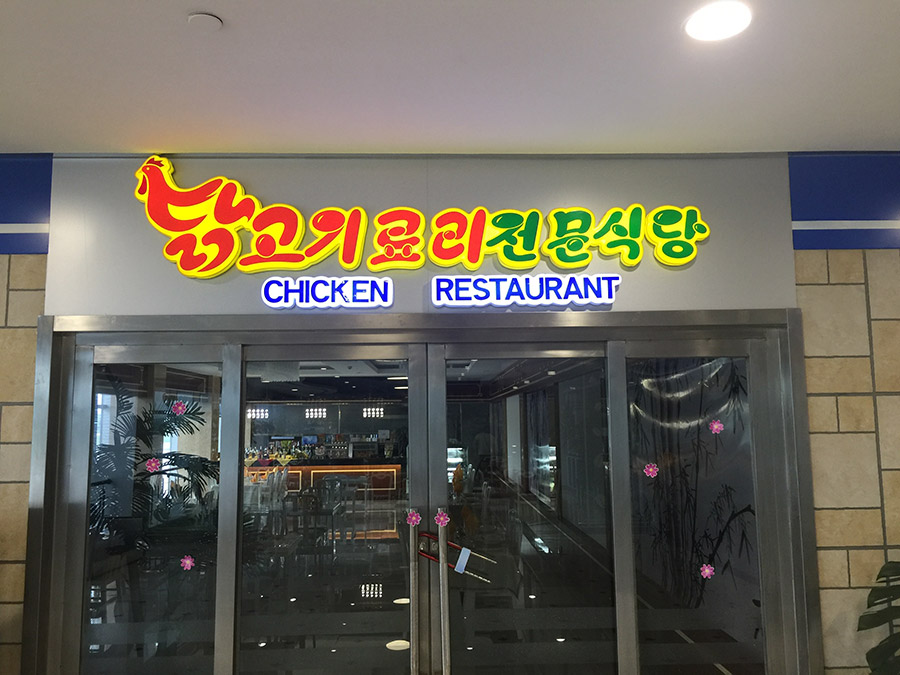
The bar upstairs had Japanese orange juice so we were all over that. The barmaid refused my completely average one dollar bill for not being crisp enough.
All trip long we’d marveled about having found the only country in the world without any Coca Cola, until we peeked in the vending machine downstairs by our gate:
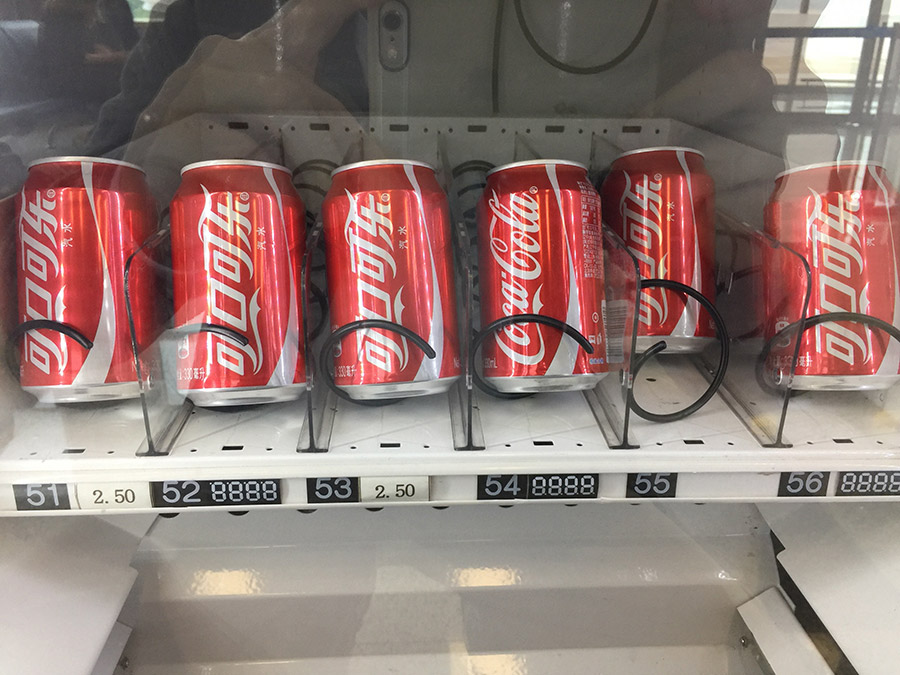
Damn you Coke, you magnificent bastards.
Before we boarded the plane we were told “no parasols.” Wh… why? Are they afraid our already-dicey flight couldn’t handle the added bad luck of somebody opening an umbrella on the plane? Questions were asked and the answer came back: they meant aerosols. This became a running joke the rest of the trip.
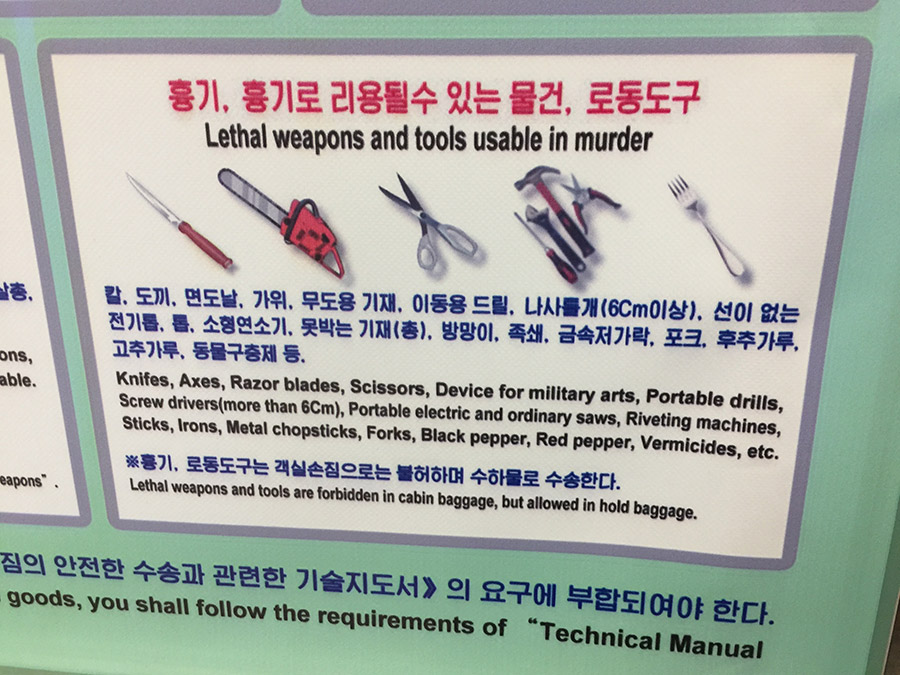
Outside, our charter flight to Paektu awaited. Its propellers gleamed in the sun. Oh God.
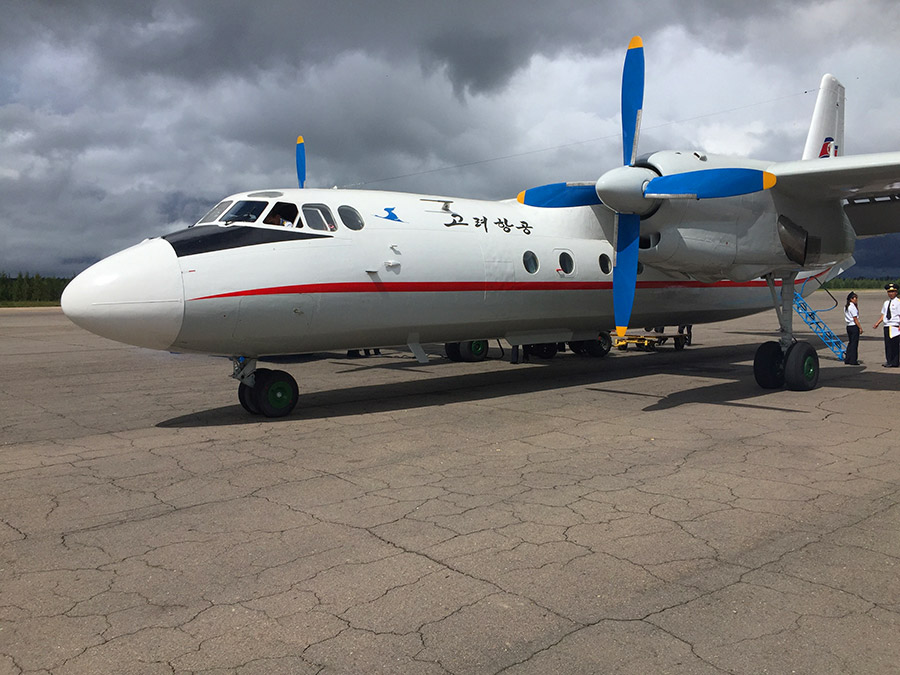
The Antonov AR-24 was developed in the Soviet Union in 1959. Air Koryo started flying them in 1966. This particular example was apparently from 1974. On the bright side, they’re known as sturdy and reliable planes. On the less-bright side, they’ve been banned from flying in Russia since 2011 for being too goddamned old. All aboard!
The seats reclined whether you wanted them to or not. The windows were round like on a submarine. There were spare gigantic captain’s hats on the shelf above us that we all desperately wanted to touch.
I’ve blacked out most of this flight. I remember talking to Pat about what the hell all the restricted symbols on the flight safety card meant:
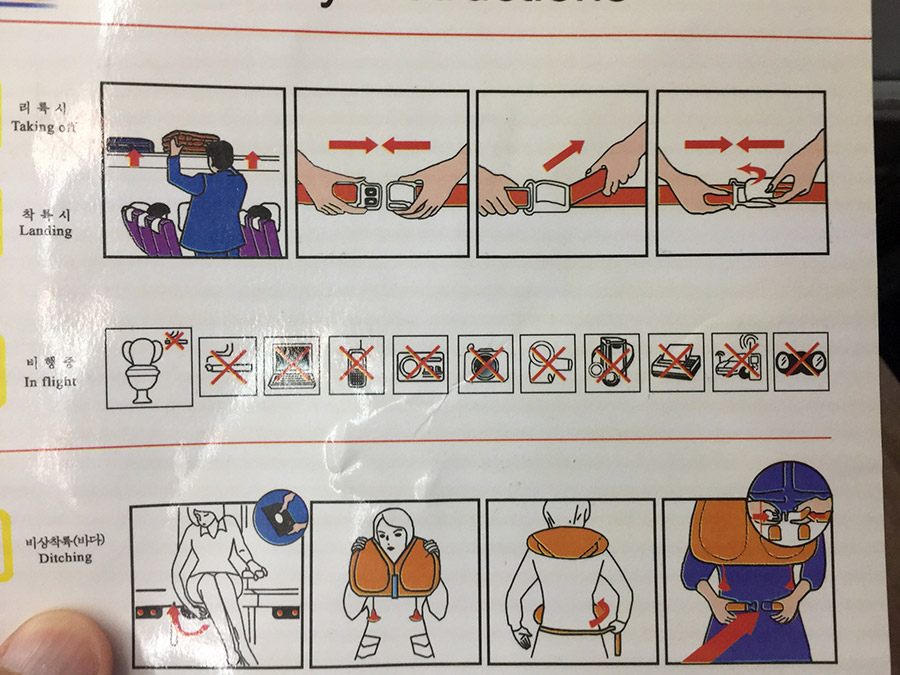
No printers? No… is that a hairdryer or an inhaler? No sports cars, gotcha.
I think the stewardesses may have come by with more You Can’t Do That on Television Barth burgers. I passed on these. They came by with your choice of either little cups of soda or little cups of radioactive truth serum. I opted for the soda, which was toe-curlingly sweet, like they’d forgot to add water to the syrup.
I read the complimentary copy of DPRK Magazine. It featured several insightful articles about how the Japanese imperialists were getting ready to invade them again, and how the plastics factory in Pyongyang makes tens of kinds of plastic things now. The writing was uniformly hilarious.
We arrived. Happy days.
Onto the bus and up the mountain we went. The woods on Mt Paektu, I later read, are full of Siberian tigers, bears, wolves, and wild boars. We didn’t see any of these. What we did see were tons of what appeared to be soldiers marching up the rough, rutted roads, our bus swerving around them constantly. Eventually we were told that these were actually just normal North Korean citizens who’d come to the mountains to play-act at being part of Kim Il Sung’s revolutionary forces from when he was stationed in these mountains, fighting the Japanese. So does that mean we can take photos of them? A North Korean zen koan.
Our guides turned on the A/V system for the bus and started playing us North Korean music. Before long we were being treated quite inevitably to the Mt Paektu song, “We Will Go to Mt Paektu.” Oh Jesus. This would have been fine except we’d heard this song four times in the last 48 hours, with most of those coming in the form of karaoke. The song’s lyrics basically translated to “That’s right bitches, I’m going to Mt Paektu!” and it was annoyingly catchy. (If you’re in the mood to hurt yourself today, to see if you still feel, here’s a link.)
“Galilaaaaaa! Paektusaaaaan!”
I had already begun singing along in my head:
“Fuck this soooooong, Paektusaaaaan-”
Our bus wound its way up the mountain, into denser and denser fog. The trees grew less frequent and scrubby as we climbed, and then there were none. Eventually we parked near the top, 9,000 feet up. When the guides weren’t looking, we figured out how to turn off the North Korean music. We all got out to take fog-obscured photos of Lake Chon (“Heaven Lake”) down in the caldera of Mt Paektu below us.
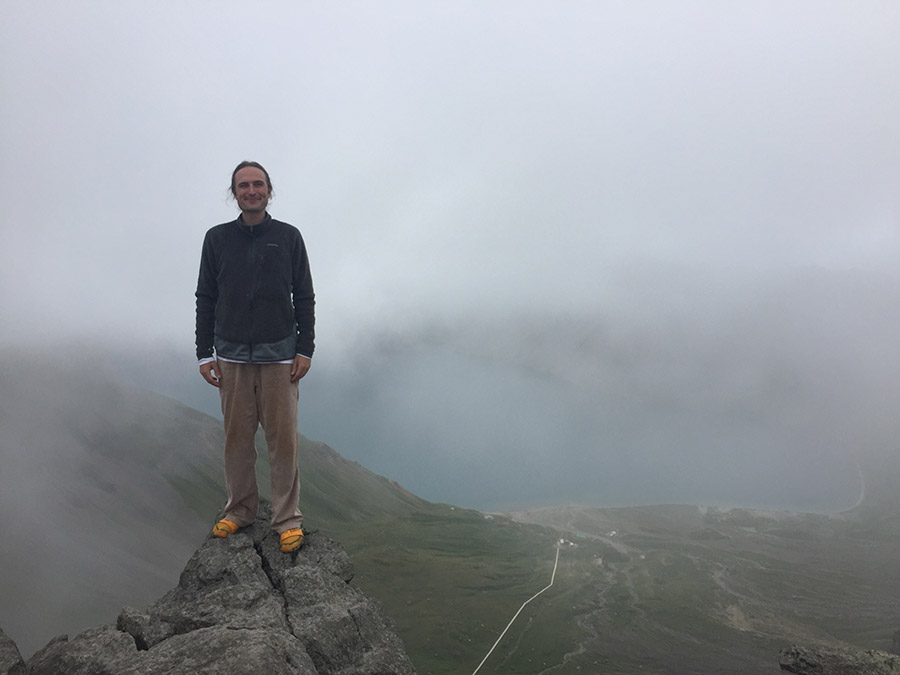
Just when we’d resolved to only sort of see the lake, the fog cleared and we lucked into some nice clear views.
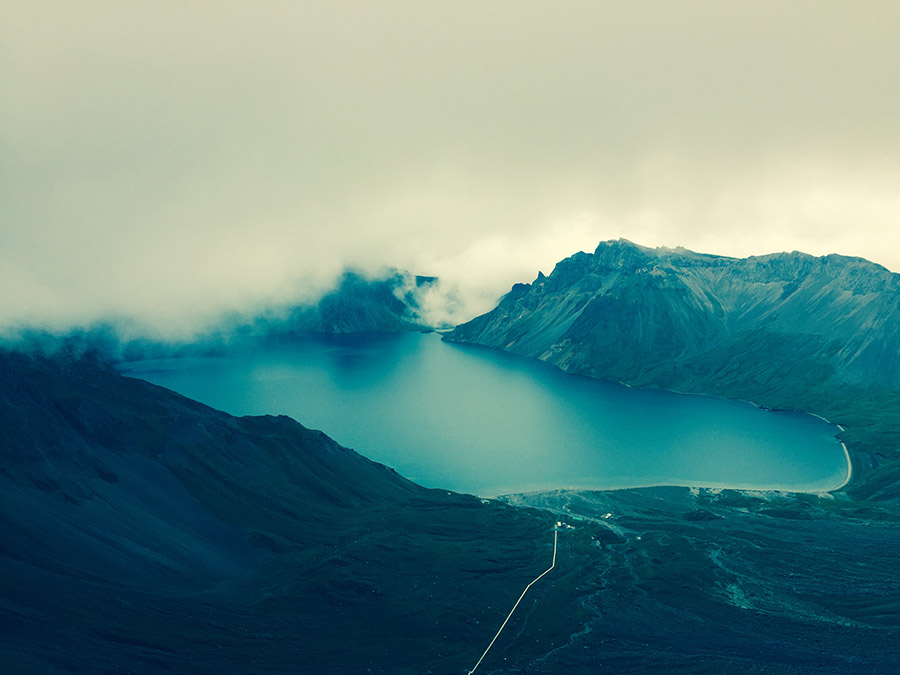
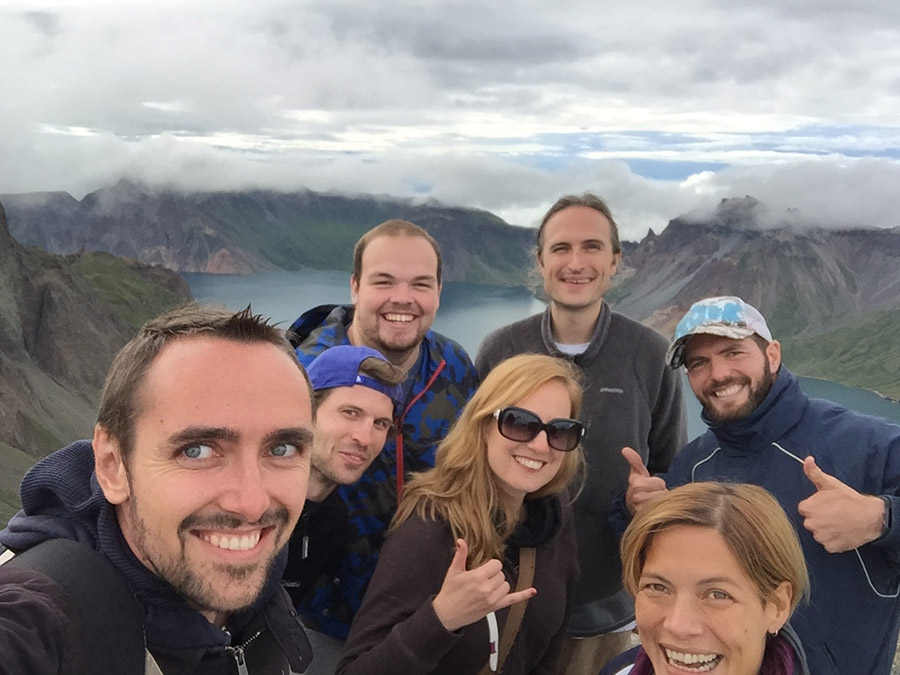
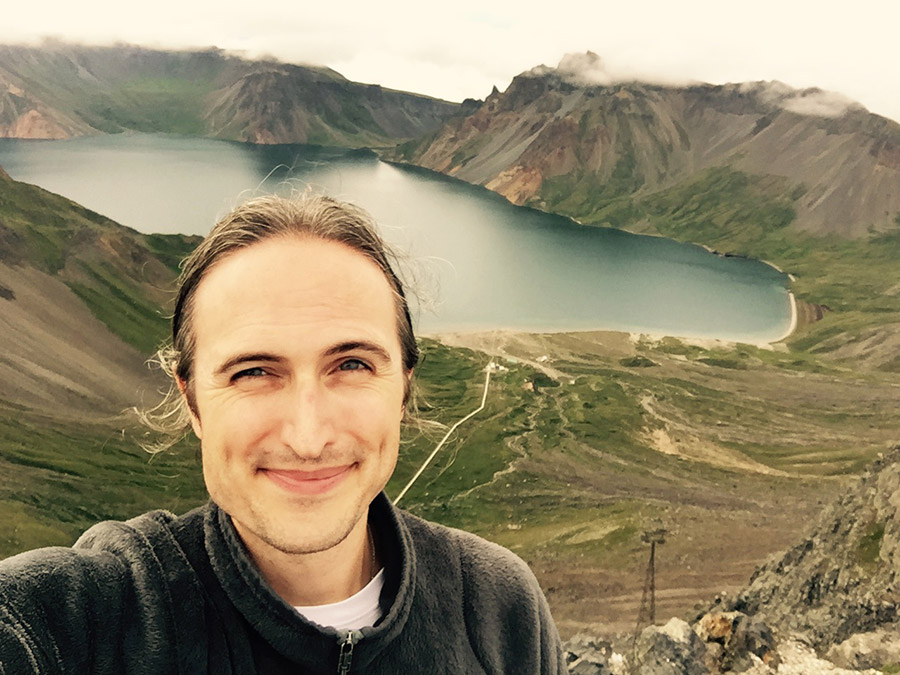
I wanted to hike to the peak, and Magic Mike was up for it too. It was only a kilometer further up, but the walk was a bit ominous as the path disappeared up into the fog. After a bit of steep hike it leveled off and suddenly we were looking down over the edge. We climbed out over the railing and out onto the rocks. From there the edge was absolutely straight down, the long drop disappearing into the fog below.
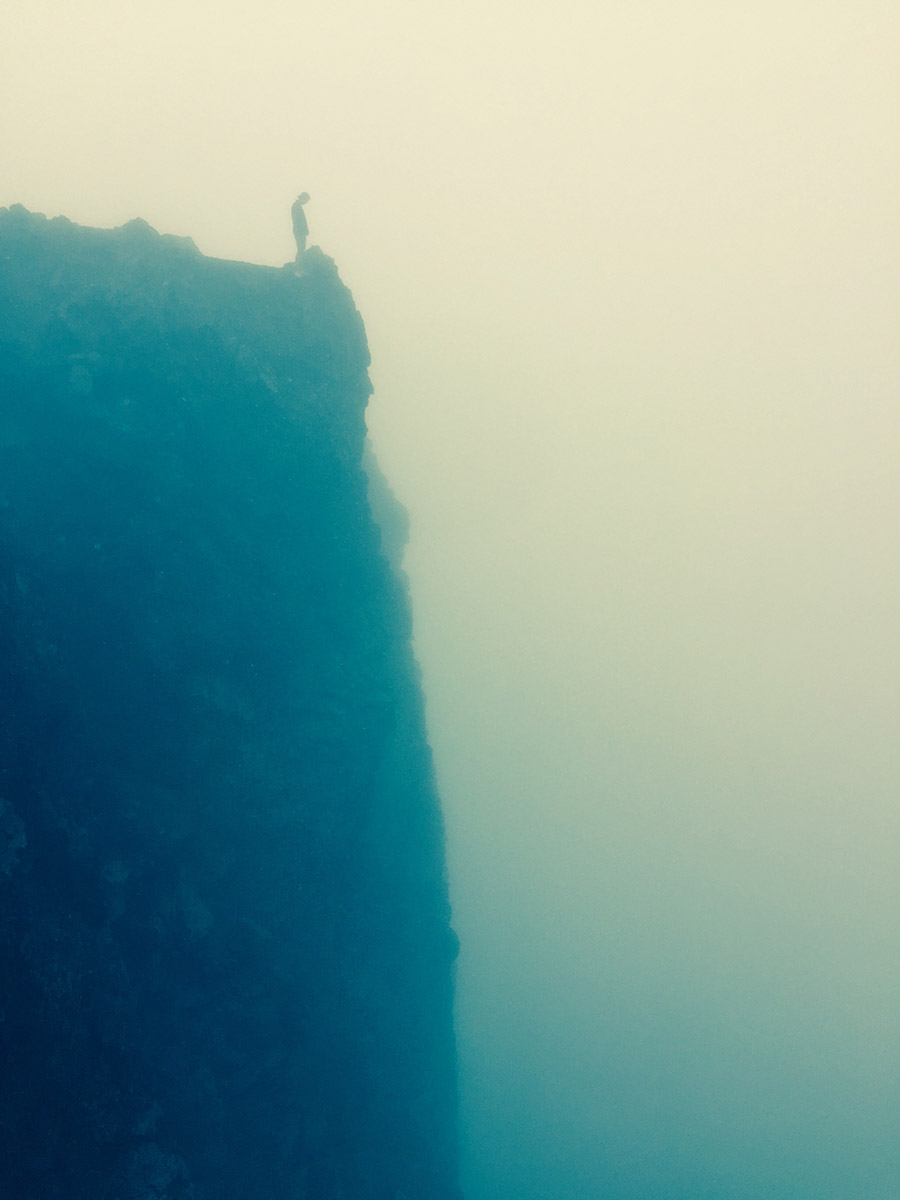
Mike and I took turns climbing out onto various precarious cliffs and getting photos of each other from cliff to cliff.
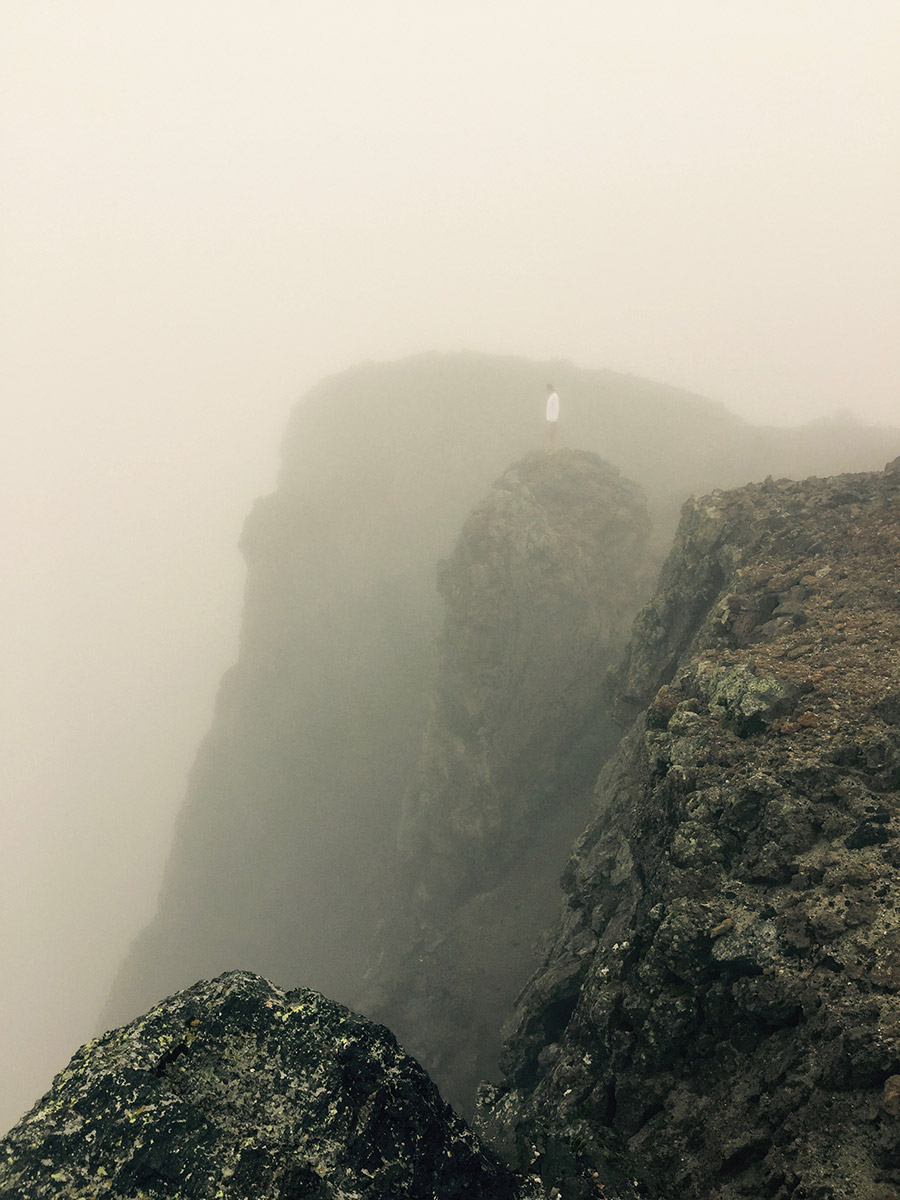
There was something absolutely mystical about looking down the cliff faces at the swirls in the rock and down into an abyss you couldn’t see the bottom of.
I was balancing on a rock trying to get a shot of Mike on the opposite cliff when he suddenly climbed down in a hurry. I realized way too late that a North Korean soldier had driven up in a Jeep and was yelling at Mike to get off the cliff you crazy SOB. I realized this when the soldier drove up to where I was perched and yelled the same things at me in Korean. Then he disappeared up another road and we realized there was another peak a bit further up.
The soldier was escorting some North Koreans to the tippy top, and we followed them up. I started to climb a somewhat inadvisable route up the rocks and the North Koreans all yelled at me to stop being an asshole and go up the way they had gone. The soldier even gave me a hand and pulled me up one of the tougher spots. Wow, that was cool, wasn’t expecting that from the guy who was yelling at us a second ago.
Up top the Koreans were posing at a small monument marking the peak of the mountain. They asked the soldier to get in the photo and took several photos with him. I thought oh wow, this is friendly, this must mean we can take photos with the solider here! I angled my phone and somewhat covertly snapped a photo of the group. The soldier immediately walked over to me and gestured to my phone. I thought “Oh cool, he wants to get a photo with me!” He did not. He wanted me to delete the photos I’d taken of him with the other Koreans. All right, fair enough. I showed him on the screen as I deleted them. He wasn’t satisfied. I swiped through all of my photos for the day until he was sure the offending photos were gone.
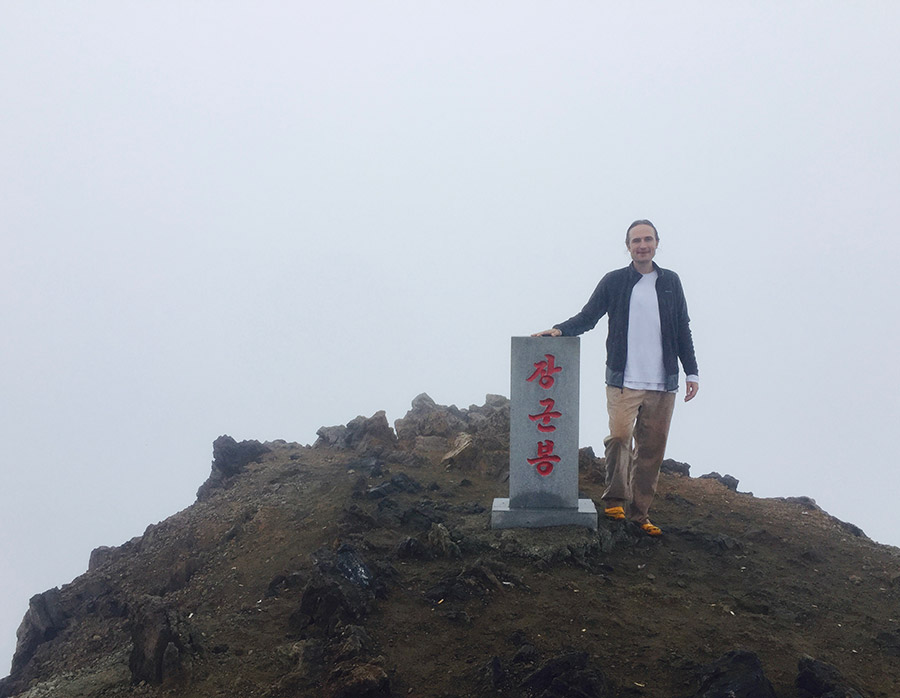
After Mike and I got our own photos in at the peak, we hiked back down and joined the rest of the group, who were waiting to take the ropeway down to Heaven Lake. No one was completely sure what the holdup was. In time we pieced together that they needed fuel to run the cable cars, so they took up a collection from each of us who wanted to go down. Then a Korean man nonchalantly walked over to our bus with a hose and siphoned some of our gasoline into a can. Had he really sucked the- he walked way wiping his mouth with a handkerchief, okay yes he had.
We waited some more. Two Korean soldiers stood off to one side, each holding one end of some kind of dirt-sifting washboard, shoving it back and forth at each other like “No, you take it.” We joked that it must be one North Korean and one South Korean.
It seemed like they still didn’t want to let us go down to the lake. The next thing we knew, our senior guide was yelling at people in Korean, both in person and over the phone. This went on for at least 20 minutes without stopping. It really made me wish I understood Korean. Shit was going down. The impression we got was that our guide was more important than we’d previously assumed and was pulling rank. Eventually, the cable cars started up.
They warned us that we were not to take any photos of the North Koreans who were currently down by the lake. This was a big deal.
We climbed into one of the sketchy cable car pods and were sealed in from the outside. One of the windows was shattered. We wondered if it was from someone trying to get out. After a long wait we began to move down toward the lake.
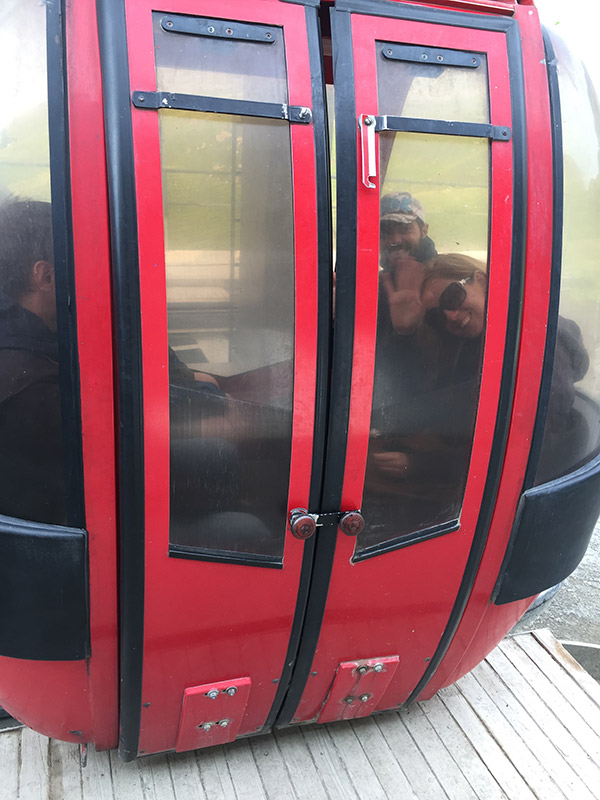
The cable our pod was hanging from made a continual metal stretch stretch stretch sound that we fervently hoped was normal. It was a fairly long drop down to the mountain slopes, but I figured we’d probably survive the fall, then our pod would roll into the lake and all bets were off. Passing each support strut the pod would CHUNK forward unnervingly. It was a really long ride.
At the bottom we got out and Julien had to pee bad. No bathrooms, no nothing. He asked if he could just find a bush. The guide explained that uhm, like, this is our holy mountain dude. I’m pretty sure he found a bush when no one was looking.
The view from the lake was beautiful, the mountain peaks all around us and the sun peeking in and out of the clouds.
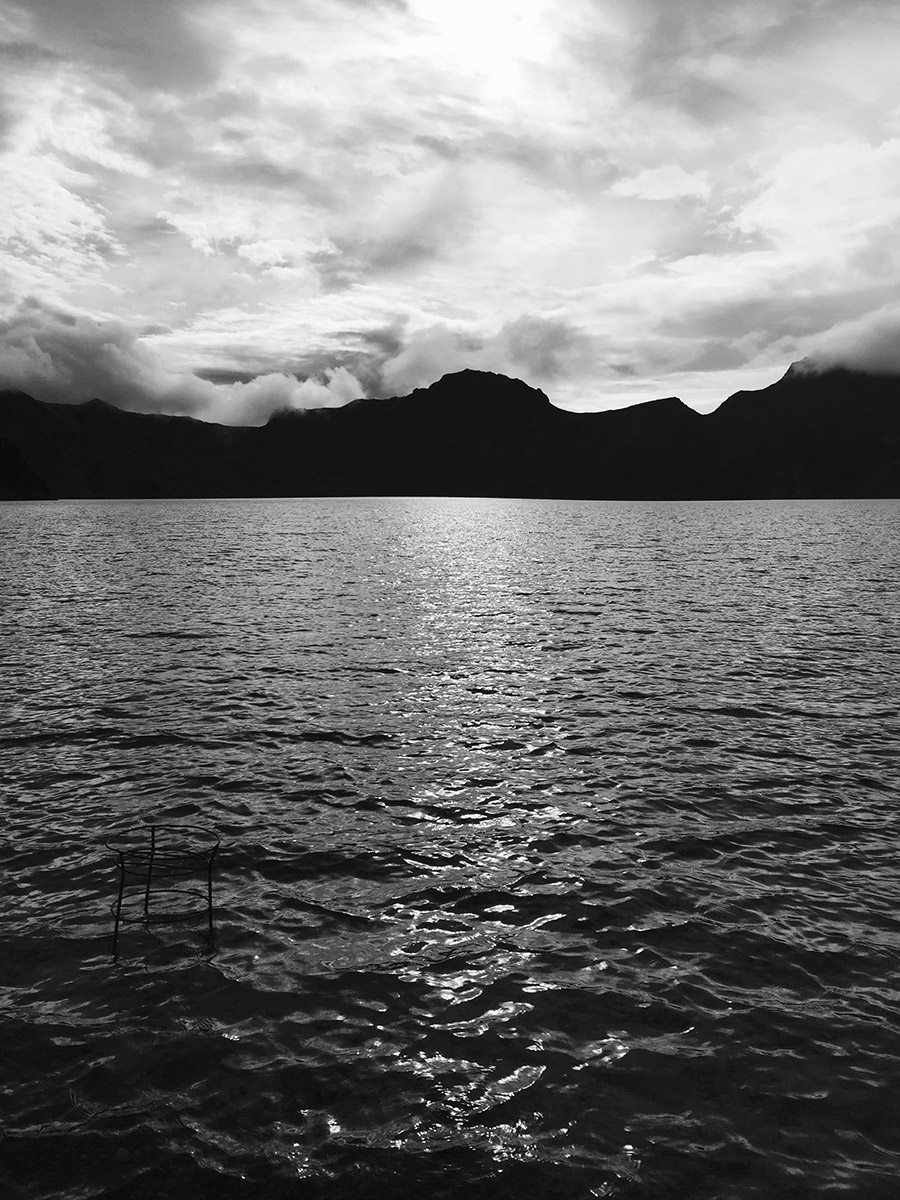
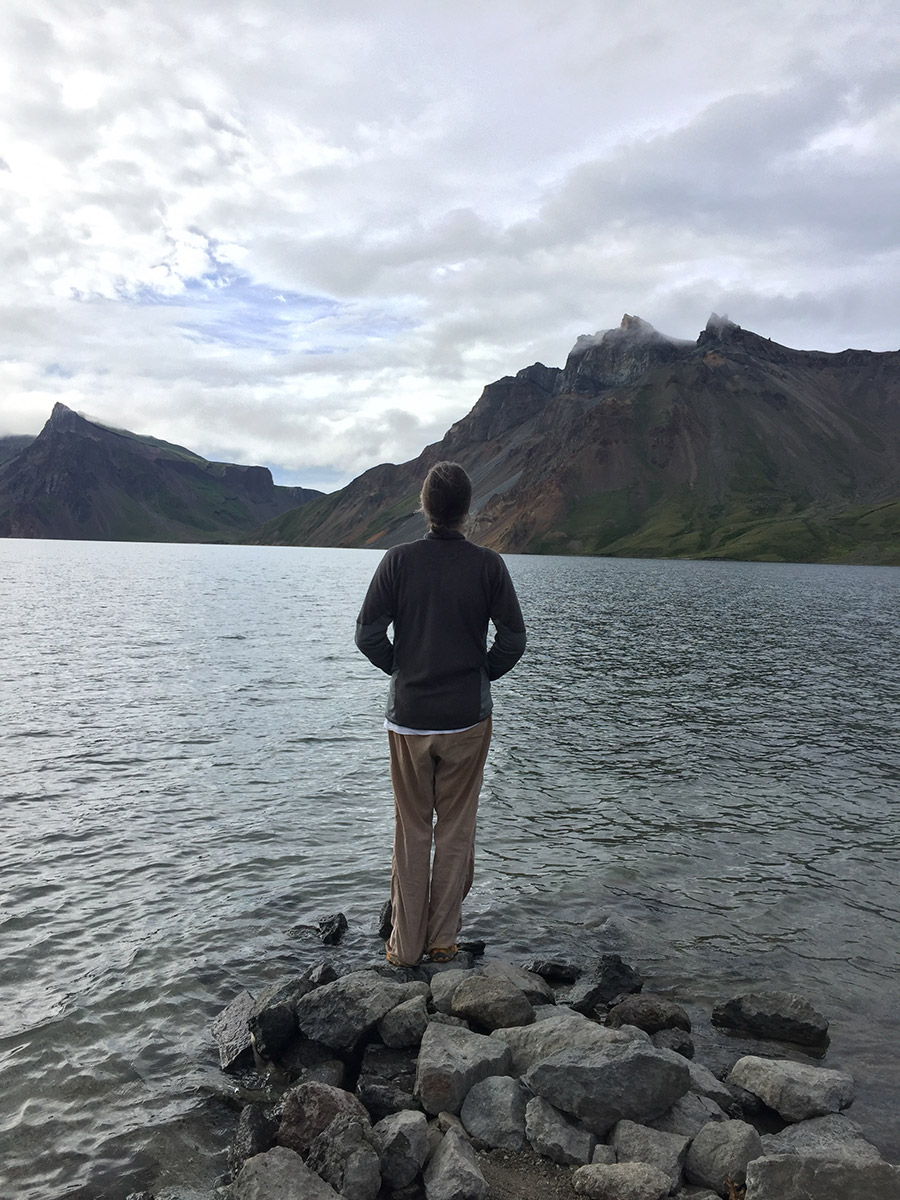
I took my shoes off and waded in. It was pretty shallow fairly far out. The water was cold but not intolerably so. However the jagged rocks on the lake bed were pushing it a little.
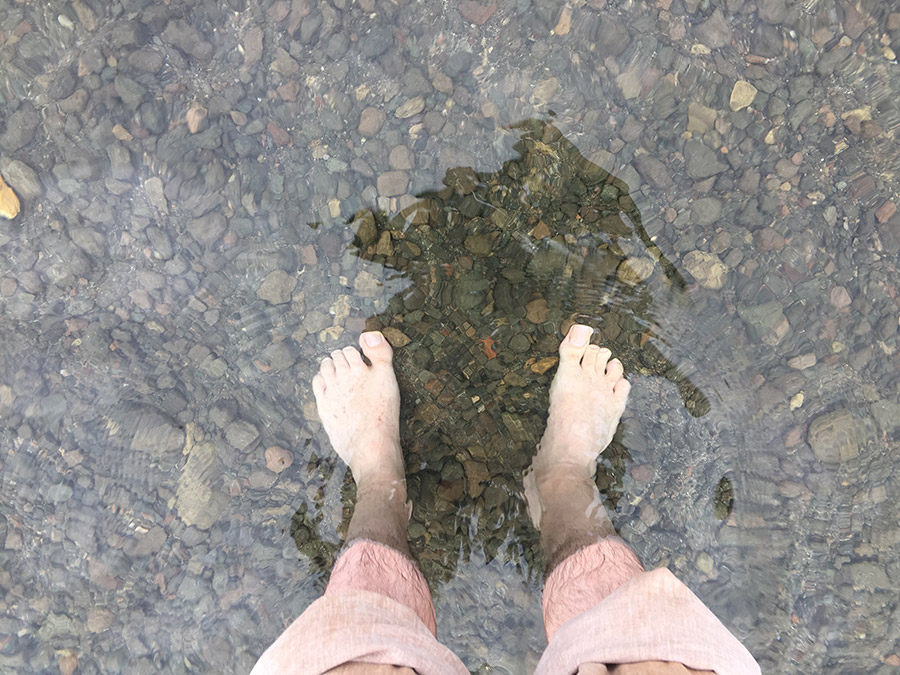
I had no idea at the time I was wading into it, but there’s supposed to be a monster in the lake. Or six, depending on the reports. The lake is known as Lake Tianchi on the Chinese side, and the Lake Tianchi Monster is described as looking like Jar Jar Binks. There are a bunch of blurry photos online if you didn’t get enough during The Phantom Menace.
We all took obscene numbers of photos at the lake. It seemed that the North Koreans we were supposed to not take photos of had all ridden up the cable car at the same time we were headed down. Interesting.
The border with China runs right through the lake, and standing on the shore, some of our phones sprang to life with Chinese cell signal. We watched people in the distance docking a rubber boat at one end of the lake. Before long we’d developed the theory that this would be a great place to smuggle contraband into North Korea from China, since you were well out of sight and would only have to bribe a few soldiers. Was that what the people we weren’t supposed to take photos of were doing? Hmmm.
I walked off up the shore of the lake to sit and meditate. When I opened my eyes, one of the strangest bugs I’ve ever seen was climbing up my pant leg:

I watched it for a long time, marveling at its obscenely long proboscis. Then I thought “You know what would suck? If he stabbed that thing into my leg.” My Attenborough moment was over.
After much frolicking and enjoyment, we piled back into the pods and made our way back up the mountain. A soldier rode in the pod in front of us, and he opened the pod’s double doors wide to take in the view. This seemed slightly crazy and also it made me jealous.
On the bus ride down the mountain and through the woods to our hotel, the Frenchmen broke out their Bluetooth speaker and we took turns playing songs from our phones. This was a lot of fun, especially given the international character of the group. A Mexican song, a Dutch song, a French song, etc. When it was my turn I decided to see what we could get away with and played a Run the Jewels song. Our bus lurched down the bumpy road to the beat:
“Picture this: I’m a bag of dicks, put me to you lips, I am sick, I will punch a baby bear in his shit!”
Oh God, this is so crazy. A wave of relaxation washed over me as I suddenly became aware of the unconscious tension I’d been holding all trip, tension that I think everyone was holding. Don’t say the wrong thing, don’t take a photo you shouldn’t take. Keep your guard up. For me, this all melted away as the hip hop profanity filled the bus.
“I will walk into court while erect screaming yes I am guilty motherfuckers I am death!”
God knows what the guides thought of all this. I’m still laughing wondering about that, how does any of this even register when all you have is the North Korean equivalent of the Lawrence Welk show? When the song choice came back around to me a second time I went with A Tribe Called Quest’s “We the People.”
The hotel was absolutely packed full of Chinese tourists. At dinner we were treated to the much hyped barbecued potatoes, which just seemed like baked potatoes they’d burned the living shit out of to me:
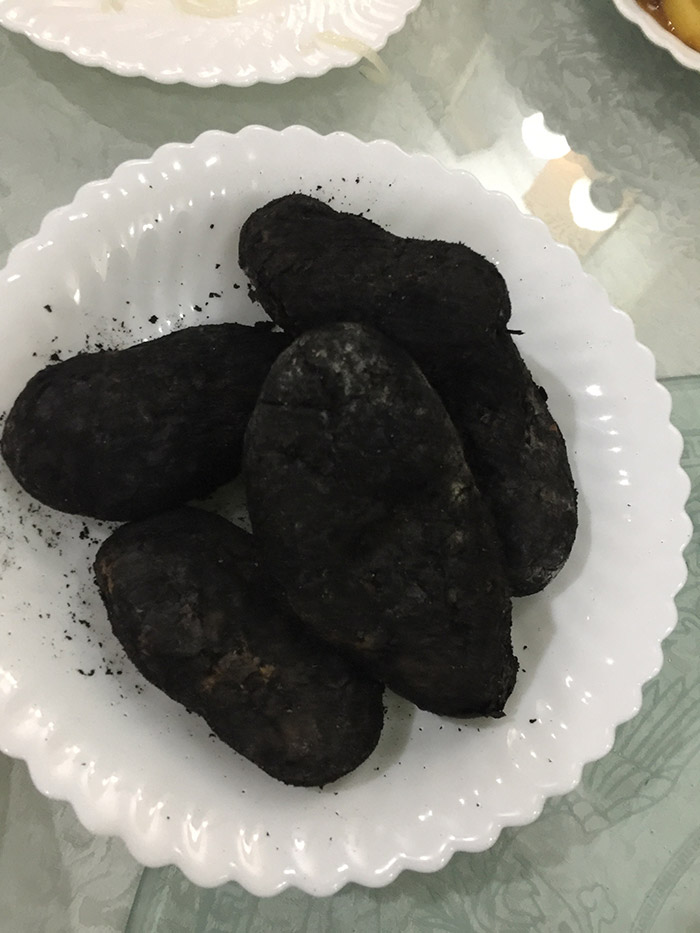
Everyone was pretty much done with North Korean food at this point, so meal participation was pretty half-assed at best. We were warned that there would only be hot water for 30 minutes the next morning at 6am, so everyone made plans to get up early as we settled into billiards and soju for the evening.
At one point our senior guide joined us. He was really hammered.
“Sean! I care about you the most! And I like Michael. And the French guys.”
We all laughed as he clearly had no idea what Julien and Jean-Sebastien’s names were.
Our guide told me at great length about his plans to quit smoking (as I silently cursed, since I’d bought him a carton of the expensive cigarettes Kim Jong Un smokes as a gift to give to him at the end of the trip). Then he told me I was on the honor list. The what?
“You are honor list. You are better than other people.”
Oh shit they have an honor list? How did I make-
“I know about honor list.”
Oh wait, he’s saying “analyst,” I’d told him earlier in the trip what I do for a living. Ah, thank you. Yes, we are better than other people. I flashed back to our conversation about my job and how I wasn’t quite sure he believed me when I told him Target has almost 2,000 stores and over 300,000 employees. That kind of scale just doesn’t exist in the DPRK, unless you’re talking about the army.
Our guide asked me for the 20th time what I thought about the DPRK. I told him again that the cities were very clean and I was happy to see so many crops for the people, that I’d learned very much and thanked him for our conversations. He told me about how analysts see things more clearly than other people and are able to let go of their preconceived notions. Oh Jesus he’s waiting for me to tell him I’d seen the light and the DPRK was the best. Thankfully Francine spilled soju all over the pool table at this point and got me out of the conversation.
After that things got drunker and one of the other Korean guides revealed her true feelings for my roommate Julien, which he would not live down for the rest of the trip and which reminded me that he was back in our room at that moment, losing the battle with a bad piece of fish he’d eaten at a Korean BBQ a few days before. I decided to go check on him.
When I found our room, it wasn’t our room, and I realized the hotel had two wings with identical room numbers in each wing. Fine! I headed across to the correct wing and wandered around until a hotel employee pointed me in the right direction. I opened the door to our room and stepped inside right as I realized the hotel employee was right behind me and was following me into our room. What the f-
It turned out Julien had run out of toilet paper and had gone to the front desk to ask for more. They’d told him they would send someone to investigate, and here the guy was. He inspected our bathroom and confirmed that yes, we were in fact out of toilet paper. He disappeared again. About an hour later he returned with one quarter of a roll of toilet paper. Have a good night!
At six I got up to take advantage of the brief window of hot water. Our last full day in the DPRK! The power was out. No lights, no hot water. Okay then, back to bed.
Everyone took one look at breakfast and just got on the bus instead. After a drive through the woods we all got out and followed the tour guides. It was evident that tour fatigue and North Korean propaganda fatigue were starting to take hold.
“Wait, where are we? What are we even seeing?” “I don’t give a shit.”
Same. The first few days of the trip you’re eating everything up, you can’t wait to see the bizarre DPRK propaganda and photograph it from all angles. You have no idea that you’re going to be nipple-deep in it for nine days and you should really pace yourself. By the middle of the trip it just keeps coming and begins to sort of wash over you. And it’s all the same stuff, just repeated in slightly different ways. By the end you really can’t be assed.
“Welcome to Kim Il Sung’s secret revolutionary camp, where he was based as he fought the Japanese. General Kim Jong Il was born here on sacred Mt Paektu.”
Except he wasn’t, he was born in Russia.
“This camp was rediscovered in the 1980s and refurbished to the condition you see now.”
I’m fairly certain the camp was built from scratch in the 1980s, as part of Kim Jong Il’s campaign to deify his father, both to flatter his way into the role of successor and to build the cult of personality he would use to control the DPRK during his reign.
Was Kim Il Sung ever even here? Did he even fight the Japanese at all?
“Here you see the cabin where Kim Il Sung and his fellow soldiers slept. These fires would heat the floor they slept on.”
“Where did the smoke go?”
“Out the chimney.”
“I don’t see any chimney.”
The guides conferred, then led us over to the side of the cabin.
“You see that tree? It looks like a tree but it is not. It’s a chimney.”
“Oh bullshit,” I said, way louder than I had intended to.
Nothing can illustrate how tired we were of all of this by this point in the trip better than the fact that I only took one photo at Kim Il Sung’s secret base compound, and it was of one cabin’s bizarre goat hoof doorknob:
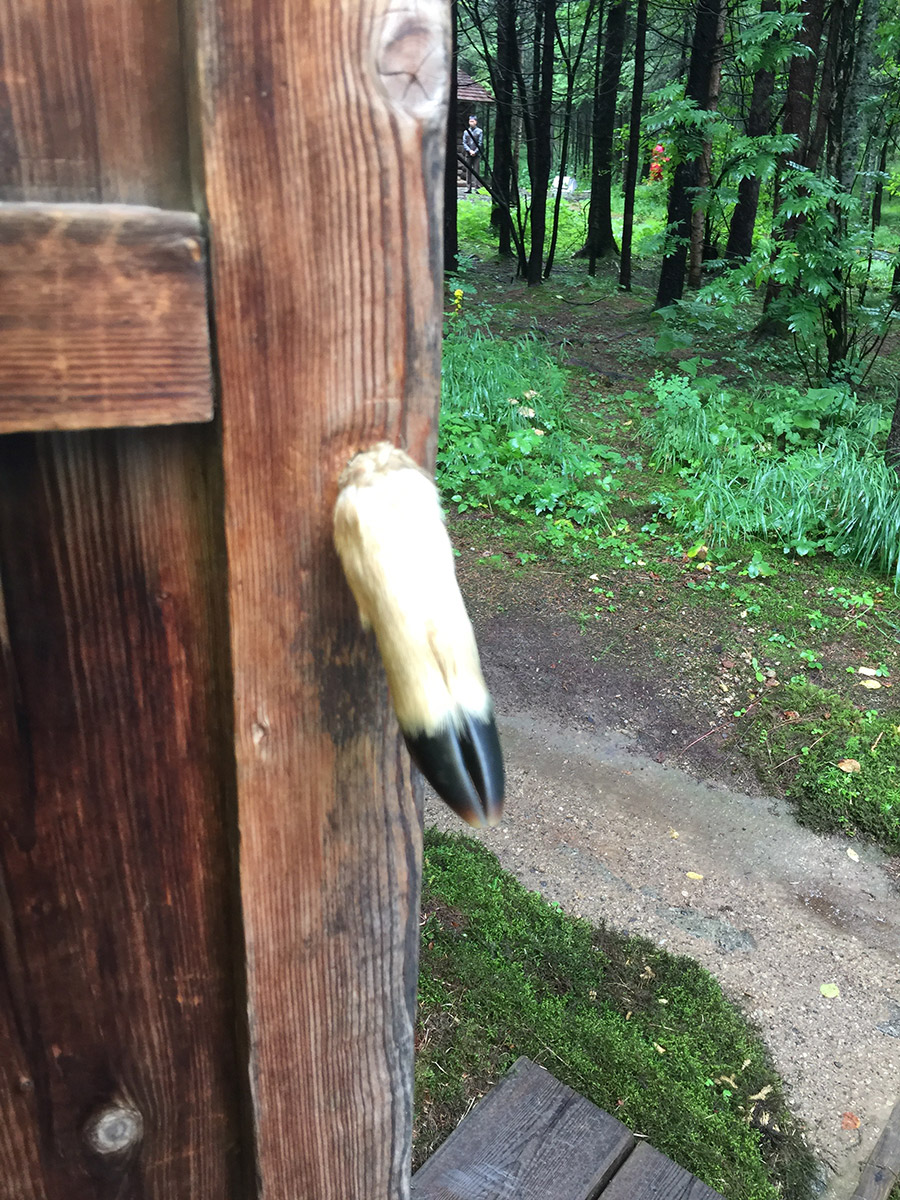
We traveled from there to the Rimyongsu waterfall, a scenic spot where water cascades down the mountainside into an alpine lake. The surrounding area looked like something that got lost on its way to Austria.
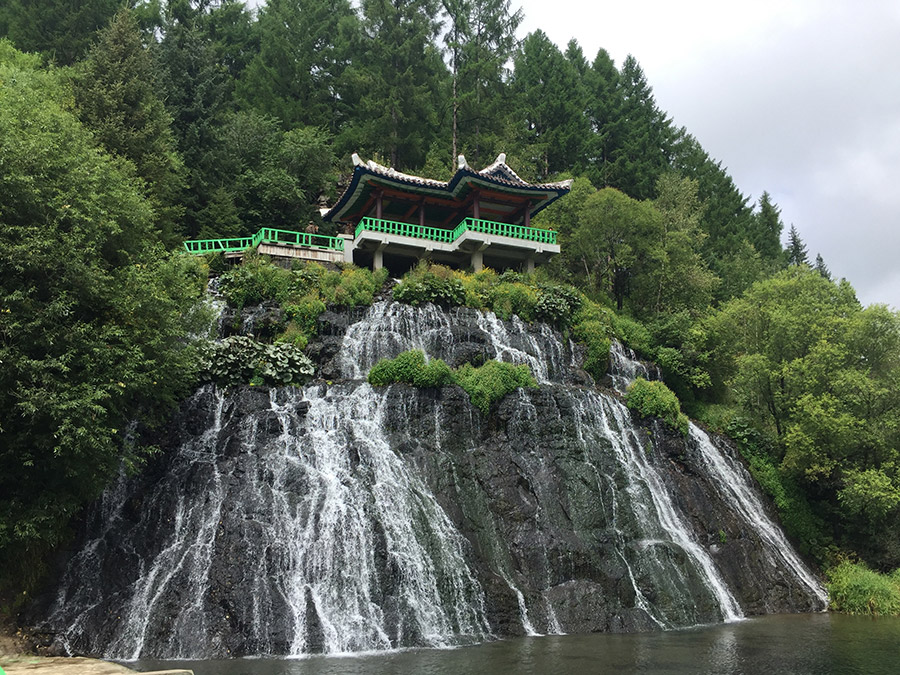
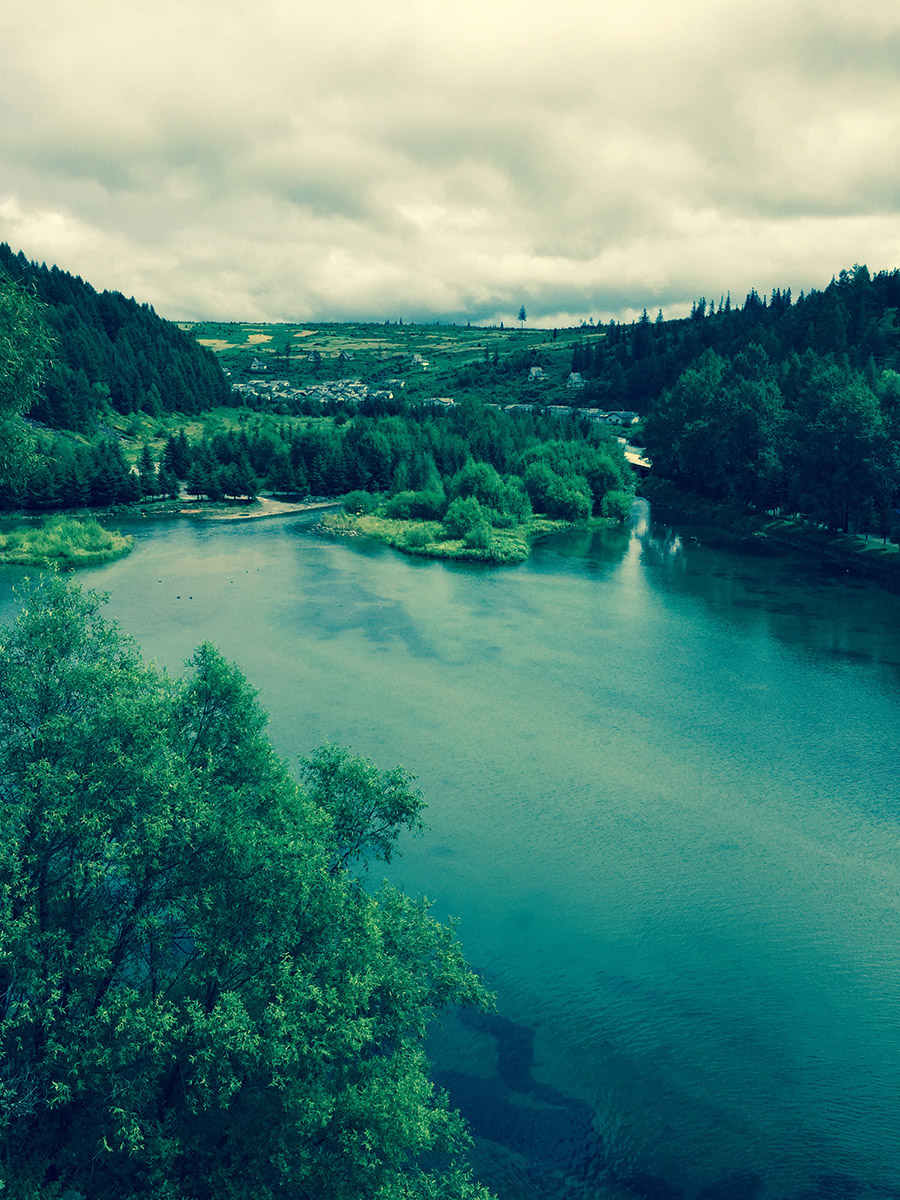
By this point I had acquired the reputation of wanting to hike up anything with a vertical incline, so I was let off the bus first to run up to the gazebo straddling the waterfall. I stepped off the bus and into a monstrous throng of hundreds of North Korean soldiers. They were having some kind of field trip fun day to the waterfall, and it was highly surreal to waltz casually and alone through the crowd. I repeatedly told myself that their boisterous shouting in Korean was something like "Hey guys! Get in the photo!" and not "White dude! Stop or I'll shoot you in the back!" as I made my way up to the gazebo.
On the deck overlooking the lake, I waved to a little North Korean boy, who looked at me quizzically. I didn't need to speak Korean to follow the boy's dad teaching him that when someone waves to you, you wave back. Even if it’s an American! This was a wonderfully human moment. Also they probably thought I was German.
From there we visited yet another pavilion of monuments, these of a young Kim Il Sung in revolutionary war hero mode:
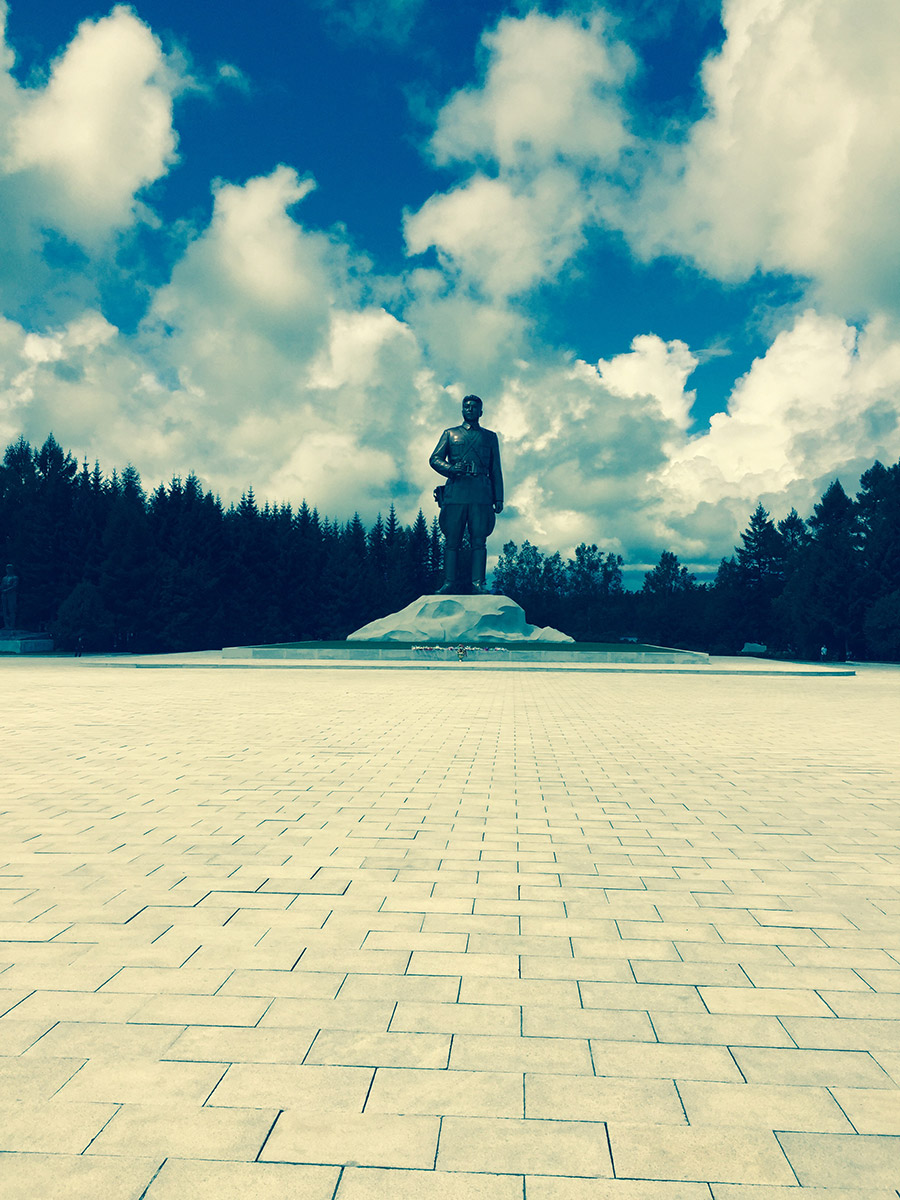
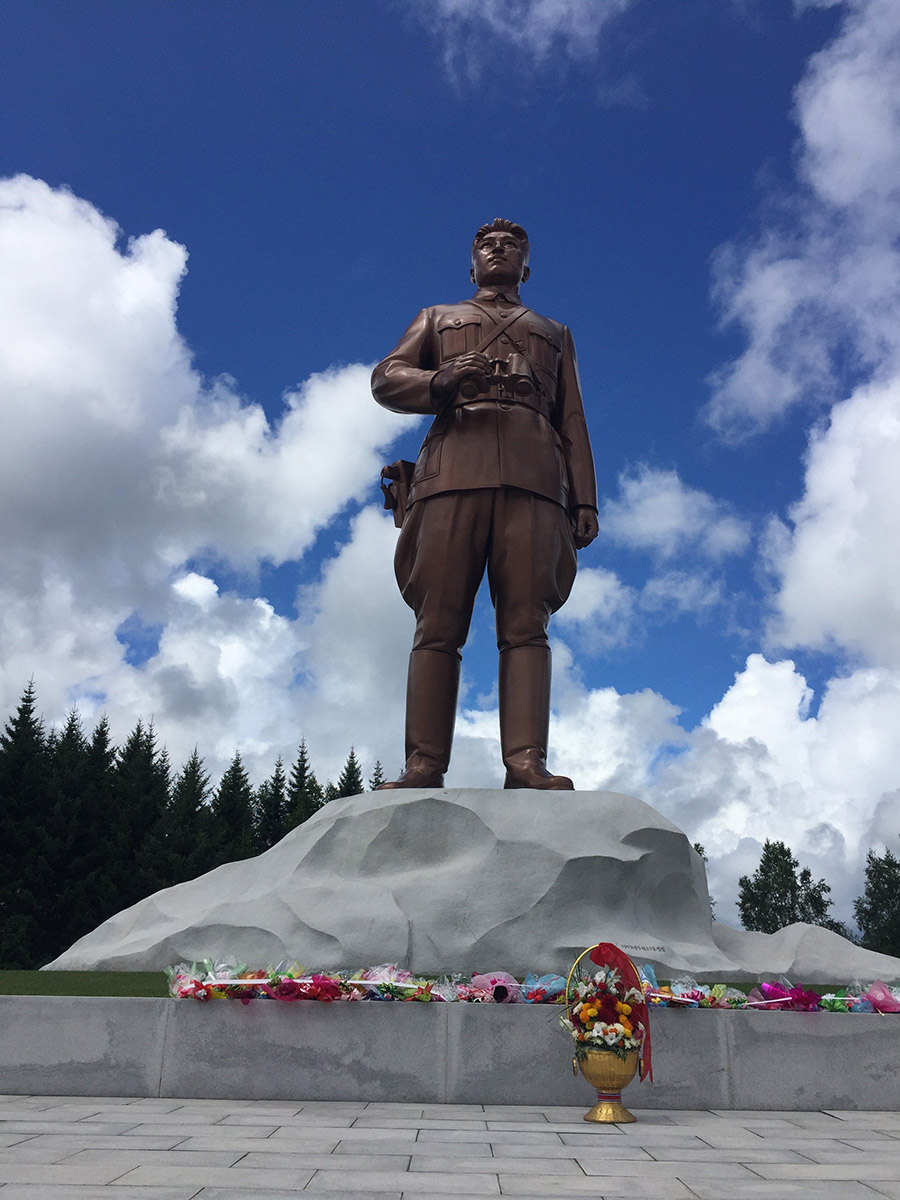

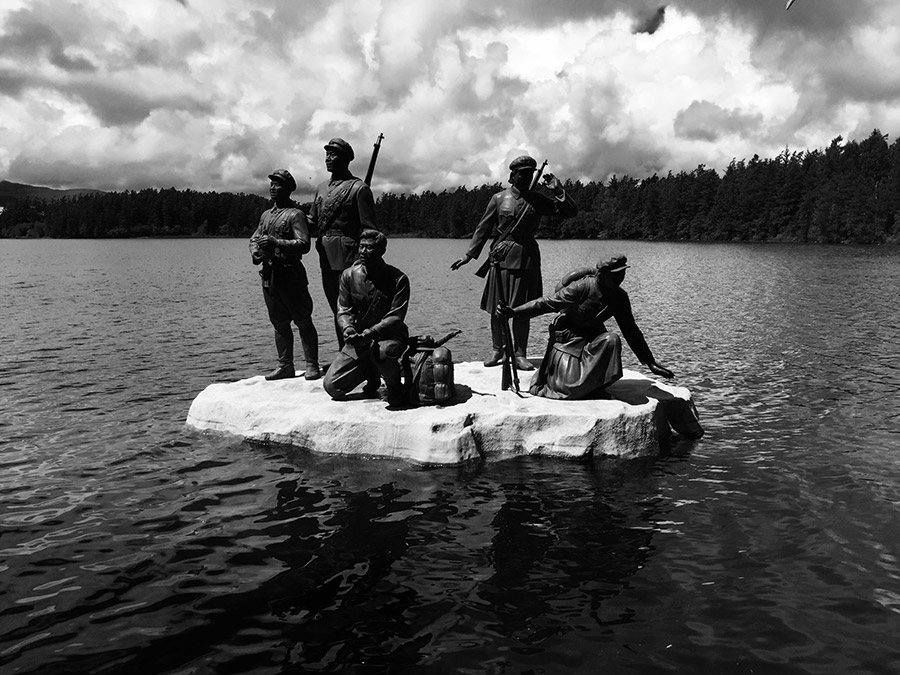
Back at the hotel, we picked at a quick lunch and picked up Julien, who had spent the morning nursing that quarter-roll of toilet paper and swearing off Korean fish forever. Time to fly back to Pyongyang.
We pulled up to Samjiyon Airport and filed into the squat little nondescript building perched at the edge of an empty runway here in the middle of the middle of nowhere. We walked by the hilarious ramshackle garden tractor that would be taking our luggage to the plane.
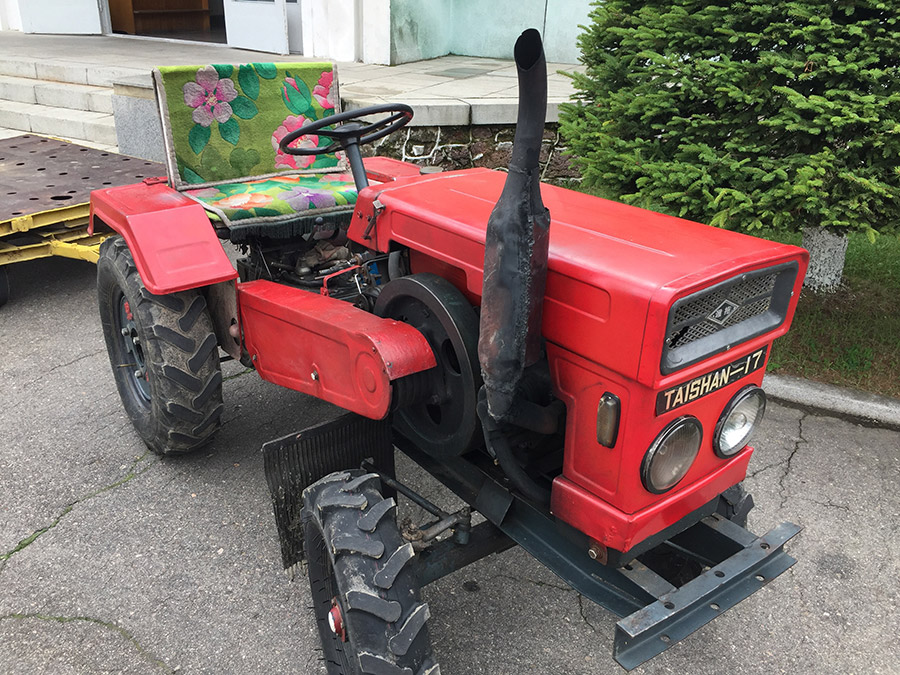
“I’m pretty sure I could weld better than that.” “I’ve never welded before in my life and I’m certain I could weld better than that.”
Inside the first of the airport’s two rooms, we waited in line to go through the security screening, which involved walking through a purely decorative metal detector before being hand-wanded by a North Korean soldier. This took, approximately, forever.
After about an hour in line I neared the soldier and watched him wand Arielle’s bag in front of me, then slowly and painstakingly take out her phone, tablet, electric toothbrush, umbrella, basically anything and everything containing any metal whatsoever. After a long inspection, he waved her through, and I handed him my bag, which contained every single metal item that Arielle had also had in her bag. He waved the wand over my bag half-heartedly for a split second and then waved me through. Okay then!
The airport’s second room was a plain box full of chairs, with large portraits of Kim Il Sung and Kim Jong Il looking down on us from high up on the wall. They were literally looking down, as the portraits were in strange frames that were much thicker on the top end, to angle the faces downward to watch over us all. A television in the corner looped a Moranbong Band performance that absolutely no one was in the mood for by this point.
In time we were freed to scamper across the open runway and climb the rickety steps onto the only plane there, our museum-piece Antonov. I ducked through the tiny doorway as the stewardess timidly gestured for me to try to not be so damned tall. Ooh, the front row is available! I hurriedly made my way to OOF- the cabin gets shorter after you pass the middle of the plane, watch your head. I sat down in the front row seat and immediately reclined straight into Julien behind me. “Sorry!” “I think you’re fine as long as you don’t recline all the wa-OW” “Yeah I can’t not recline it’s like a rocking chair.”
On the wall in front of me there was a small shelf that folded out into a little table workspace. Sweet, time to get to work on the propaganda art postcards I’d been meaning to send to everyone who didn’t want me to go to North Korea. I started writing the first one: “Please send help-” An announcement came over the intercom. It was completely indecipherable. I looked up at the ceiling and noticed the panel above us was connected by at least three completely different kinds of fasteners. This did not seem intentional.
I was on my third postcard when they told us to get off the plane. There was a vague rumor about the flight being unable to take off due to the weather. As we each carefully tiptoed down the plane’s shifting metal steps we looked up at the clouds. Certainly not suntan weather but nothing I’d ever seen stop a flight before.
Back to the airport. I’d once spent nine straight hours standing at a customer service counter at San Francisco International Airport after an incoming flight had crashed on the runway there, so I wasn’t too worried about waiting out a storm. I was slightly more concerned that we were depending on a plane that apparently couldn’t be flown in the rain. After about an hour the rain began to fall.
A North Korean airport is not the ideal place to kill time. There’s no internet. Most everyone’s phone batteries were making an empty straw sucking sound. The Moranbong Band was playing.
We spent a lot of time sitting outside and watching the rain. There were reports of a bathroom in the next building over, so I grabbed my bright yellow umbrella and headed out to find it. I walked into the building to our right, which was full of North Korean soldiers who yelled at me in Korean to go do something else other than what I was doing. Eventually I figured out that the bathroom was off in the woods back behind the airport. No lights, no soap, smells like death, I was getting used to this.
Some hours later the rain stopped and they piled us back onto the plane. Hooray! I watched as they pumped fuel into the engine on the wing near my window. That’s strange, why would they wait until now to fuel it? I noticed a green light on the side of the engine. After about ten minutes this turned off and they disconnected the fuel hose.
We taxied out onto the runway. A half an hour passed. The door at the front of the cabin opened, and the smell of cigarette smoke wafted out. People in uniforms came out. An improbable number of people in uniforms went back in. More people. I began to imagine we’d just see people enter the cockpit nonstop for a few hours, like a clown car. The intercom squeaked something no one could understand.
We heard the sound of the engines firing up. Hooray! We’re going to- I looked out my window and the propeller on my side was not spinning. Uh-oh. We taxied across the runway in an arc with one engine running and returned to the airport. Oh for fuck’s-
“We’re sorry ladies and gentlemen but due to weather we cannot take off at this time.”
Everyone wondered what they could possibly know now that they didn’t know when they had us board the plane again. We asked about this and got the impression they did not have radar or cell phones, which was probably something it was better for us not to know. The understanding I came to was that they were literally calling the next town over on the landline and asking “Is it still cloudy there? Yeah? Like, how cloudy? Real cloudy? Okay, thanks.” We piled back into the airport as it began to get dark.
An announcement was made that we’d keep attempting to take off until midnight, while in the background we could see the flight crew was clearly going home. Hmmm.
We began to discuss the likelihood that we were getting out of there that night, versus spending another night at the hotel, or even the plastic molded hospitality of the Samjiyon Airport. The French had decided there was no way in hell we were taking off tonight. This possibility raised all kinds of consequences. If we didn’t get out of Samjiyon that night, we’d never make our flight from Pyongyang to Beijing in the morning. And if we missed that flight, the next flight out of the country wasn’t for three more days. And there were no guarantees that there were even seats available on that flight, so we could very well be stuck in the DPRK for an extra week.
Okay, so that’s- oh shit, I have no way of letting anyone know where I am. I’m going to just not show up at work on Monday and everyone’s going to assume I’m stuck in jail in North Korea for stealing Kim Jong Un’s book of the world’s snazziest haircuts. My family’s going to freak. I mean, the ones I actually told I was going to North Korea. The rest of them will be fine. All of these possibilities were simultaneously troubling and hilarious.
I was the only one due at work on Monday, but everyone else had connections and other travel plans that were going to be supremely boned if we didn’t take off before midnight.
We piled back into the airport. To kill time and prevent a mass uprising they played us some of the unfinished footage our cameraman had shot of us over the course of the trip. It was more like a dated North Korean propaganda video that we had been randomly inserted into, photobomb-style, but we all applauded when familiar faces appeared in tandem with the hilarious DPRK voiceover narration.
In time the bus came back from the hotel and brought us dinner, which was very welcome by all. They’d even snuck in some soju. The Frenchmen broke out their Bluetooth speaker and Nancia christened it with The Beatles “Help!” Everyone laughed.
Vince played Leonard Cohen’s “Everybody Knows,” a very fitting choice for the DPRK.
I was put on DJ duty and followed up with an optimistic “Leaving on a Jet Plane” and slightly pissy “We’ve Got to Get Out of This Place” by The Animals. After mentally apologizing to the older folks in the room, I succumbed to my mischievous side and went straight into the Kendrick Lamar. I doubt I’ve had any more surreal moments in my life than hearing “I pray my dick get big as the Eiffel Tower, so I can fuck the world for 72 hours!” echo through a North Korean government building while portraits of the Kims looked down over us all. Oh God, life is so strange.
Our Samjiyon Airport party carried on for a few more hours, then, with midnight fast approaching, they announced that we’d be taking off. Everyone scrambled to scoop all their shit into a pile and we lined up in record time.
Our enthusiasm was slightly dampened by the absurd and seemingly arbitrary announcement that we’d have to go through security again before boarding the plane. What could we have possibly- whatever, yeah, just wand my crotch again. We’re getting out of here.
Having arrived at the airport eleven hours earlier, we walked across the runway to the plane a third time.
“Uhm, how are we going to take off in the dark? I didn’t see any lights on this runway.” “I’m sure they have lights.” “I’m virtually certain there are no lights on this runway.”
Anna from Poland expressed her deep concern that we were taking off in the dark on an unlighted runway in the mountains on a plane that can’t fly in the rain. I lied that I was sure we’d be fine.
Back onto the plane, and we were getting kind of loopy by this point. Everyone was trying on the captain’s hat we’d been afraid to touch before.
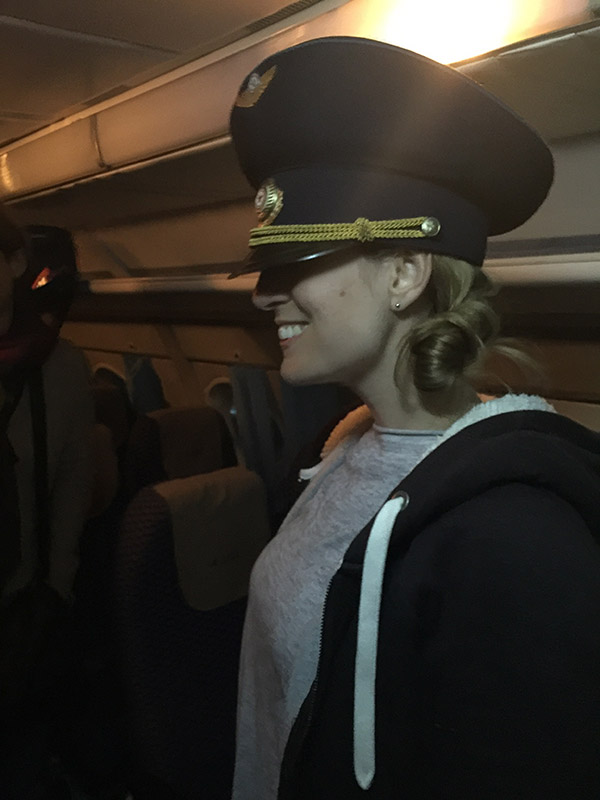
Absolutely everyone put their seat belts on this time. The fuel truck came over and they spent ten minutes pumping the engine full of fuel yet again. They disconnected the hose and the engine roared to life. A fireball suddenly shot out the back side of the engine. That’s… is that good? Airport employees waved lightsabers around in the dark.
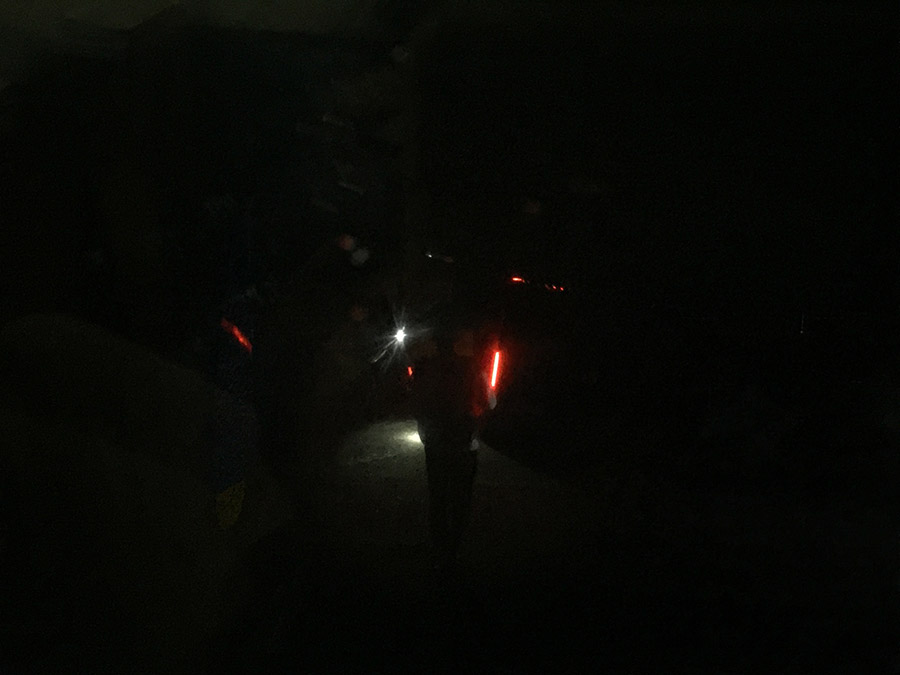
After about twenty minutes we began to taxi. No sign of runway lights. Maybe the plane has really good headlights? Maybe they’ll line the runway with employees holding glow sticks? We rolled forward in the dark, picking up speed. As we gained momentum, a bright blur went by, then another. Holy shit, they have torches lighting the runway! And I don’t mean torch in the British sense, I mean large sticks on fire. Those of us attuned to the absurd burst out laughing. The torches sticking out of the dirt along the sides of the runway blurred by as we hit top speed.
Everyone erupted in applause the second our wheels separated from the ground. Awesome. It’s really too bad it’s dark now, it was my first window seat on a DPRK flight and I was hoping to see some scenery- my body taking the cue that we were safe, I instantly and unexpectedly fell asleep with my face against the window and woke up a split second before our wheels slammed into the runway in Pyongyang. GAH! Everyone was applauding our landing. We’re back. Okay.
Walking across the runway to the airport, we turned and waved to the pilots in the cockpit, who enthusiastically waved back. Aww that’s sweet. I’m glad we didn’t all die together.
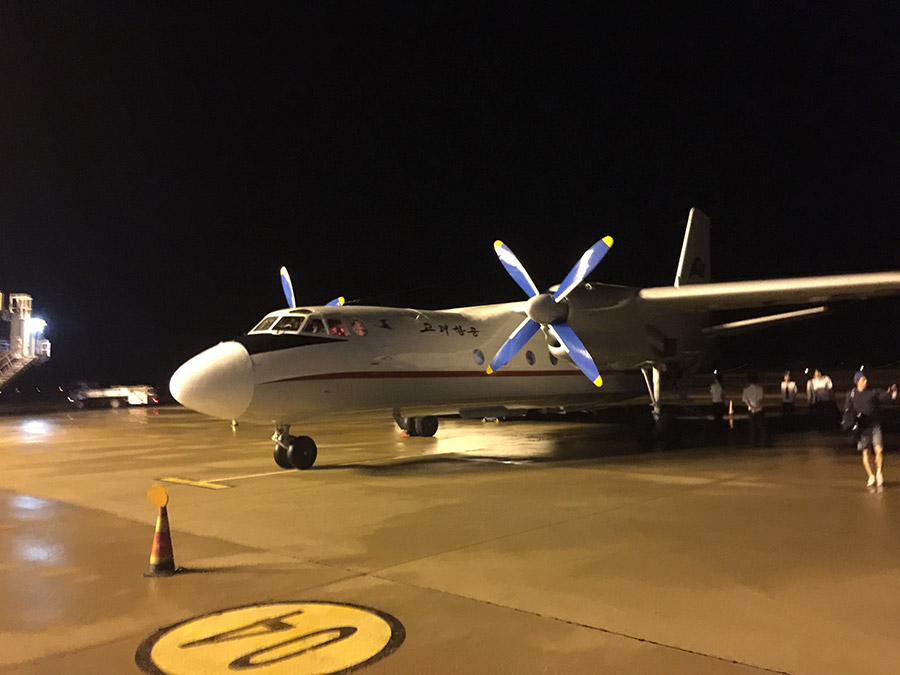
It was time for a bus back to the hotel, two hours of sleep, and then back to the airport for our flight to Beijing. I said inadequate goodbyes to our compatriots taking the train out of the country in the morning (an option Americans were forbidden from taking) and tried not to think of what a punch in the face that morning alarm would be as I fell hard into an all too brief sleep.
This has been the question I’ve been asked the most about my trip, both by eager North Korean guides hoping I’d say “We’ve had it all wrong! Our media has lied to us about your socialist utopia!” and by people back home hoping I’d tell them that North Korea has trained a purple elephant to do karate.
My honest answer? I was surprised by how much North Korea reminded me of America. Don’t mind that sound, that was just everyone in both countries rage-shitting in unison.
Don’t get me wrong, there are obvious differences, and I’m in no hurry to move to the DPRK. But for two countries that view themselves as polar opposites, I found many of the differences to just be a matter of degrees. North Korea began to feel to me almost like a satire that allowed me to see truths about the US that I’d never been able to see before.
North Korea is full of people who believe they live in objectively the greatest country in the world, forged by their near-godly founding fathers in a glorious revolution against their colonial oppressors. America... yep. Same. The vast majority of North Koreans are not allowed to travel outside of North Korea. The great majority of Americans choose not to travel outside the US. North Koreans only have access to one source of information and news: their government. Most Americans only watch one news channel or read one site or newspaper: the one that already supports their preferred worldview.
What does it mean to have freedom when you choose to live in the same box the North Koreans are forced to live in? To quote Twain, the man who does not read has no advantage over the man who cannot read.
And amazingly, I got through all of that without mentioning the crazy asshole running the country. Which country?
Having the North Korean propaganda wash over you day after day, it’s hard not to look at your own country and realize we also have far more of this than I’d ever fully realized, and it didn’t all materialize since last November. As my friend Ian from New Zealand observed, every country has a dream it sells its citizens. Some just sell harder than others. It’s easy to laugh when you find out North Korea counts their dates in years since Kim Il Sung was born. For them, this is year 106, not 2017. Ha ha, silly brainwashed North- Oh wait, our years are counted since the birth of Jesus. Hmm.
After the 100th story about how Kim Il Sung defeated the Japanese with his bare hands and taught the farmers how to plant and oh, by the way, he wrote the song you’re listening to right now, you may roll your eyes so hard you pass out. But then I started to think about George Washington and the cherry tree, the first Thanksgiving, and all the other founding legends of the United States that we were taught growing up. I remembered reciting the pledge of allegiance every morning in grade school. I thought about how saying “America is not the greatest country in the world” would be enough to get you in a fist fight in most parts of America, likely with people who have never been anywhere else.
Virtually all of the people I’ve met outside of America would laugh at you if you said their own country was the greatest in the world. How could one country even be the greatest? That’s something a child would believe. Or someone who was conditioned to not ask questions by a system that has convinced them since birth that they’ve got it the best anyone has ever had it, so how could you ever complain?
I’m 40 years old, fairly well-educated and very interested in challenging my beliefs, and yet every year I still discover things I’ve believed my entire life that are wrong. What chance does the average person have? We have more in common with those people marching in the DPRK parades than we care to admit. We all believe in things that aren’t true, we just haven’t realized what they are yet.
Several times while discussing politics with our North Korean guides, I’d hit upon a contradiction in what they’re taught to believe. They’d pause for a moment, then wave it off, or pretend they didn’t understand the question. You might feel superior for a second, before you realize that we do exactly the same thing. Ask an American why communism or socialism are bad. They don’t know, they just are. Why did 9/11 happen? They hate us for our freedom! Uh-huh. To stray from the accepted orthodoxy in a conversation in America by suggesting that our worldview is inaccurate or that our media (and not just the channels other people watch) is giving us a propaganda-tinged picture of the world is to guarantee you’re thrown into that person’s mental bin of “people with weird ideas” who are untrustworthy and not to be taken seriously, along with nuts who think the world is flat or that JFK was killed by a UFO.
Does the average American know more about the world outside their country than the average North Korean? Maybe. I’m not entirely sure that they do. I talked to North Koreans who knew where Minnesota was. I’m not sure how many Americans could place Paris on a blank map. I wouldn’t have been able to for most of my life.
America is full of people who say they hate their politicians, hate everyone who belongs to the other party, don’t like people in the other states, and don’t even like most of their own neighbors. But if you suggest to them that life might be better in one single other country in the world, look out. Americans are raised to believe we’re at the apex of human and societal evolution, regardless of any evidence to the contrary. Life in other countries that aren’t lucky enough to be America is just lesser and weird. How so? Not sure. They’re definitely not as free as us. What does that even mean? You know, freedom. Bald eagles and stuff. Wh- Go back to Berkeley, ya commie.
When other countries do it, we call it propaganda. When we do it, it’s patriotism. Criticizing any war America is involved in is a quick way to find yourself accused of being unpatriotic and of hating America. Don’t you support the soldiers?? A surprising number of people consider unquestioning blind loyalty to be a positive trait, but only in this one specific area of life.
When you ask Americans why they don’t travel abroad, most will say they can’t afford it. On one hand this is interesting because it speaks to the unconscious priorities we were raised with. A bigger house or the latest smartphone are necessities, travel is a luxury. We’re also raised to think overseas travel is far more expensive and difficult and dangerous than it actually is. But the more interesting thing to me is that these are usually the same people who believe unquestioningly in America’s superiority. But how can America be the greatest country in the world when its people can’t even afford to take a vacation? Most of the rest of the world seems to manage it just fine.
I’m fascinated by all of this because I’m no different, I’m a product of this country. I’ve believed all of these things over the course of my life. I didn’t start traveling outside of America, Canada and Mexico until I was 39. I figured, like many, that there was plenty to see in America first, and I pretty much saw it all. I wasn’t wrong, exactly, but for all the different landscapes, the deserts, the mountains, the forests, and all the regional variations in accents and attitudes, at the end of the day it’s still wall to wall America. It’s the same strip malls and Taco Bells coast to coast. The true value of getting outside of your home country is encountering people who actually think differently than you, who see the world differently. I would have thought I already had this in my life until I traveled abroad and encountered it for real.
The thought of living in another country (not counting Canada, which is just Diet America, sorry Canada!) never even seemed like a realistic possibility to me until this year. How could I ever be comfortable somewhere else? Now, the tables have turned. The more times I go away and come back, the more I see and learn, I’m noticeably less comfortable every time I come home.
Shit. What have I done?